Archived Blog Posts
National Burn Awareness Week with SERVPRO® Team Spinner and the American Burn Association
2/9/2024 (Permalink)
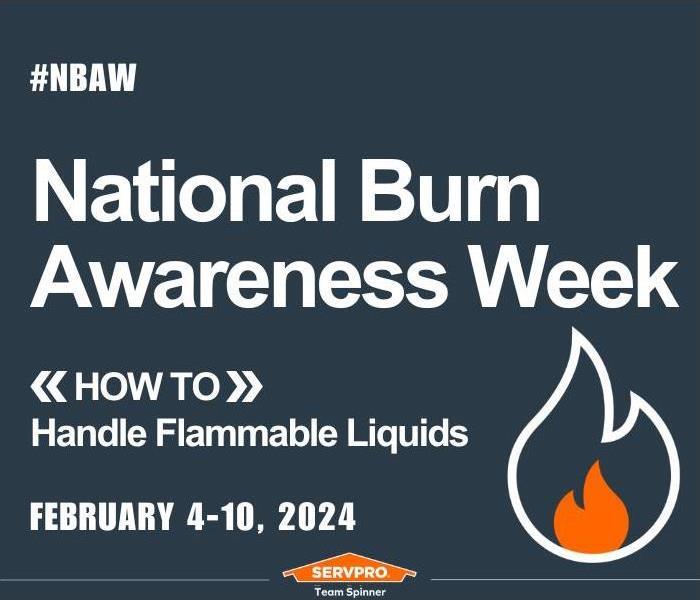 Always be mindful of how to handle flammable liquids!
Always be mindful of how to handle flammable liquids!
At SERVPRO® Team Spinner, we're committed to not only restoring properties but also promoting safety and well-being within our communities. With National Burn Awareness Week here, it's crucial to shed light on the importance of burn prevention and safety measures. Burns are not only painful injuries but can also lead to long-term physical and emotional trauma.
In this blog post, we'll explore the significance of National Burn Awareness Week and how SERVPRO Team Spinner is dedicated to spreading awareness and fostering a safer environment for all.
National Burn Awareness Week is hosted by the American Burn Association. This year's ABA theme is flammable liquids.
According to the National Fire Protection Association, Flammable and/or combustible liquids cause more than 51,000 home fire each year, resulting in 168 deaths, 1,029 injuries, and $644 million in property damage.
How do you handle flammable liquids? Handle with Care, Flammable Liquids Beware.
- Gasoline is an extremely flammable liquid and vapor with fumes capable of ignition up to 12 ft from a pooled source.
- All flammable liquid containers should be kept in cool, dry locations, and stored away from the home.
- Cooking oil is a highly flammable liquid. Keep your eyes on what you fry!
- Grills and gas ranges produce a lot of heat; keep your cooking area clear when around an open flame.
- Fuel lawnmowers, leaf blowers, and weed eaters when the engines are cool and in open area outdoors.
- Fuel snow blowers when the engines are cool and in an open area outdoors.
- Never use an accelerant such as gasoline, kerosene, or aerosol sprays to start a camp fire.
- When purchasing a gas can, be sure it has a fuel arrestor on the can to prevent flashback.
Stay tuned for additional valuable information and actionable steps to ensure safety in your homes, workplaces, and communities.
Together, we can make a difference.
Lunar New Year Firework Caution: Ensuring a Safe Celebration
2/9/2024 (Permalink)
 It's the Year of the Dragon!
It's the Year of the Dragon!
Lunar New Year, also known as Chinese New Year or Spring Festival, is a time of vibrant festivities marked by colorful parades, delicious feasts, and joyous celebrations. Fireworks are an integral part of many Lunar New Year traditions, symbolizing the ushering in of good luck and prosperity. While fireworks add to the excitement of the occasion, it's essential to prioritize safety to prevent accidents and ensure a memorable celebration. In this blog post, we'll explore important Lunar New Year firework precautions with insights from SERVPRO® Team Spinner, a trusted leader in restoration and cleanup services.
Check Local Regulations: Before purchasing or using fireworks, familiarize yourself with local regulations and restrictions. Laws regarding fireworks vary from one area to another, and it's crucial to adhere to them to avoid fines or legal consequences. SERVPRO Team Spinner advises checking with your local authorities to ensure compliance with safety guidelines.
Choose a Safe Location: Select a suitable location for setting off fireworks, away from buildings, dry vegetation, and other flammable materials. SERVPRO Team Spinner recommends using open, spacious areas such as parks or designated firework zones. Avoid firing fireworks in crowded or confined spaces to prevent accidents and injuries.
Keep Water Sources Handy: Have water sources such as buckets, hoses, or fire extinguishers readily available in case of emergencies. SERVPRO Team Spinner emphasizes the importance of being prepared to extinguish small fires or accidents quickly to prevent them from escalating.
Designate a Responsible Operator: Assign a responsible adult to handle and ignite the fireworks. This individual should be sober, knowledgeable about firework safety procedures, and capable of managing potential risks. SERVPRO Team Spinner suggests ensuring that children and bystanders maintain a safe distance from the fireworks at all times.
Follow Instructions Carefully: Read and follow the manufacturer's instructions and safety guidelines provided with the fireworks. Use fireworks only as intended and avoid modifying or tampering with them in any way. SERVPRO Team Spinner advises against attempting to relight malfunctioning fireworks and recommends disposing of them safely.
Protective Gear: Wear appropriate protective gear such as safety glasses and gloves when handling fireworks. SERVPRO Team Spinner emphasizes the importance of protecting your eyes, hands, and skin from potential sparks or debris during the firework display.
Dispose of Debris Properly: After the fireworks have been used, carefully collect and dispose of any debris or spent fireworks. SERVPRO Team Spinner recommends soaking them in water before placing them in a designated trash container to prevent accidental fires.
As you celebrate Lunar New Year with fireworks and festivities, remember to prioritize safety for yourself, your loved ones, and your community. By following these firework precautions from SERVPRO Team Spinner, you can ensure a joyful and accident-free celebration. May the Year of the Dragon be filled with prosperity, happiness, and peace. Happy Lunar New Year!
Safeguarding Your Home: Tips to Prevent or Minimize Water-Related Losses
1/29/2024 (Permalink)
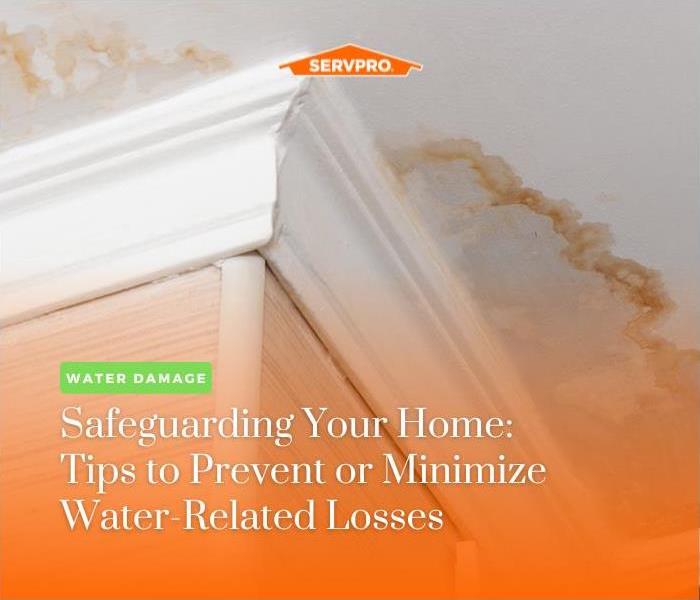 It doesn't have to rain for days for your home to have water damage
It doesn't have to rain for days for your home to have water damage
Water-related losses can have a significant impact on your home, but with proactive measures, you can prevent or minimize potential damages. At SERVPRO® Team Spinner, we're committed to helping you safeguard your property. In this guide, we'll share practical tips to protect your home from water-related losses.
1. Regular Inspections:
Stay vigilant with routine inspections of your home's plumbing, roof, and foundation. Identify and address any issues promptly to prevent potential water leaks or damage.
2. Proper Maintenance of Appliances:
Regularly inspect and maintain household appliances like washing machines, dishwashers, and water heaters. Address any leaks, worn hoses, or malfunctions to prevent water damage.
3. Adequate Ventilation:
Ensure proper ventilation in areas prone to moisture, such as bathrooms, kitchens, and basements. Good airflow helps reduce humidity levels, minimizing the risk of mold and water damage.
4. Roof Maintenance:
Regularly inspect your roof for damaged shingles, flashing, or any potential leaks. Promptly address any issues to prevent water infiltration during heavy rainfall or storms.
5. Proper Grading and Drainage:
Maintain proper grading around your home to direct water away from the foundation. Clean and clear gutters and downspouts regularly to ensure efficient water drainage.
6. Foundation Sealing:
Seal any cracks or gaps in your home's foundation to prevent water from entering. Proper sealing helps protect against basement leaks and potential structural damage.
7. Smart Landscaping:
Position plants and landscaping features to encourage proper water runoff. Avoid planting too close to the foundation, as this can contribute to excess moisture and water-related issues.
8. Monitoring Humidity Levels:
Use dehumidifiers in damp areas to control indoor humidity levels. Keeping the air dry helps prevent mold growth and reduces the risk of water damage.
9. Emergency Preparedness:
Have an emergency plan in place for water-related incidents. Know the location of shut-off valves, keep emergency contacts handy, and be prepared to act swiftly in case of a water emergency.
By implementing these preventative measures, you can significantly reduce the risk of water-related losses to your home. At SERVPRO Team Spinner, we understand the importance of proactive protection. If you do encounter water damage, our experts are here to assist in restoring your home to its pre-damage condition. Let's work together to keep your home safe and secure.
Breathe Easy: The Art of Cleaning Your Kitchen Range Exhaust System
1/24/2024 (Permalink)
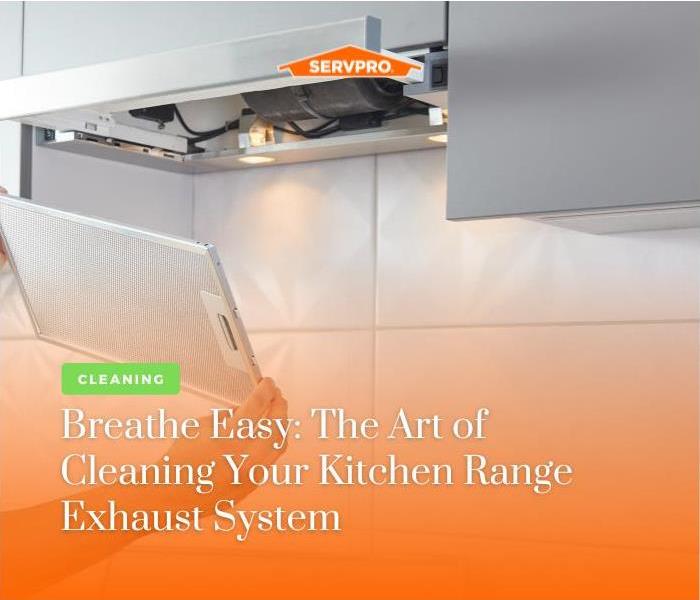 The Hidden Marvel: Your Kitchen Range Exhaust System
The Hidden Marvel: Your Kitchen Range Exhaust System
Today, let's journey into the heart of the home—the kitchen—and shine a spotlight on an unsung hero: the Range Exhaust System. Often overlooked but oh-so-important, this system plays a crucial role in keeping our kitchens clean and our air fresh. Join us as we unravel the secrets of maintaining a pristine and efficient kitchen range exhaust.
Picture this: sizzling pans, aromatic spices, and the rhythmic hum of your range hood. It's a culinary symphony! But, behind the scenes, your exhaust system is silently working to keep things clean. Over time, however, it can accumulate grease, dirt, and dust, becoming less effective and potentially posing a fire hazard.
Why Clean? The Benefits of a Sparkling Exhaust System
Improved Air Quality: A clean exhaust system ensures that smoke, odors, and airborne particles are efficiently filtered out, leaving your kitchen air fresh and clean.
Fire Prevention: Grease buildup in the exhaust system can pose a fire risk. Regular cleaning is a proactive measure to reduce this danger and keep your home safe.
Enhanced Appliance Efficiency: A clean exhaust system allows your range hood and fan to operate at peak efficiency, helping them last longer and perform better.
DIY vs. Professional Cleaning: Finding the Right Fit
While some routine maintenance tasks can be handled by the DIY enthusiast, a professional cleaning service, like the one offered by SERVPRO® Team Spinner, can ensure a thorough and comprehensive cleaning. We have the tools and expertise to tackle even the most stubborn buildup, providing peace of mind and a sparkling clean kitchen.
A Step-by-Step Guide: DIY Cleaning Tips
For those feeling adventurous, here's a quick guide to DIY kitchen range exhaust system cleaning:
Safety First: Turn off the power to the range hood to ensure safety during the cleaning process.
Remove Filters: Take out any removable filters and wash them with warm, soapy water. Let them air dry completely before reinserting.
Wipe Down Surfaces: Using a mixture of warm water and mild detergent, wipe down the interior and exterior surfaces of the range hood.
Inspect and Replace: Check for any damaged or worn-out parts, and replace them as needed.
Clean the Fan Blades: Gently clean the fan blades with a soft brush or cloth to remove dust and debris.
SERVPRO Team Spinner's Expert Touch: Bringing Professional Excellence to Your Kitchen
At SERVPRO Team Spinner, we understand the importance of a clean and safe home. Our skilled technicians go beyond surface cleaning, ensuring that every nook and cranny of your kitchen range exhaust system is thoroughly inspected and cleaned. Let us take the hassle out of maintenance, leaving you with a kitchen that's not just beautiful but also healthy.
Here's to a kitchen that breathes easy and a home that sparkles!
Navigating Biohazards
1/19/2024 (Permalink)
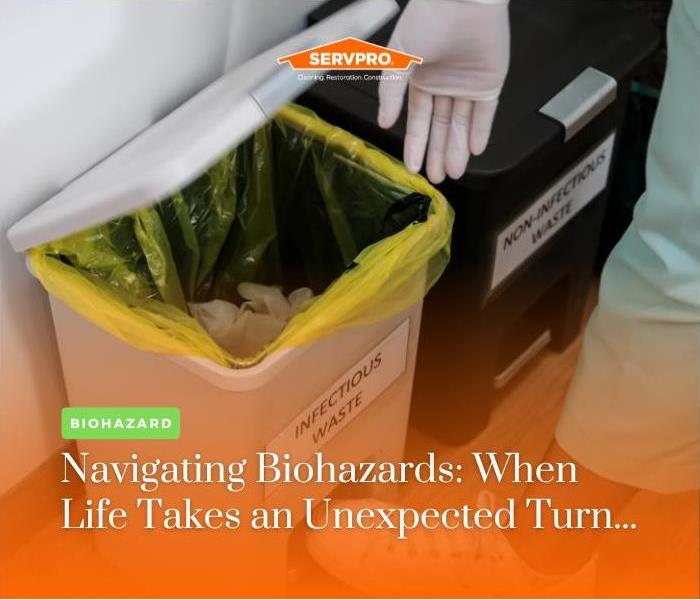 What are biohazards and why are they a problem?
What are biohazards and why are they a problem?
In the journey of life, unexpected events can sometimes throw us off course. When faced with biohazard situations, it's essential to have a trusted partner by your side. Today, we're diving into the realm of biohazards, shedding light on what they are, their potential risks, and how SERVPRO® Team Spinner can be your beacon of support during these challenging times.
Understanding Biohazards: More Than Meets the Eye
Biohazards encompass a broad range of materials that pose a threat to human health or the environment due to their biological nature. This can include blood, bodily fluids, medical waste, and more. When mishandled, these materials can lead to serious health risks, making proper cleanup crucial.
Common Biohazard Scenarios: From Cleanup to Compassion
Crime Scene Cleanup: In the aftermath of a crime, SERVPRO Team Spinner is here to provide compassionate and discreet cleanup services, ensuring that affected areas are restored with the utmost care and professionalism.
Trauma and Accident Cleanup: Accidents can happen anywhere. When they do, our experienced team is equipped to handle the cleanup, allowing you to focus on healing and recovery.
Sewage Backup: Dealing with sewage backups is not only unpleasant but also poses significant health risks. SERVPRO Team Spinner is ready to tackle the mess, ensuring thorough sanitation and restoration.
Hoarding Cleanup: Hoarding situations often involve biohazards. Our team approaches these delicate situations with empathy and expertise, creating a safe and clean living environment.
SERVPRO Team Spinner's Biohazard Cleanup: Beyond the Surface
Why choose SERVPRO Team Spinner for biohazard cleanup? It's more than just cleaning; it's about restoring lives and spaces. Our trained technicians follow strict protocols to ensure the safe and thorough removal of biohazards. We use specialized cleaning agents, personal protective equipment (PPE), and advanced techniques to bring affected areas back to a safe, habitable condition.
Compassion in Action: Your Trusted Partner in Restoration
At SERVPRO Team Spinner, we understand the emotional toll that biohazard incidents can take. Our team approaches each situation with compassion and professionalism, working tirelessly to restore your space and provide peace of mind during difficult times.
When Life Throws Curveballs, SERVPRO Team Spinner Catches Them:
Emergency Response: Available 24/7, our team responds swiftly to biohazard situations, minimizing further damage and ensuring a rapid return to normalcy.
Thorough Cleanup: Our technicians are trained to handle biohazards with precision, leaving no trace behind and restoring your property to a safe, healthy condition.
Discretion and Compassion: We understand the sensitive nature of biohazard cleanup and approach each situation with the utmost respect and empathy.
Life can be unpredictable, but with SERVPRO Team Spinner by your side, you're never alone. Here's to restoration, resilience, and a brighter tomorrow.
The Silent Threat: Understanding How Snow Can Damage Your Home
1/17/2024 (Permalink)
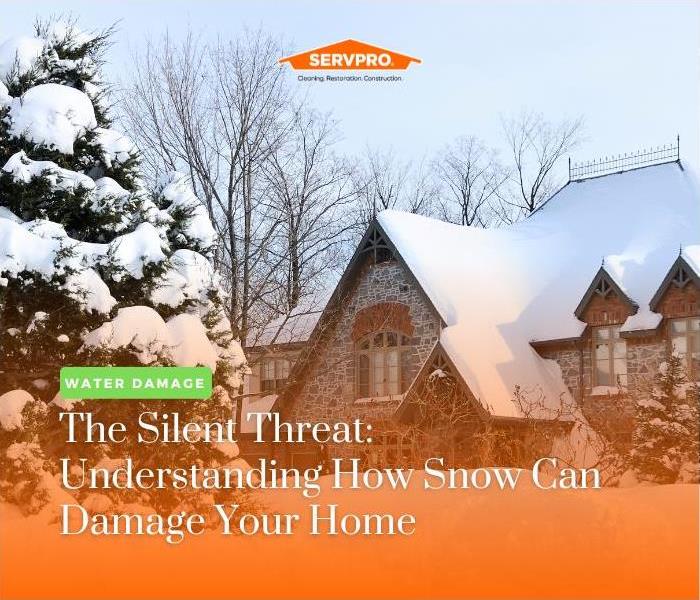 Who knew something beautiful also could be dangerous?
Who knew something beautiful also could be dangerous?
While snow-covered landscapes can be picturesque, the accumulation of snow on and around your home can pose significant risks. At SERVPRO® Team Spinner, we understand the potential damage that snow can inflict, and in this guide, we'll explore the various ways snow can compromise the integrity of your home and the importance of proactive measures to mitigate these risks.
Roof Overload:
Weight Stress: Accumulated snow can exert immense weight on your roof. This stress, especially when combined with ice and freezing rain, can lead to structural damage and even roof collapse.
Ice Dams: The melting and refreezing of snow on the roof can form ice dams. These dams prevent proper drainage, leading to water infiltration under shingles and potentially causing interior damage.
Water Damage:
Foundation Infiltration: Melting snow can seep into the soil around your foundation. As it refreezes, it expands, creating pressure that can crack the foundation and compromise its integrity.
Basement Flooding: Excessive snowmelt can overwhelm drainage systems, leading to basement flooding. This can result in extensive damage to belongings and the structural elements of your home.
Exterior Hazards:
Siding and Paint Damage: Prolonged exposure to moisture from melting snow can damage siding and paint, reducing their protective capabilities and aesthetic appeal.
Gutters and Downspouts: Snow and ice accumulation can lead to clogged gutters and downspouts, causing water to overflow and potentially damage the roof, siding, and foundation.
Preventive Measures:
Roof Inspection: Conduct regular roof inspections, especially after heavy snowfall, to identify any signs of stress or potential damage.
Proper Insulation: Ensure your attic is well-insulated to prevent heat loss, which can contribute to snowmelt and the formation of ice dams.
Gutter Maintenance: Keep gutters and downspouts clear of snow and ice to facilitate proper drainage.
Foundation Sealing: Seal any cracks in the foundation to prevent water infiltration during the melting and freezing cycles.
Landscaping Considerations: Proper landscaping can help direct water away from the foundation. Ensure the grading around your home promotes water runoff.
Snow, though beautiful, can pose a silent threat to your home's structural integrity. Vigilance, timely inspections, and preventive measures are crucial to protecting your property from potential damage. At SERVPRO Team Spinner, we're committed to helping you safeguard your home. If you find yourself facing snow-related challenges, our experts are here to assist. Let's ensure your home remains a safe and secure haven throughout the winter months.
Unmasking the Sneaky Intruder: The Harmful Effects of Mold in Your Home
1/12/2024 (Permalink)
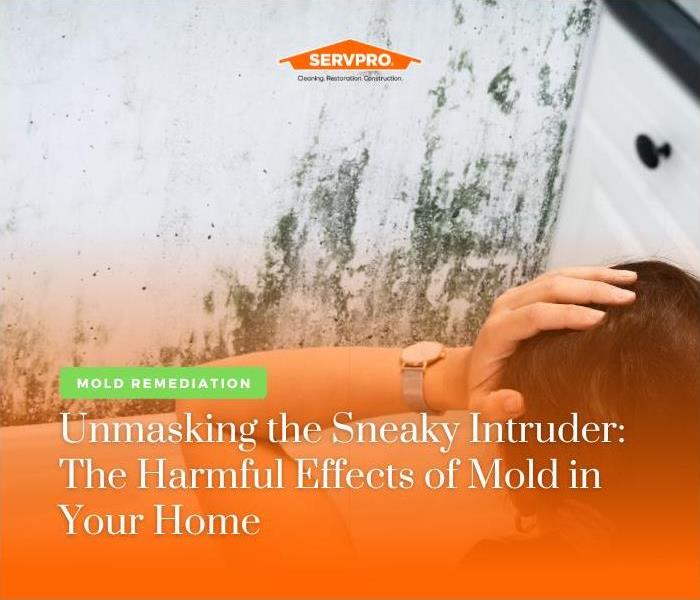 One day mold can start out small and spread to something like this
One day mold can start out small and spread to something like this
We're diving into a topic that often lurks in the shadows—MOLD. It's not just an unsightly inconvenience; it can be a silent intruder with potentially serious consequences for your home and health. Buckle up as we unravel the mystery of mold and its unwelcome effects.
Understanding Mold: The Sneaky Culprit
Mold is a stealthy organism that thrives in damp and dark environments, making our homes the perfect playground. From that seemingly innocent damp patch in the corner to the musty odor in your basement, mold can be much more than an eyesore.
Health Impact: Breathing Easy or Breathing in Trouble?
While some people may not be sensitive to mold, others can experience a range of health issues. Respiratory problems, allergies, skin irritation—mold can trigger or exacerbate these conditions. Children, the elderly, and those with compromised immune systems are particularly vulnerable.
Property Damage: Mold's Silent Mischief
Beyond health concerns, mold can wreak havoc on your home. It can compromise the structural integrity of your property, causing wood rot, weakening foundations, and damaging drywall. As if that's not enough, it's an open invitation to unwanted guests like termites.
Identifying the Culprit: Mold Detection 101
Spotting mold isn't always straightforward. It can hide in plain sight or grow in hidden corners. Musty smells, discolored walls, and water stains are potential red flags. If you suspect mold, it's time for a closer investigation.
SERVPRO® Team Spinner to the Rescue: Mold Remediation Solutions
Fear not! SERVPRO Team Spinner is your trusted ally in the battle against mold. Our expert technicians are equipped with the knowledge and tools to identify, contain, and remediate mold infestations. We don't just clean up; we restore and protect.
Prevention: A Mold-Free Future
The best defense is a good offense. Keep your home dry, fix leaks promptly, and maintain proper ventilation. Regular inspections and swift action can prevent mold from becoming a permanent resident in your space.
In the battle against mold, knowledge is power. Stay informed, be vigilant, and remember that SERVPRO Team Spinner is here to ensure your home remains a safe and healthy haven.
Cheers to a mold-free and thriving home!
Winter Storm Preparedness: A SERVPRO® Team Spinner Guide to Weathering the Snow
1/5/2024 (Permalink)
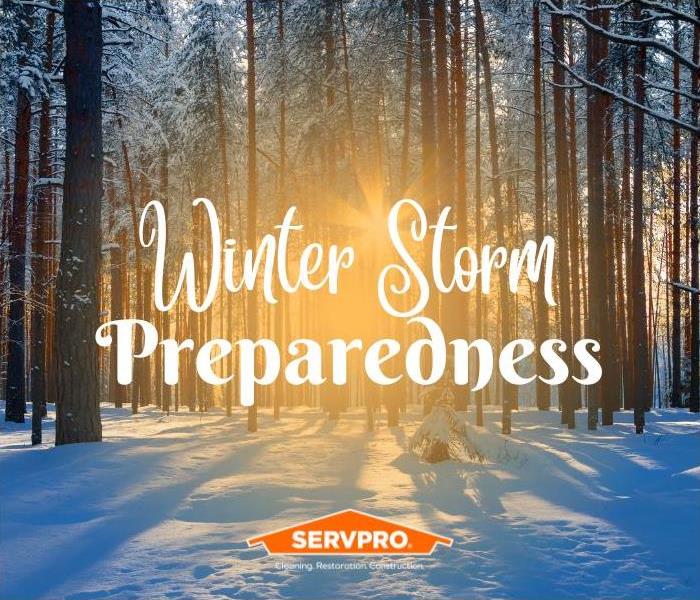 Stay warm, stay safe, and let's make this winter a season of comfort and security
Stay warm, stay safe, and let's make this winter a season of comfort and security
As winter descends upon us, it brings with it the potential for snowstorms that can impact daily life. At SERVPRO Team Spinner, we prioritize your safety and well-being. In this guide, we'll walk you through essential steps to prepare for an upcoming snowstorm, ensuring that you and your property are ready to face the challenges that winter weather may bring.
Winter Storm Preparation:
Stay Informed: Regularly check weather forecasts and updates. Stay informed about the severity and duration of the upcoming storm to make informed decisions.
Emergency Kit: Prepare an emergency kit that includes essential supplies such as non-perishable food, water, medications, flashlights, batteries, blankets, and a first aid kit.
Heating System Inspection: Schedule a professional inspection of your heating system to ensure it's operating efficiently. Replace filters and address any issues promptly.
Pipe Insulation: Insulate exposed pipes to prevent them from freezing and bursting. Use pipe insulation or heat tape for added protection.
Propane and Gas Appliances: Ensure that propane and gas appliances are in good working condition. Have an ample supply of fuel if you rely on these systems for heating.
Home Protection During a Winter Storm:
Roof Inspection: Regularly inspect your roof for signs of stress or damage. Heavy snow accumulation can lead to roof collapse, especially if there are existing issues.
Snow Removal: Safely remove snow from walkways, driveways, and the roof. Use a snow blower or shovel to prevent ice buildup and ensure safe passage.
Gutter Maintenance: Keep gutters and downspouts clear of snow and ice to prevent water backups that can lead to roof and foundation damage.
Window and Door Seals: Check and reinforce seals around windows and doors. This helps prevent drafts and keeps your home well-insulated.
Emergency Power: Consider having a backup power source, such as a generator, in case of power outages. Ensure it's in good working condition and that you have an ample supply of fuel.
Emergency Exits: Keep emergency exits clear of snow and debris. In case of an evacuation, you want unobstructed pathways.
Communication Plan: Establish a communication plan with family members, neighbors, and emergency contacts. Ensure everyone knows where to meet or how to reach each other in case of separation.
Water Damage:
Foundation Infiltration: Melting snow can seep into the soil around your foundation. As it refreezes, it expands, creating pressure that can crack the foundation and compromise its integrity.
Basement Flooding: Excessive snowmelt can overwhelm drainage systems, leading to basement flooding. This can result in extensive damage to belongings and the structural elements of your home.
After the Storm:
Inspection and Repairs: After the storm, inspect your home for any damage. Address issues promptly to prevent further deterioration.
Insurance Review: Review your home's insurance policy to ensure it covers winter-related damage. Report any damages promptly to your insurance provider.
Professional Assistance: If you encounter significant damage, seek professional assistance. Companies like SERVPRO Team Spinner specialize in storm damage restoration and can help restore your home to its pre-storm condition.
Winter storms demand careful preparation and vigilant protection measures. By following these tips from SERVPRO Team Spinner, you can fortify your home against the challenges of winter weather.
Celebrate Safely: Firework Safety Tips for a Happy New Year
1/2/2024 (Permalink)
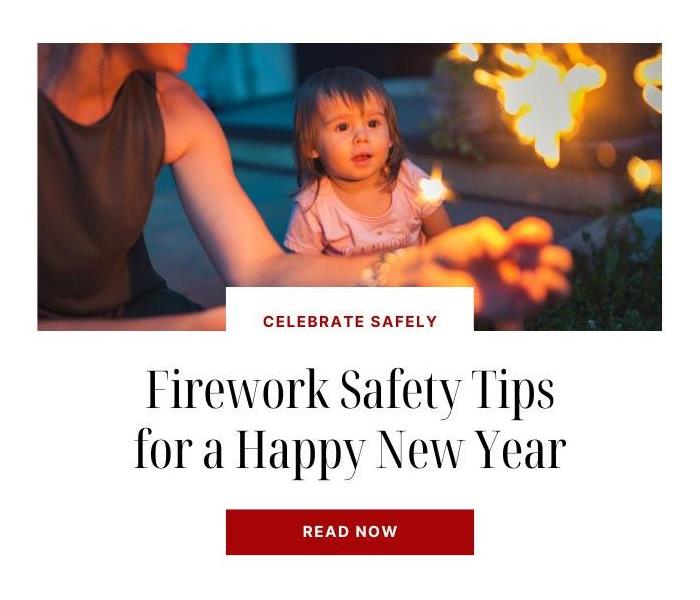 The New Year celebrations aren't over yet!
The New Year celebrations aren't over yet!
As we usher in the New Year with joy and excitement, it's essential to prioritize safety, especially when it comes to celebrating with fireworks at home. While fireworks add a dazzling touch to the festivities, mishandling them can lead to accidents and property damage. At SERVPRO® Team Spinner, we want you to have a memorable and safe New Year's celebration. In this blog post, we'll share essential firework safety tips to ensure your festivities are filled with joy and not unexpected emergencies.
Understanding the Risks:
Fireworks can pose significant risks when not handled with care. Common dangers include burns, injuries, and the potential for fires. Understanding these risks is the first step toward a safer celebration.
Legal and Safety Compliance:
Before planning a fireworks display, familiarize yourself with local laws and regulations regarding the use of fireworks. Ensure that the fireworks you choose comply with safety standards and are legally permissible in your area.
Selecting a Safe Location:
Open Space: Opt for a spacious, open area away from buildings, dry grass, and other flammable materials.
Avoid Crowded Areas: Steer clear of crowded places, and maintain a safe distance from spectators to prevent injuries.
Preparation and Planning:
Fire Extinguishers: Have a fire extinguisher and a bucket of water nearby as a precautionary measure.
Professional Displays: If possible, consider attending professional firework displays instead of setting off fireworks at home. These displays are conducted by trained experts in controlled environments.
Safe Handling Practices:
Adult Supervision: Never allow children to handle fireworks. Ensure that responsible adults are supervising the entire process.
Read Instructions: Carefully read and follow the instructions on each firework. Different fireworks have varying safety guidelines.
One at a Time: Ignite one firework at a time, and move away quickly after lighting.
No Alcohol: Avoid consuming alcohol while handling fireworks. Clear judgment is crucial for safety.
Post-Display Safety:
Dispose of Properly: Dispose of used fireworks by soaking them in water before placing them in a trash bin.
Check for Strays: After the display, check for any unexploded fireworks and properly dispose of them to prevent accidental ignition.
A safe and happy New Year's celebration is within reach with responsible firework practices. At SERVPRO Team Spinner, we wish you a joyous start to the New Year. By prioritizing safety, you can create lasting memories without compromising the well-being of yourself, your loved ones, or your property. Here's to a wonderful and safe New Year!
Kwanzaa Candle Lighting Caution: A SERVPRO® Guide to Safety
12/28/2023 (Permalink)
 Happy Kwanzaa from SERVPRO Team Spinner
Happy Kwanzaa from SERVPRO Team Spinner
Kwanzaa, a celebration of African heritage and culture, is marked by various rituals, one of which is the lighting of the Kinara. This symbolic candle holder represents the seven principles of Kwanzaa, known as the Nguzo Saba. While the lighting of the candles is a beautiful and significant part of the festivities, safety should always be a top priority. In this blog post, we'll explore essential Kwanzaa candle lighting precautions with insights from SERVPRO Team Spinner, a leading restoration and cleanup service.
Secure Placement: When placing the Kinara, ensure it is on a stable, non-flammable surface. SERVPRO Team Spinner recommends placing it away from curtains, tablecloths, or any other combustible materials. A secure placement minimizes the risk of accidental fires and enhances the safety of your Kwanzaa celebration.
Supervision and Responsibility: Never leave a lit Kinara unattended. Whether using traditional candles or modern electric lights, maintaining supervision ensures a swift response to any unforeseen incidents. SERVPRO Team Spinner emphasizes the importance of responsible candle management to prevent potential fire damage during the Kwanzaa celebration.
Keep a Clear Radius: Create a clear radius around the Kinara to prevent any accidental knockovers. Especially in households with children or pets, a little extra caution can go a long way in avoiding accidents. SERVPRO Team Spinner recommends securing the Kinara in place to minimize the risk of it being accidentally bumped or tipped.
Candle Selection: Choose candles that fit securely in the Kinara's candle holders. Loose or improperly sized candles can tilt, increasing the risk of fire. SERVPRO Team Spinner suggests using high-quality, dripless candles to reduce mess and minimize the likelihood of a fire spreading.
Keep Flammable Items Away: During the candle lighting ceremony, remove any flammable materials from the immediate vicinity of the Kinara. SERVPRO Team Spinner advises against placing paper, napkins, or any easily combustible items near the candles to avoid accidental ignition.
Emergency Preparedness: Accidents can happen even with the utmost caution. SERVPRO Team Spinner suggests having a fire extinguisher nearby and ensuring that everyone in the household is familiar with its operation. Knowing emergency exit routes and having a plan in place to evacuate the premises safely is also crucial.
Regular Maintenance: Before each use, inspect the Kinara for any signs of wear or damage. SERVPRO Team Spinner recommends cleaning the candle holders regularly to remove any wax buildup, reducing the risk of flare-ups during candle lighting.
As you celebrate Kwanzaa with family and friends, remember that safety should always be a top priority. By following these Kwanzaa candle lighting precautions from SERVPRO Team Spinner, you can ensure a festive and secure holiday season. May your Kwanzaa be filled with unity, creativity, and the glow of safely lit candles.
Defending Your Home: Identifying and Dealing with Ice Dams
12/28/2023 (Permalink)
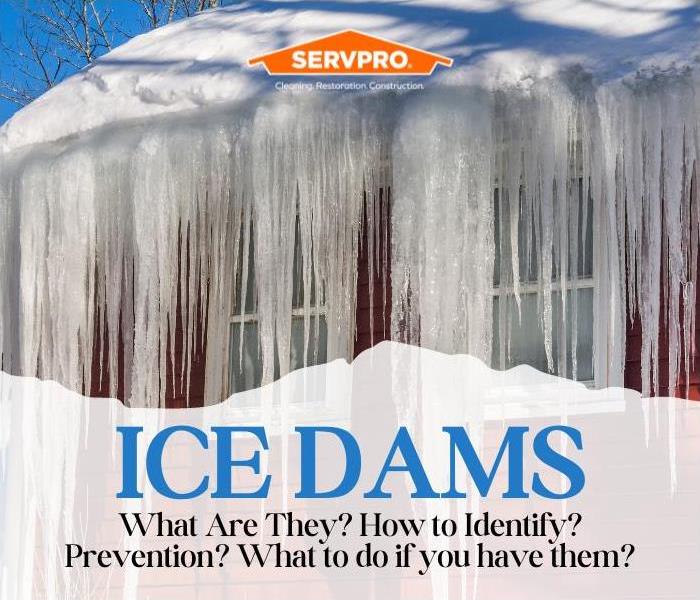 Let SERVPRO Team Spinner help you deal with your ice dams
Let SERVPRO Team Spinner help you deal with your ice dams
Winter brings a picturesque blanket of snow, but it also brings the potential for ice dams—a homeowner's wintertime nemesis. As the temperatures drop, these icy formations can wreak havoc on your roof, leading to water damage and potential structural issues. At SERVPRO® Team Spinner, we understand the importance of proactive measures to safeguard your home. In this blog, we'll delve into the identification and effective management of ice dams.
What are Ice Dams?
Ice dams are ridges of ice that form at the edge of your roof, preventing melting snow from draining properly. The combination of snow accumulation and fluctuating temperatures causes the melted water to refreeze at the roof's edge, creating a dam-like structure. As this process repeats, the dam grows, causing water to pool behind it and potentially infiltrate your home.
Identifying the Signs:
Icicles: While icicles may seem charming, they can signal potential ice dam issues. Large icicles hanging from the roof edge are indicative of melting and refreezing.
Water Stains on Walls and Ceilings: Water stains on interior walls or ceilings may suggest that melting snow is finding its way into your home. This is a clear sign that an ice dam is impeding proper drainage.
Ice Buildup in Gutters: Observe your gutters for the presence of ice. If you notice substantial ice buildup, it can contribute to the formation of dams on the roof.
Preventing Ice Dams:
Proper Insulation: Ensure your attic is well-insulated to prevent warm air from escaping and melting snow on the roof.
Ventilation: Maintain proper attic ventilation to keep the roof temperature uniform, discouraging ice dam formation.
Snow Removal: Safely remove excess snow from your roof using a roof rake. This helps eliminate the material that contributes to ice dam formation.
Dealing with Existing Ice Dams:
Professional Removal: Engage professionals, like SERVPRO Team Spinner, for safe and effective removal of existing ice dams to prevent further damage.
Avoid Chipping: Refrain from chipping away at ice dams using tools, as this can cause additional harm to your roof.
Identifying and dealing with ice dams requires a combination of preventive measures and timely action. At SERVPRO Team Spinner, we're committed to helping you protect your home. If you find yourself facing the challenges posed by ice dams, don't hesitate to reach out for professional assistance. Let's ensure your home stays warm, dry, and resilient throughout the winter months.
What to Do When Water Damage Strikes
12/19/2023 (Permalink)
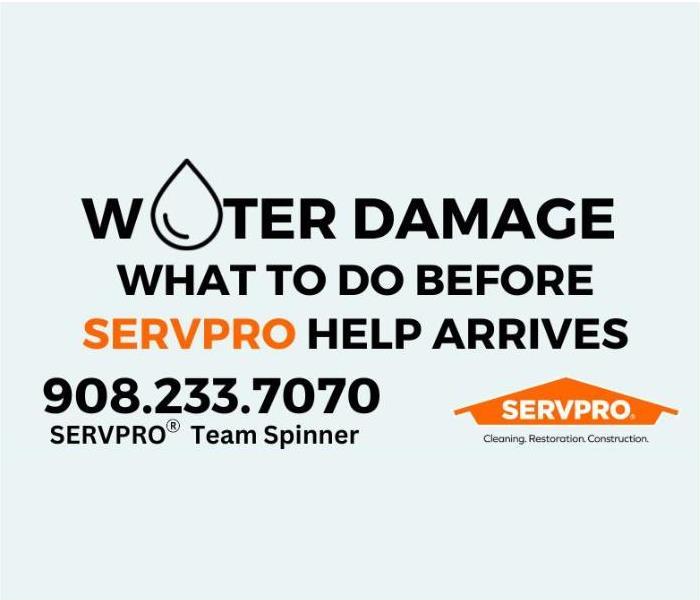 Call us at 908-233-7070 for all your water damage needs
Call us at 908-233-7070 for all your water damage needs
With the heavy rain that happened over the weekend, some homes and buildings were struck with floods.
Water damage can strike unexpectedly, turning your home or office into a stressful situation. But fear not – at SERVPRO® Team Spinner, we're here to guide you on the immediate steps to take when facing water damage. Quick and informed action can make a significant difference in minimizing the impact. Read on for our expert advice on what to do if you find yourself dealing with water damage in your house or workspace.
Safety First: Your safety is the top priority. If there's standing water and you can do so safely, turn off the electricity and gas supply to the affected area. Avoid entering rooms with sagging ceilings or wet electrical outlets.
Identify and Stop the Source: Determine the source of the water and take steps to stop it, if possible. Whether it's a burst pipe, a leaking roof, or a malfunctioning appliance, addressing the root cause is crucial to preventing further damage.
Document the Damage: Before beginning any cleanup, document the extent of the water damage. Take photos and videos of the affected areas. This documentation will be valuable when filing insurance claims.
Remove Standing Water: Use a wet/dry vacuum, mop, or towels to remove as much standing water as possible. The sooner you extract water, the less time it has to seep into structures and belongings.
Ventilate and Dehumidify: Increase ventilation in the affected area by opening windows and doors. Use dehumidifiers to reduce humidity levels, helping to prevent mold growth.
Separate and Salvage: Move belongings to a dry area to prevent further damage. Items like furniture and rugs can often be salvaged if treated promptly. Remove any wet cushions and prop them up to dry.
Contact SERVPRO Team Spinner for Professional Assistance: As water damage restoration experts, SERVPRO Team Spinner is here to help. Our professionals are equipped with the knowledge and tools to assess the damage, mitigate further issues, and restore your home to its preloss condition.
File an Insurance Claim: Contact your insurance provider as soon as possible to report the water damage. Provide them with the documentation you gathered, including photos and a list of damaged items.
Prevent Mold Growth: Mold can start growing within 24-48 hours of water damage. Promptly address damp areas and use antimicrobial cleaning agents to discourage mold growth.
Stay Informed and Prepared: Educate yourself about potential water damage risks in your home. Regularly inspect appliances, plumbing, and the roof to catch potential issues before they escalate.
Facing water damage can be overwhelming, but with swift and informed action, you can minimize the impact on your home. Remember, SERVPRO Team Spinner is just a call away, ready to assist you with professional water damage restoration services. Don't let water damage dampen your spirits – take control, and let us help you get back to a dry, comfortable environment.
Sips and Smiles: A Recap of SERVPRO Team Spinner's Hamilton Happy Hour Extravaganza
12/15/2023 (Permalink)
 Congratulations Mark Jiorle!
Congratulations Mark Jiorle!
In the heart of Hamilton, New Jersey, SERVPRO® Team Spinner recently hosted an unforgettable Happy Hour event that brought together partners, friends, and community members for an evening of laughter, camaraderie, and celebration. As the sun set and the venue came alive, SERVPRO Team Spinner opened its doors to an event that would be etched in the memories of everyone present.
Hamilton Tap & Grille set the stage for an ambiance that perfectly blended sophistication with a relaxed vibe. Nestled in the heart of Hamilton, it provided the ideal backdrop for an evening of connection and good cheer.
Beyond the laughter and libations, SERVPRO Team Spinner's Hamilton Happy Hour was a networking haven. Partners had the opportunity to connect, share experiences, and explore new avenues for collaboration. It was a testament to SERVPRO Team Spinner's belief that strong partnerships are built not only in the boardroom but also in the shared joy of celebratory moments.
The success of the Hamilton Happy Hour was, without a doubt, attributed to the incredible partners who graced the occasion. SERVPRO Team Spinner extends its heartfelt gratitude to each attendee for their presence, their shared enthusiasm, and their continued support. Our team would also like to congratulate Mark Jirole, who was representing RE/MAX, for winning our raffle of the night! We hope you enjoy your little solo stove!
As the night concluded, SERVPRO Team Spinner expressed gratitude for the community that surrounds and supports them. The Hamilton Happy Hour was not just an event; it was a celebration of partnerships, friendships, and shared successes. Looking forward, SERVPRO Team Spinner is excited about the continued journey with its partners, building on the foundation laid during this joyous evening.
SERVPRO Team Spinner's Hamilton Happy Hour was more than a gathering; it was a symphony of laughter, clinking glasses, and the celebration of strong partnerships. As the echoes of the event linger, SERVPRO Team Spinner extends its gratitude to everyone who contributed to the night's success. Here's to more shared moments, collaborative ventures, and the flourishing relationships that make events like these truly special. Cheers to our Hamilton community!
Embrace a Fresh Start with SERVPRO Team Spinner
12/13/2023 (Permalink)
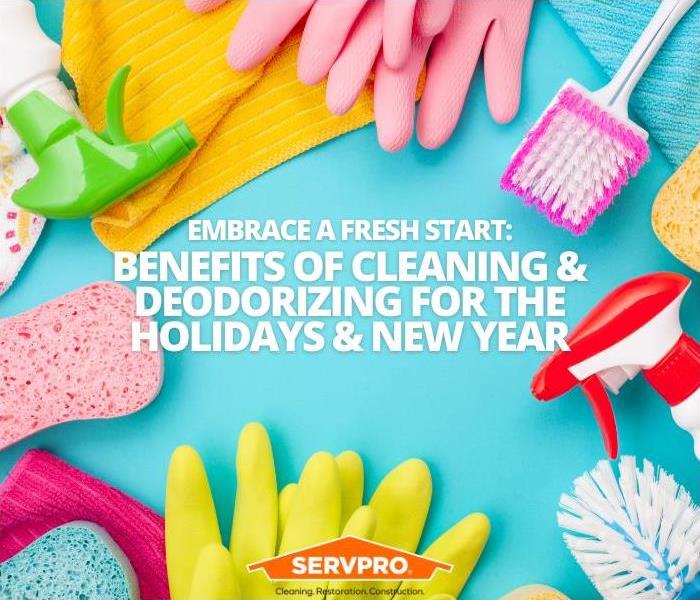 Call Us To Let The Magic Happen
Call Us To Let The Magic Happen
The holiday season is upon us, and as we bid farewell to the current year and welcome the new one, there's no better time to refresh and rejuvenate your living spaces. At SERVPRO Team Spinner, we understand the importance of a clean and inviting environment, especially during this festive time. Let's explore the myriad benefits of professional cleaning and deodorizing services to make your holidays and the upcoming year truly shine.
Create a Welcoming Atmosphere: The holidays are all about spending quality time with loved ones. Ensure your home is a warm and welcoming haven by eliminating odors and maintaining a fresh, clean ambiance. SERVPRO Team Spinner's expert cleaning and deodorizing services can transform your space, setting the stage for memorable gatherings and celebrations.
Health and Safety: A clean home is a healthy home. The holiday season often brings a surge of guests, and maintaining a hygienic environment becomes crucial. Professional cleaning not only removes dirt and bacteria but also helps mitigate allergens, creating a safer space for everyone.
Extend the Life of Your Belongings: Regular cleaning not only enhances the appearance of your home but also helps extend the life of your furniture, carpets, and other belongings. Our specialized cleaning methods at SERVPRO Team Spinner ensure that your valuables are treated with care, contributing to their longevity.
Eliminate Lingering Odors: Lingering odors can dampen the festive spirit. Whether it's the aftermath of holiday cooking or other sources, SERVPRO Team Spinner's deodorizing services target and eliminate unpleasant smells, leaving your home smelling fresh and inviting.
Prepare for the New Year: As you bid adieu to the current year, why not step into the new one with a clean slate? A professionally cleaned and deodorized space can inspire a positive mindset and set the tone for a fresh start in the coming year.
Convenience and Peace of Mind: Planning and hosting holiday events can be overwhelming. Let SERVPRO Team Spinner take the stress out of cleaning and deodorizing, allowing you to focus on what truly matters – creating lasting memories with friends and family.
This holiday season, embrace the benefits of a clean and deodorized home with SERVPRO Team Spinner. Our dedicated team is committed to making your space sparkle, ensuring you step into the new year with freshness and vitality. Schedule your service today and let the transformation begin. Cheers to a happy and healthy holiday season!
Clearing the Air: The Importance of Professional Cigarette Smoke Removal
12/1/2023 (Permalink)
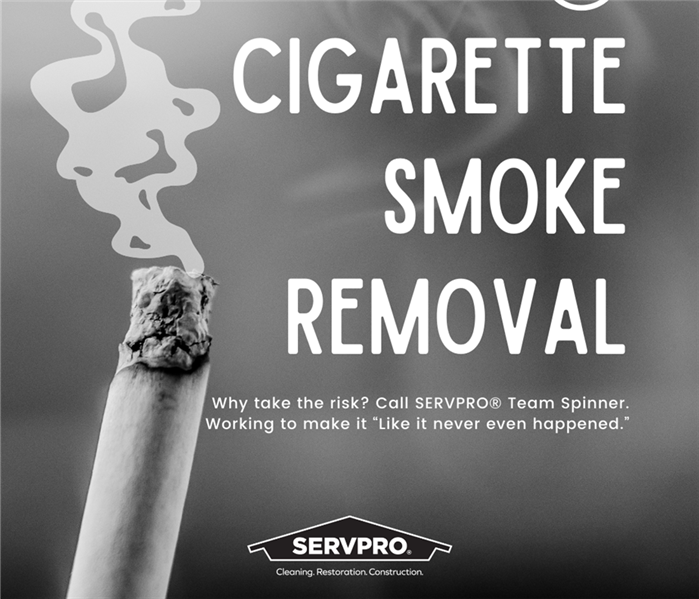 Consider contacting SERVPRO of Hamilton, South Trenton for cigarette smoke removal
Consider contacting SERVPRO of Hamilton, South Trenton for cigarette smoke removal
Cigarette smoke isn't just an unpleasant odor – it's a pervasive issue that can have long-lasting effects on indoor air quality. At SERVPRO of Hamilton, South Trenton, we understand the significance of maintaining a clean and healthy environment. In this blog post, we'll delve into the reasons why professional cigarette smoke removal is crucial for both residential and commercial spaces.
Health and Well-being: Cigarette smoke contains numerous harmful chemicals and toxins, many of which are known carcinogens. Prolonged exposure to residual smoke in indoor spaces can contribute to respiratory issues, allergies, and other health concerns. Professional smoke removal helps mitigate these risks, creating a healthier living or working environment for everyone.
Odor Elimination: Cigarette smoke has a notorious reputation for its stubborn and pervasive odor. Traditional cleaning methods often fall short in completely removing this smell. Professional smoke removal services, however, are equipped with advanced techniques and equipment designed to neutralize and eliminate lingering odors, providing a breath of fresh air.
Property Value Preservation: The smell of cigarette smoke can be a significant turn-off for potential buyers or tenants. Whether you're selling, renting, or leasing a property, investing in professional smoke removal can enhance the property's appeal, thereby preserving or even increasing its value.
Cleaner Indoor Environment: Cigarette smoke particles can settle on surfaces, creating a layer of residue commonly referred to as "third-hand smoke." This residue can be challenging to remove without professional intervention. Smoke removal services not only address the visible effects but also ensure a thorough cleaning of surfaces, contributing to an overall cleaner indoor environment.
Compliance with Regulations: In some jurisdictions, there are regulations and guidelines regarding indoor air quality and smoking in public or shared spaces. Ensuring your property meets these standards is not only responsible but can also save you from potential legal issues. Professional smoke removal services help you stay compliant and create a safe environment for everyone.
Improved Aesthetic Appeal: Smoke stains can discolor walls, ceilings, and other surfaces, giving spaces a dingy and unappealing look. Professional smoke removal restores the aesthetic appeal of your property by addressing not only the odor but also the visual impact of cigarette smoke damage.
Investing in professional cigarette smoke removal goes beyond just eliminating a smell; it's about creating a healthier, more inviting space. At SERVPRO of Hamilton, South Trenton, we prioritize the well-being of our community and their environments. Contact us today to experience the transformative power of our smoke removal services – because everyone deserves to breathe in a clean and fresh atmosphere.
Guardians of the Pipes: Protecting School Plumbing Systems During the Holidays
11/28/2023 (Permalink)
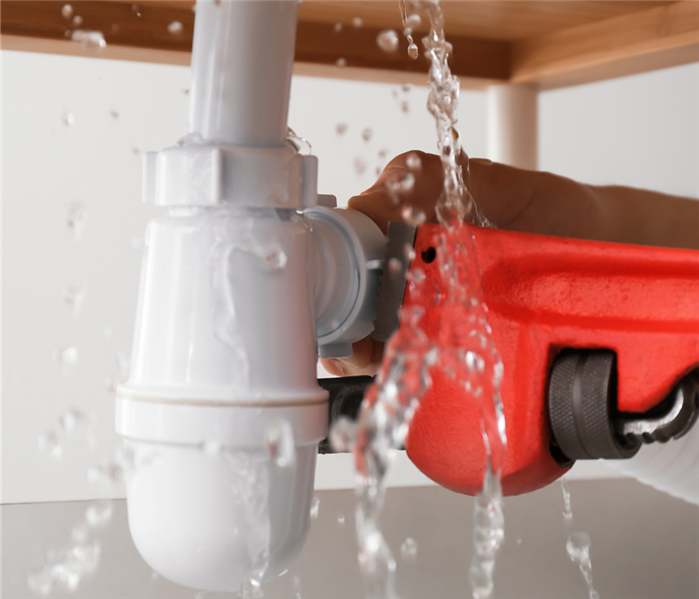 Don't start the new year with a flooded school!
Don't start the new year with a flooded school!
As schools prepare to close their doors for the holiday season, it's crucial to turn attention to one of the often overlooked aspects of facility management – the plumbing system. A dormant school building can pose challenges for plumbing if not properly prepared. SERVPRO Team Spinner, with its expertise in restoration and cleanup, offers valuable insights on how to safeguard school plumbing systems during the holidays.
1. Conduct a Thorough Inspection: Before the school doors are locked for the holidays, conduct a comprehensive inspection of the plumbing system. Look for leaks, drips, or any signs of wear and tear. Addressing issues preemptively can prevent small problems from turning into major disruptions.
2. Ensure Proper Insulation: As temperatures drop, it's essential to ensure that exposed pipes are adequately insulated. This safeguards against freezing, which can lead to pipe bursts and water damage. Pay special attention to areas that might not receive sufficient heating, such as basements and attics.
3. Run a Full Flush: Encourage the maintenance staff to perform a full flush of all toilets and run water through all faucets. This helps prevent sediment build-up, ensures water circulation, and keeps the traps filled to prevent sewer gases from entering the building.
4. Set Thermostats Appropriately: Maintain a minimal level of heating in the building to prevent freezing. While it might be tempting to save on energy costs, allowing the temperature to drop significantly can result in frozen pipes and subsequent water damage.
5. Shut Off Unnecessary Water Sources: Identify and shut off water sources that aren't essential during the holidays. This includes irrigation systems, outdoor faucets, and any other non-essential water supply. By reducing the overall pressure on the plumbing system, the risk of leaks or bursts is minimized.
6. Establish Emergency Protocols: In the event of an unexpected plumbing issue, having clear emergency protocols in place is crucial. Ensure that staff members know how to locate shut-off valves and are aware of the steps to take in case of a water-related emergency.
7. Partner with Professionals: Consider consulting with plumbing professionals or restoration experts like SERVPRO Team Spinner. Their experience in dealing with water damage can provide valuable guidance and proactive solutions to fortify the plumbing system against potential risks.
Protecting a school's plumbing system during the holidays requires a combination of proactive measures, thorough inspections, and a keen awareness of potential vulnerabilities. By implementing these steps, schools can ensure that they return to a fully operational and undamaged plumbing system when the doors reopen. SERVPRO Team Spinner stands ready to assist with any unforeseen water-related challenges, emphasizing the importance of a collaborative effort to keep school facilities safe and secure during the holiday break.
After all, we aim to make it "Like it never even happened."
SERVPRO Team Spinner Spins into Action for Hamilton NJ Police Athletic League
11/22/2023 (Permalink)
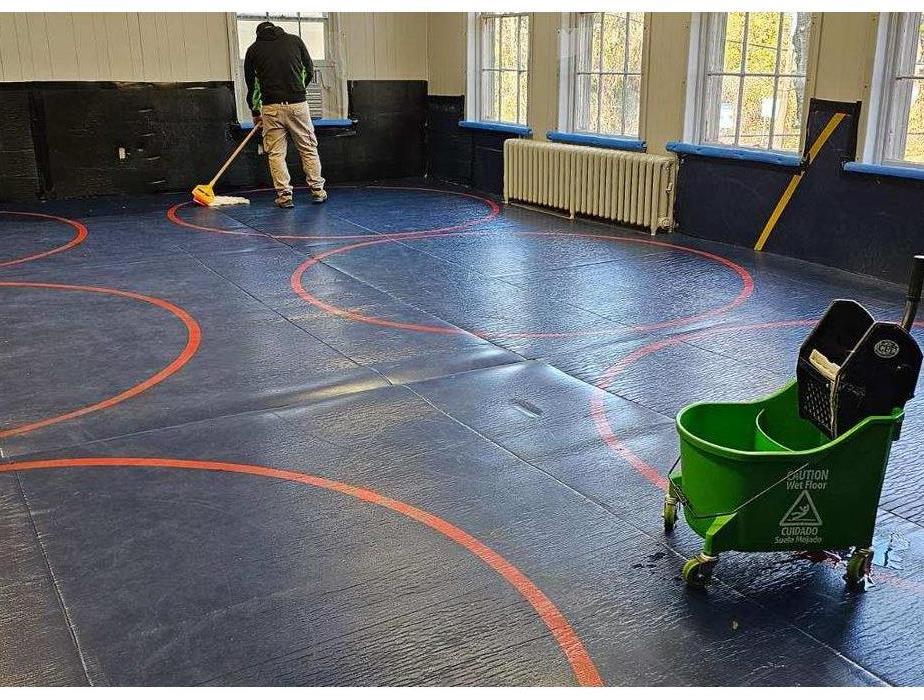 SERVPRO Team Spinner cleaning up for our Hamilton community
SERVPRO Team Spinner cleaning up for our Hamilton community
On Thursday, November 16, 2023, in the spirit of community and giving back, SERVPRO Team Spinner recently embarked on a special mission with a heartwarming twist. Recognizing the importance of supporting local organizations, the team decided to lend a helping hand to the Hamilton Police Athletic League (PAL) by offering their expertise in a unique and generous way.
The focus of this community initiative was none other than the mats at the Hamilton PAL facility. Understanding the wear and tear these mats endure from the active and spirited activities of the young athletes, the SERVPRO Team Spinner saw an opportunity to contribute their cleaning prowess.
What makes this initiative truly special is that SERVPRO Team Spinner decided to provide their cleaning services free of charge. This gesture exemplifies their commitment to supporting the community that has been an integral part of their journey. By stepping in to assist the Hamilton PAL, SERVPRO Team Spinner not only demonstrated their dedication to maintaining a clean and healthy community but also highlighted the power of collaboration and support among local businesses and organizations.
The freshly cleaned mats not only contribute to the overall well-being of the young athletes but also showcase the positive ripple effect that acts of kindness and generosity can have within a community. SERVPRO Team Spinner's commitment to service goes beyond their professional duties, reflecting a genuine desire to invest in the welfare of their neighbors.
As the freshly cleaned mats at the Hamilton PAL stand as a testament to SERVPRO Team Spinner's commitment to community service, it's a reminder that small acts of kindness can make a significant impact. The collaboration between SERVPRO Team Spinner and the Hamilton PAL showcases the positive outcomes that arise when businesses and organizations join forces for the greater good. Here's to more partnerships that build strong, resilient communities!
Giving Thanks Safely: SERVPRO Team Spinner's Thanksgiving Safety Guide
11/22/2023 (Permalink)
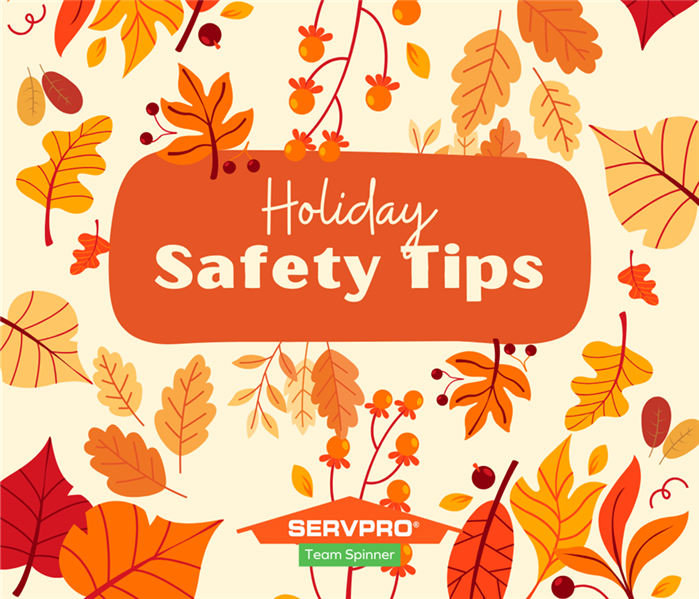 Wishing you a safe and joyful Thanksgiving,
SERVPRO Team Spinner
(908) 233-7070
Wishing you a safe and joyful Thanksgiving,
SERVPRO Team Spinner
(908) 233-7070
As the Thanksgiving holiday approaches, the aroma of delicious meals and the warmth of family gatherings fill the air. At SERVPRO Team Spinner, we want to ensure that your Thanksgiving is not only filled with gratitude and joy but also with safety and preparedness. Here are some essential tips to keep your celebrations accident-free:
1. Fire Safety Precautions: Thanksgiving often involves a lot of cooking, and safety in the kitchen is paramount. Double-check your smoke detectors to ensure they are working correctly. Avoid kitchen distractions, and never leave the stove or oven unattended. If deep-frying a turkey, do it outdoors, away from structures, and keep a fire extinguisher handy.
2. Deep-Frying Safety: For those opting for the crispy delight of a deep-fried turkey, take extra precautions. Thaw the turkey completely, pat it dry, and ensure the fryer is on a flat surface. Keep the fryer a safe distance away from your home, and never leave it unattended. Also, be cautious of the oil temperature to prevent spills and flare-ups.
3. Mindful Disposal of Cooking Byproducts: Avoid clogged drains by being mindful of what goes down the sink. Dispose of cooking grease in a designated container rather than pouring it down the drain, as it can solidify and cause blockages. Use strainers in sinks to catch food scraps and prevent plumbing issues.
4. Emergency Preparedness Kit: In the spirit of preparedness, have an emergency kit ready. Include essential contacts, insurance information, and any necessary medications. Having these items readily available ensures a swift response in case of unforeseen circumstances.
5. Home Security Measures: If you plan on traveling for the holiday, take steps to secure your home. Lock all doors and windows, set alarms if available, and consider asking a trusted neighbor to keep an eye on your property. A secure home allows you to enjoy your Thanksgiving without worry.
Thanksgiving is a time for joy, reflection, and connection. By incorporating these safety tips into your holiday preparations, you can ensure a celebration that is not only memorable but also safe for everyone involved. From all of us at SERVPRO Team Spinner, have a happy and secure Thanksgiving!
Safety First: Why Frying Turkey Can Pose Thanksgiving Hazards
11/15/2023 (Permalink)
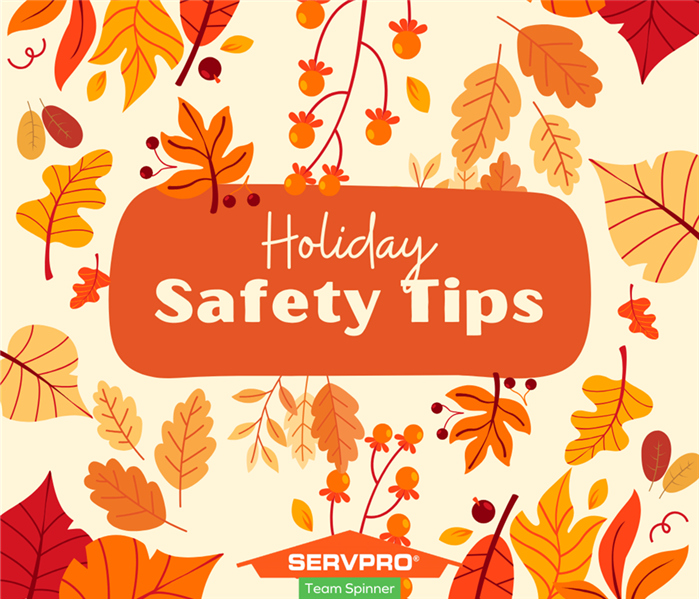 Holiday Safety Tips from SERVPRO Team Spinner
Holiday Safety Tips from SERVPRO Team Spinner
Thanksgiving is a time for family, gratitude, and of course, delicious food. While many embrace the tradition of roasting a turkey in the oven, the trend of deep-frying turkeys has gained popularity in recent years. At SERVPRO Team Spinner, our commitment to community safety prompts us to shed light on the potential hazards associated with deep-frying turkeys and to encourage a Thanksgiving celebration that prioritizes safety.
Risks of Deep-Frying Turkey:
Fire Hazard: Deep-frying a turkey involves immersing it in hot oil, creating a potential fire hazard. The oil can overheat, leading to a dangerous situation. According to the National Fire Protection Association (NFPA), turkey fryers are responsible for numerous fires each year, causing significant damage to homes and properties.
Hot Oil Burns: Handling hot oil poses a serious risk of burns and injuries. The process of lowering a turkey into boiling oil requires caution and precision. Accidents can happen when individuals are not familiar with the proper safety measures or when equipment is not used correctly.
Lack of Experience: Deep-frying a turkey requires a certain level of expertise and experience. Individuals attempting it for the first time may underestimate the potential dangers involved, leading to accidents that could have been avoided with proper knowledge and preparation.
SERVPRO Team Spinner's Safety Tips:
Choose Safety Over Speed: While deep-frying may offer a quicker cooking time, it's essential to prioritize safety. Consider alternative cooking methods that eliminate the risk of hot oil and open flames.
Maintain a Safe Distance: If you choose to fry your turkey, ensure the fryer is set up a safe distance from structures, including your home. An outdoor, flat, and stable surface is crucial to prevent accidents.
Thaw the Turkey Completely: Thoroughly thaw the turkey before frying to prevent oil splatters and reduce the risk of fire. Ice or water on an unfrozen turkey can cause the hot oil to bubble and splatter.
Never Leave Unattended: Supervise the turkey fryer at all times. Leaving it unattended increases the risk of accidents and potential disasters.
At SERVPRO Team Spinner, we prioritize the safety and well-being of our community. As you prepare for Thanksgiving, consider the potential risks associated with deep-frying a turkey. Opt for safer cooking methods to ensure a joyous and incident-free holiday celebration. Let's make this Thanksgiving a time of gratitude and happiness, without compromising the safety of our loved ones and homes.
Shine Bright, Stay Safe: Diwali Fire Caution from SERVPRO Team Spinner
11/14/2023 (Permalink)
 Happy Diwali from SERVPRO Team Spinner!
Happy Diwali from SERVPRO Team Spinner!
Diwali, a joyous festival of lights, was on Monday, November 13. Unfortunately, during this festive holiday, a fire is not an uncommon occurrence.
The team at SERVPRO wants to share some important fire safety precautions to ensure your celebrations remain bright and safe for next year or for anyone celebrating later this week.
Diwali is a time for family, friends, and beautiful decorations, but it's crucial to be mindful of potential fire hazards. Here are some tips to keep your Diwali festivities safe and enjoyable:
Inspect Electrical Decorations: Before decking out your home with colorful lights and electronic decorations, carefully inspect each item for frayed wires, damaged sockets, or any signs of wear. Replace any damaged items to prevent electrical fires.
Avoid Overloading Outlets: Distribute your electrical load evenly and avoid overloading outlets. Plugging too many devices into a single outlet can lead to overheating and increase the risk of a fire.
Use LED Lights: Opt for LED lights over traditional incandescent ones. LED lights produce less heat, reducing the risk of fire. Additionally, they are more energy-efficient and have a longer lifespan.
Keep Flames in Check: If you include traditional diyas or candles in your celebrations, ensure they are placed in stable holders and are kept away from flammable materials. Never leave lit candles unattended.
Maintain Safe Distances: Keep decorations, including curtains, drapes, and other combustible items, away from heat sources and open flames. Maintain a safe distance to prevent accidental fires.
Supervise Fireworks Displays: If fireworks are a part of your Diwali tradition, exercise caution and follow local safety guidelines. Ensure that fireworks are lit in open areas, away from buildings and dry vegetation.
Keep Fire Safety Equipment Handy: Have fire extinguishers and smoke detectors in strategic locations within your home. Regularly check and maintain these devices to ensure they are in good working condition.
Create an Emergency Plan: In the event of a fire, have a well-thought-out emergency plan in place. Ensure that all family members are aware of the evacuation routes and meeting points.
Dispose of Ashes Safely: If you use fire pits or burn incense during Diwali, ensure that ashes are fully extinguished before disposal. Dispose of ashes in a metal container, away from combustible materials.
Stay Informed: Keep yourself informed about local fire safety regulations and guidelines. Understanding and following these regulations is crucial to ensuring a safe and enjoyable Diwali.
At SERVPRO Team Spinner, your safety is our priority. We wish you a Happy and Safe Diwali filled with light, laughter, and moments of joy. Shine on, and let's celebrate responsibly!
A Night to Remember: SERVPRO Team Spinner Happy Hour Event Recap
11/1/2023 (Permalink)
 Happy Hour event for our partners at Galloping Hills
Happy Hour event for our partners at Galloping Hills
When it comes to celebrating our strong partnerships, there's no better way to do it than with good company, great food, and delicious drinks. At our recent SERVPRO Team Spinner Happy Hour event on October 26, 2023, we had the pleasure of hosting our valued partners, and it was a night filled with laughter, camaraderie, and memories we will cherish for years to come. Continue reading as we take you through the highlights of this unforgettable evening.
Since this was our first time hosting an event like this at SERVPRO Team Spinner, we wanted to be able to have a cozy setting with enough space to have our sales and marketing team interact with the partners they invited. We hosted the event at the Galloping Hill Golf Course indoor venue. The weather was perfect to step outside and enjoy the views of the golf course.
Waves of our partners came and went and there was endless chatter at every corner you looked. Our event was from 4 p.m. to 7 p.m. – why do we call it happy “hour?” – and all our guests were entertained every minute of the hours, whether it be with food, drinks, or the people.
The heart of any happy hour is, of course, the beverages, and our guests were treated by SERVPRO Team Spinner to a variety of signature cocktails, craft beers, and exquisite wines the Galloping Hill had to offer. From classic martinis to unique mixes created just for the occasion, everyone had a chance to raise a toast to the bonds we have formed. Some interesting drinks to try the next time someone goes there would be the Spicy Pineapple Marg or their B Side-Tini. Tasty food is a universal language, and our SERVPRO Team Spinner Happy Hour did not disappoint. An array of mouthwatering appetizers kept everyone fueled and satisfied throughout the evening.
One of the primary objectives of the evening was to thank our partners for connecting with us. Our guests engaged in lively discussions, shared experiences, and explored opportunities for future collaborations. It was a perfect setting to discuss business in a relaxed and friendly environment.
Thank You to Our Partners. The SERVPRO Team Spinner Happy Hour event would not have been the same without the presence of our dedicated partners. We want to express our heartfelt gratitude for your ongoing support, trust, and commitment. Together, we have achieved so much, and we look forward to even greater successes in the future.
Our SERVPRO Team Spinner Happy Hour event was not just an evening of entertainment; it was a celebration of partnership, collaboration, and shared goals. As we look back on the memories created during this special night, we are reminded of the strength and vitality of our relationships with our partners. Here is to many more joyful gatherings, successful endeavors, and cherished moments in the future.
Thank you to all who attended our SERVPRO Team Spinner Happy Hour event. We're excited to host our next SERVPRO Team Spinner Happy Hour event again, this time in Hamilton, NJ!
A Fang-tastic Halloween at SERVPRO Team Spinner
11/1/2023 (Permalink)
 SERVPRO Team Spinner ready to give treats to our community
SERVPRO Team Spinner ready to give treats to our community
Halloween is a time for ghoulish delights and spooky surprises, and at SERVPRO Team Spinner, we continue to care for our local community. We had the privilege of seeing the kids from Kohler Academy for a morning filled with laughter, costumes, and a whole lot of treats. It was a day to remember, not just for the children but for our entire team, as we experienced the true essence of community engagement.
At SERVPRO Team Spinner, we believe in giving back to the communities we serve. It is not just about cleaning and restoration; it's about building relationships and fostering a sense of togetherness. Our commitment to community engagement has been a core value for us, and events like this one exemplify that commitment.
We set the scene by bringing a table out to the street and transformed it with spooky decorations. The excitement was palpable as the children from Kohler Academy arrived, their faces painted with glee and anticipation. Of course, what's Halloween without costumes? Both our team and the kids from Kohler Academy donned some incredible costumes. From iconic barbies to adorable superheroes, the diversity of costumes added to the festive spirit of the day. There were smiles all around, as everyone embraced the opportunity to express themselves in their chosen characters.
The highlight of the event was undoubtedly the smiles on the children's faces. Their laughter and joy filled our office, serving as a reminder of the importance of these moments in building a strong and connected community. It was an incredible feeling to provide a safe and fun environment for these kids to enjoy their Halloween.
The Halloween event with the kids from Kohler Academy at SERVPRO Team Spinner was an incredible experience. It showcased the power of community engagement, the joy of giving back, and the importance of creating memorable moments for the next generation. As a company, we are proud to have this table presented every year, and it serves as a reminder that it is not just about what we do professionally but also about the positive impact we can have on the communities we serve.
We look forward to many more opportunities to connect with our community and make a difference, one smile at a time. Thank you, Kohler Academy, for sharing this wonderful morning with us, and thank you to our team for making it all possible. Halloween at SERVPRO Team Spinner will forever hold a special place in our hearts.
Protecting Your Home: Fall Fire Safety and Holiday Season Fire Prevention
10/10/2023 (Permalink)
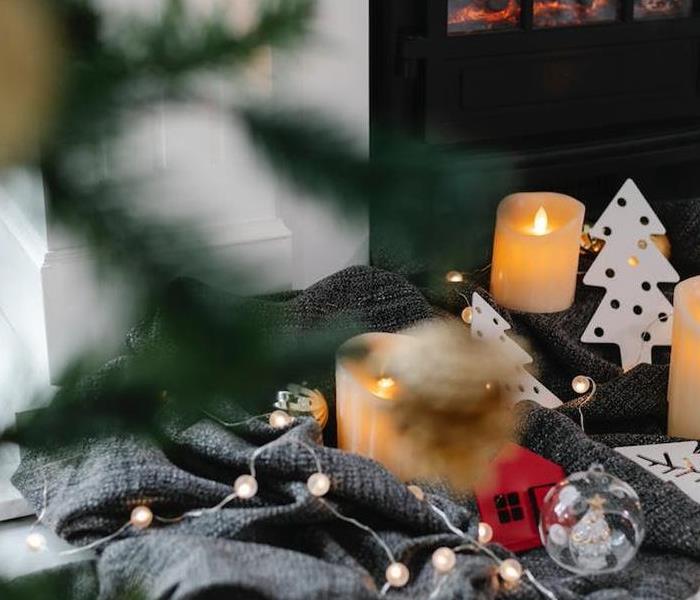 Have Questions about Fire, Smoke, or Soot Damage?
Call Us Today –908.650.8611
Have Questions about Fire, Smoke, or Soot Damage?
Call Us Today –908.650.8611
Fall Fire Safety:
Heating Safety:
With temperatures dropping, many homeowners rely on heating systems to keep warm. Ensure your heating equipment, whether it's a furnace, fireplace, or space heater, is in good working condition. Have them inspected and cleaned regularly to prevent potential fire hazards.
Chimney Maintenance:
If you have a wood-burning fireplace, autumn is an ideal time for chimney maintenance. Clear any debris or nests from your chimney, and check for creosote buildup, a highly flammable substance that can ignite and lead to a chimney fire.
Smoke Alarms and Carbon Monoxide Detectors:
Test your smoke alarms and carbon monoxide detectors to make sure they're functioning correctly. Replace batteries if needed and consider installing interconnected alarms to provide early warning in case of a fire.
Dryer Vent Cleaning:
Dryer vents can accumulate lint over time, increasing the risk of a fire. Regularly clean your dryer vent and check for any blockages.
Holiday Season Fire Prevention:
Safe Decorating:
During the holiday season, homes are adorned with festive decorations. Be cautious with candles, string lights, and other decorations near flammable materials. Never leave candles unattended and use flameless candles as a safer alternative.
Cooking Safety:
Holiday feasts are a tradition for many families. Stay attentive when cooking, and keep flammable items, such as dish towels and oven mitts, away from the stovetop. Use a timer to remind you when dishes are ready to avoid distractions.
Christmas Tree Safety:
If you have a live Christmas tree, keep it well-watered to prevent it from becoming a fire hazard. Ensure that string lights are in good condition and do not overload electrical outlets.
Fire Escape Plan:
Discuss and practice a fire escape plan with your family. Make sure everyone knows how to exit the house safely in case of an emergency. Designate a meeting point outside the home.
SERVPRO Team Spinner is committed to helping you keep your home safe during the autumn season and throughout the holidays. By following these fire safety tips, you can enjoy the beauty and warmth of the season without worrying about potential fire risks. Remember that prevention is key, but in the event of a fire emergency, our team is here to help restore your home to its pre-fire condition. Stay safe and have a joyful autumn and holiday season!
Have Questions about Fire, Smoke, or Soot Damage?
Call Us Today –908.650.8611
Contact SERVPRO for HVAC Maintenance to Keep Units Running Efficiently
10/9/2023 (Permalink)
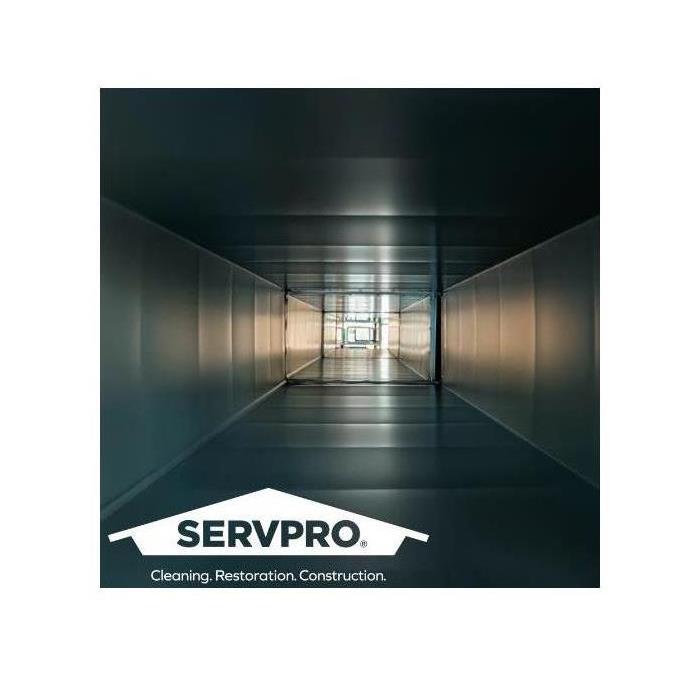 Are You Breathing Dirty Air?
Are You Breathing Dirty Air?
Everyone who owns a home appreciates the comforts of an efficient central heating and air system, but there’s a large investment associated with operating them. Did you know that about half of the energy costs for a home are due to the heating and cooling system according to Energy Star? While that’s a significant chunk of change, just a little bit of maintenance can make the investment extend much further.
It’s important to catch problems with your HVAC system before they become serious: that’s where routine maintenance comes in.
Homeowners should educate themselves about how their HVAC system works to provide it with the best care.
Swap your filters. Your HVAC filters need to be changed between every 30 and 90 days (depending on the type of filter used) for maximum air quality and efficiency. Other ways to improve heating and cooling include using the highest efficiency filter for your HVAC model and ensuring a properly secured fit when filters are installed.
Reduce your dust. Simply keeping up with routine dusting and vacuuming will clear the dust and debris out before it has a chance to invade your air flow system, doing wonders for your HVAC cleanliness. Further the benefit by always using the highest efficiency filter for the vacuum, and purchasing one with a HEPA certification if possible.
Check your drainage. As the AC runs, cooling coils work to remove water from the air and drain it away. If the moisture collected is not properly drained, water damage can occur and lead to mold growth. Regularly check drain pans and nearby surfaces for moisture accumulation to stop large problems before they start.
Tip: If you’re doing construction or renovations in the home, seal off supply and return registers in the house.
Schedule regular maintenance checkups and cleaning. There’s no substitute for having a professional survey your system twice per year. While there are quite a few things homeowners can do to maintain their HVAC system, a professional cleaning can have a marked improvement in air quality and the efficiency of your unit.
If you’d like to schedule a consultation to discuss HVAC cleaning, contact us at 609.256.8890.
Protecting Your Home: Fall Fire Safety and Holiday Season Fire Prevention
10/4/2023 (Permalink)
As the leaves change colors and the air turns crisp, autumn ushers in a season of warmth, family gatherings, and festive celebrations. However, it's also a time when fire risks can increase, and it's crucial to keep your home and loved ones safe. At SERVPRO® of Hamilton & South Trenton, we are dedicated to promoting fire safety year-round. In this blog post, we'll discuss essential tips for autumn fire safety and how to prevent fire incidents during the holiday season.
Fall Fire Safety:
1. Heating Safety:
With temperatures dropping, many homeowners rely on heating systems to keep warm. Ensure your heating equipment, whether it's a furnace, fireplace, or space heater, is in good working condition. Have them inspected and cleaned regularly to prevent potential fire hazards.
2. Chimney Maintenance:
If you have a wood-burning fireplace, autumn is an ideal time for chimney maintenance. Clear any debris or nests from your chimney, and check for creosote buildup, a highly flammable substance that can ignite and lead to a chimney fire.
3. Smoke Alarms and Carbon Monoxide Detectors:
Test your smoke alarms and carbon monoxide detectors to make sure they're functioning correctly. Replace batteries if needed, and consider installing interconnected alarms to provide early warning in case of a fire.
4. Dryer Vent Cleaning:
Dryer vents can accumulate lint over time, increasing the risk of a fire. Regularly clean your dryer vent and check for any blockages.
Holiday Season Fire Prevention:
1. Safe Decorating:
During the holiday season, homes are adorned with festive decorations. Be cautious with candles, string lights, and other decorations near flammable materials. Never leave candles unattended, and use flameless candles as a safer alternative.
2. Cooking Safety:
Holiday feasts are a tradition for many families. Stay attentive when cooking, and keep flammable items, such as dish towels and oven mitts, away from the stovetop. Use a timer to remind you when dishes are ready to avoid distractions.
3. Christmas Tree Safety:
If you have a live Christmas tree, keep it well-watered to prevent it from becoming a fire hazard. Ensure that string lights are in good condition and do not overload electrical outlets.
4. Fire Escape Plan:
Discuss and practice a fire escape plan with your family. Make sure everyone knows how to exit the house safely in case of an emergency. Designate a meeting point outside the home.
SERVPRO® of Hamilton & South Trenton is committed to helping you keep your home safe during the autumn season and throughout the holidays. By following these fire safety tips, you can enjoy the beauty and warmth of the season without worrying about potential fire risks. Remember that prevention is key, but in the event of a fire emergency, our team is here to help restore your home to its pre-fire condition. Stay safe and have a joyful autumn and holiday season!
Have Questions about Fire, Smoke, or Soot Damage?
Call Us Today – (908) 650-8611
Be Prepared: Simple Storm & Flood Tips That Could Save You in an Emergency
10/4/2023 (Permalink)
Natural disasters can strike unexpectedly, and when they do, it's essential to be prepared. Storms and floods are among the most common weather-related emergencies that homeowners face. At SERVPRO® of Hamilton & South Trenton, we understand the importance of being proactive in protecting your home and loved ones. In this blog post, we'll share simple yet effective storm and flood preparedness tips that can make a significant difference during an emergency.
1. Create an Emergency Kit:
A well-prepared emergency kit can be a lifesaver during a storm or flood. It should include essential items such as non-perishable food, water, flashlights, batteries, a first-aid kit, blankets, and important documents (e.g., identification, insurance papers). Make sure your kit is easily accessible and up to date.
2. Stay Informed:
Keep yourself informed about weather forecasts and potential storm warnings. Sign up for weather alerts on your smartphone and have a battery-operated weather radio on hand. Knowing when a storm or flood is expected can give you valuable time to prepare or evacuate if necessary.
3. Secure Your Property:
Before a storm hits, take preventive measures to secure your property. Trim overhanging branches and clear debris from gutters and downspouts to prevent water damage. Consider investing in storm shutters or impact-resistant windows to protect against high winds and flying debris.
4. Elevate Important Items:
If you live in a flood-prone area, elevate valuable items and utilities in your home. Move electrical systems, appliances, and valuable possessions to higher floors or platforms. Elevating your furnace, water heater, and electrical panel can minimize damage.
5. Have an Evacuation Plan:
Develop a family evacuation plan in advance. Identify safe evacuation routes and meeting points. Ensure that everyone in your household knows the plan, including how to turn off utilities if needed. Don't forget to include your pets in your evacuation plan.
6. Protect Your Basement:
Basements are especially vulnerable to flooding. Install a sump pump and consider a battery backup system to prevent water buildup. Waterproof your basement walls and floors to minimize water infiltration during heavy rains.
7. Insurance Check-Up:
Review your homeowner's insurance policy to ensure you have adequate coverage for storm and flood damage. Understand your policy's terms, limitations, and deductible. Consider adding flood insurance if you are in a flood-prone area.
8. Stay Safe During the Storm:
During the storm, stay indoors, away from windows, and avoid using electrical appliances. If the authorities issue an evacuation order, follow it promptly. Never attempt to drive through flooded roads, as it's difficult to gauge the water's depth and strength.
By following these simple storm and flood preparedness tips, you can significantly improve your ability to weather the storm and protect your home and loved ones. Remember that safety should always be the top priority. In the event of storm or flood damage, SERVPRO® of Hamilton & South Trenton is here to help you with water damage restoration and cleanup. Stay informed, stay safe, and be prepared for whatever Mother Nature may bring your way.
Have Storm or Flood Damage? Call Us Today - (908) 650-8611
Be Ready for Anything: Business Disaster Preparedness with SERVPRO® of Hamilton & South Trenton
10/4/2023 (Permalink)
Business owners know that running a successful operation involves juggling countless responsibilities. One critical aspect often overlooked is disaster preparedness. From natural disasters to unforeseen accidents, disasters can strike at any time. That's where SERVPRO® of Hamilton & South Trenton steps in, offering expert assistance to help business owners be prepared for any disaster. In this blog post, we'll explore why disaster preparedness matters for businesses and how SERVPRO can be your partner in readiness.
1. Identify Risks:
Start by identifying potential risks specific to your business and location. Are you in a flood-prone area? Do you experience harsh winters with the risk of frozen pipes? Knowing your vulnerabilities is the first step in preparedness.
2. Develop a Plan:
Create a comprehensive disaster preparedness plan that outlines the steps to take in case of various emergencies. Your plan should include evacuation routes, emergency contact information, and a clear chain of command for decision-making.
3. Invest in Insurance:
Adequate insurance coverage is essential. Consult with your insurance provider to ensure you have the right coverage for your business. This includes policies for property damage, liability, and business interruption.
4. Backup Your Data:
In today's digital age, data loss can be catastrophic. Regularly back up your business data, both onsite and offsite. Consider cloud storage solutions for added security.
5. Partner with SERVPRO:
SERVPRO of Hamilton & South Trenton offers a variety of services tailored to meet the needs of businesses. From emergency response plans to post-disaster cleanup and restoration, SERVPRO can be your trusted partner in disaster recovery.
6. Train Your Team:
Ensure that your employees are well-versed in the disaster preparedness plan. Conduct regular drills and training sessions to familiarize your team with emergency procedures.
7. Stay Informed:
Monitor weather alerts, stay informed about local emergency resources, and maintain a list of emergency contacts. Being informed allows for quicker response in times of crisis.
8. Regular Maintenance:
Preventative maintenance can go a long way in disaster preparedness. Regularly inspect your business premises, including electrical systems, plumbing, and structural elements, to identify and address potential issues.
Disasters may be unpredictable, but your response to them doesn't have to be. Business owners who prioritize disaster preparedness are better equipped to protect their employees, assets, and investments. With the help of SERVPRO® Hamilton & South Trenton, you can take proactive steps to be ready for anything that comes your way. From planning and prevention to cleanup and restoration, SERVPRO is your trusted partner in disaster readiness and recovery. Don't wait for disaster to strike; start preparing today for a more resilient tomorrow.
Contact SERVPRO for HVAC Maintenance to Keep Units Running Efficiently
10/3/2022 (Permalink)
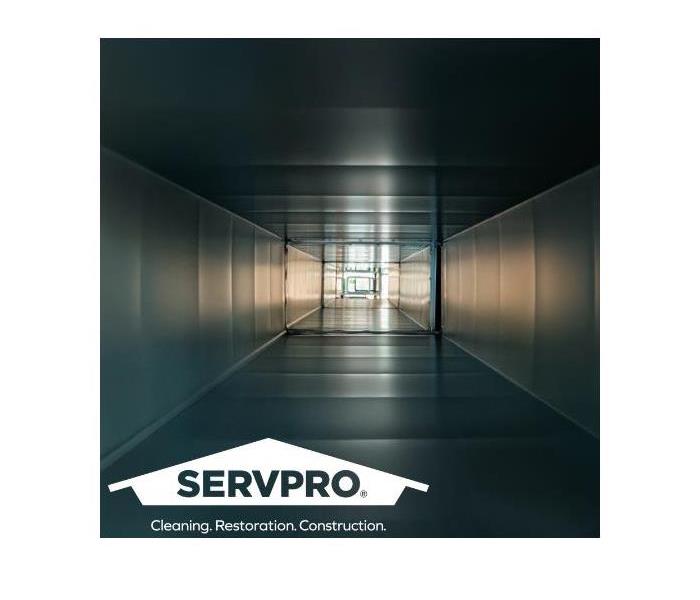 Cleaning your air ducts is very important for keeping your home and family safe.
Cleaning your air ducts is very important for keeping your home and family safe.
Everyone who owns a home appreciates the comforts of an efficient central heating and air system, but there’s a large investment associated with operating them. Did you know that about half of the energy costs for a home are due to the heating and cooling system according to Energy Star? While that’s a significant chunk of change, just a little bit of maintenance can make the investment extend much further.
It’s important to catch problems with your HVAC system before they become serious: that’s where routine maintenance comes in.
Homeowners should educate themselves about how their HVAC system works to provide it with the best care.
- Swap your filters. Your HVAC filters need to be changed between every 30 and 90 days (depending on the type of filter used) for maximum air quality and efficiency. Other ways to improve heating and cooling include using the highest efficiency filter for your HVAC model and ensuring a properly secured fit when filters are installed.
- Reduce your dust. Simply keeping up with routine dusting and vacuuming will clear the dust and debris out before it has a chance to invade your air flow system, doing wonders for your HVAC cleanliness. Further the benefit by always using the highest efficiency filter for the vacuum, and purchasing one with a HEPA certification if possible.
- Check your drainage. As the AC runs, cooling coils work to remove water from the air and drain it away. If the moisture collected is not properly drained, water damage can occur and lead to mold growth. Regularly check drain pans and nearby surfaces for moisture accumulation to stop large problems before they start.
Tip: If you’re doing construction or renovations in the home, seal off supply and return registers in the house.
- Schedule regular maintenance checkups and cleaning. There’s no substitute for having a professional survey your system twice per year. While there are quite a few things homeowners can do to maintain their HVAC system, a professional cleaning can have a marked improvement in air quality and the efficiency of your unit.
If you’d like to schedule a consultation to discuss HVAC cleaning, contact us at 609.256.8890.
Can You Identify Common Fire Hazards in Your Home?
10/3/2022 (Permalink)
 House fires can be lethal. Know the common fire hazards in your home to stay safe.
House fires can be lethal. Know the common fire hazards in your home to stay safe.
Nobody wants to think about the possibility of their home being damaged by fire, but it’s an unfortunate, harsh reality for a multitude of Americans.
One way you can help protect your home is to understand fire hazards and know how to identify them. In this blog, let’s dive into two of the most common causes of household fires.
Candles are a common fire hazard.
According to the National Fire Protection Association, over a five-year period from 2011 to 2015, fire departments across the United States answered an estimated 8,700 house fires a year that were caused by candles.
In total, these fires caused 82 deaths, 800 injuries and $295 million in property damage. Candles were the cause of 2 percent of reported house fires, of which 3 percent resulted in death and 7 percent resulted in injuries.
An average of 24 home candle fires per day were reported during those five years, with December having the highest month of incidents. Out of all the candle fires during this time period, 37 percent started in the bedroom and were responsible for 36 percent of the associated deaths and 51 percent were associated with injuries.
When using a candle, be sure it’s kept at least one foot away from anything that could possibly ignite and that it is in a sturdy holder that will not easily tip over. It is never wise to use a candle where oxygen is in use in a home. And you always want to ensure that all candles are properly extinguished before leaving a room or going to sleep.
House fires from smoking can be lethal.
While cooking is the leading cause of house fires, smoking is the main cause of home fire deaths. Approximately 17,200 house fires were reported in 2014 due to smoking, which includes cigarettes, pipes and cigars. Those fires resulted in 570 deaths, 1,140 injuries and $426 million in property damage, according to the Coalition for Fire-Safe Cigarettes.
If you’re a smoker, it is smart to smoke outside, as most deaths result from fires that started in living rooms, family rooms or bedrooms. Fire-safe cigarettes are the best option, and using a deep, sturdy ashtray is advised.
Drop all lit cigarettes and ashes in water or sand prior to throwing them out—and remember that one out of four fatal victims of smoking fires is not the smoker whose cigarette started the fire.
Dust bunnies as fire hazards?
While candles and smoking are well-known causes of home structure fires, were you aware that some glassware in your home could be a fire risk? When sunlight passes through them, the concentrated ray may ignite flammable materials. It’s best to keep glass accessories away from windows and out of direct sunlight.
Dust bunnies can also pose a fire risk when they collect near electrical sockets and floor heaters. Regular sweeping or vacuuming regularly and cleaning hard-to-reach areas like behind entertainment systems can help prevent buildup.
Also, look for loose outlets in your home. The movement of these outlets loosens the wires connected to the outlet and could create dangerous arcing.
Getting to Know the 3 Types of Water Classifications
10/3/2022 (Permalink)
If you think all water that causes water damage is the same, think again! There are three classifications for it: clean, gray and black.
By gaining a better understanding of the differences in these types of water, it will help you understand how to better handle a water damage situation.
Whenever there is a water damage situation, it doesn’t matter what type of water has caused damage because a cleanup and restoration process will always follow. First, and most important, is removing all moisture and damp items as quickly as possible to hinder the growth of mold, which begins to flourish in this ideal environment.
Clean Water
The name says it all; clean water is considered “clean” and not likely to be the type that would pose an immediate threat to your health. This water contains no contaminants and is the result of:
- Broken water lines
- Malfunctioning appliances
- Toilet holding tanks
- Snow melt and rainwater
Clean water is the easiest type of water damage to work with because there are fewer microbes living in the water. But remember, it only takes 48 hours and contact with the surfaces of a building for clean water to become a category two, becoming gray water.
Gray Water
Damage from gray water makes water damage cleanup and restoration a bit more serious. This is water that may pose a health risk because it will most likely contain chemical or biological contamination. This slight contamination means that gray water would need to be thoroughly treated before it is safe for consumption.
Water that comes from dishwashers, aquariums, showers, etc. is considered gray water, and the 48-hour exposure time applies here as well, as it will become black water if it is not quickly and property treated.
Black Water
A black water damage situation is considered the most serious of the three classifications as this water is highly contaminated by harmful chemicals and biological matter. This would include floodwaters containing soil and all sewage waters.
Sewage is contaminated with microbes, which include bacteria, protozoans, molds, fungi and more—many of these can cause health effects to humans.
Some of the diseases that can be transmitted by black water are:
- Cholera
- Typhoid
- Hepatitis
- Gastroenteritis-type illnesses
Any water involved in a flooding situation should be considered dangerous and assumed to be black water since it will pick up contaminants along its path.
The Institute of Inspection, Cleaning and Remediation Certification (IICRC), an organization that certifies and sets the standards for the cleaning and restoration industry, recognizes these three classifications of floodwater. Our highly trained technicians have all studied IICRC’s standards and best practices in water restoration and are available to help determine the steps to take to get your home back to normal.
It doesn’t matter what type of water has caused damage to your home or business, we are here to help get the situation under control and make it "Like it never even happened." Don’t hesitate to reach out to us if you need emergency cleanup and restoration services!
Understanding the Basics of Damaging Winds
10/3/2022 (Permalink)
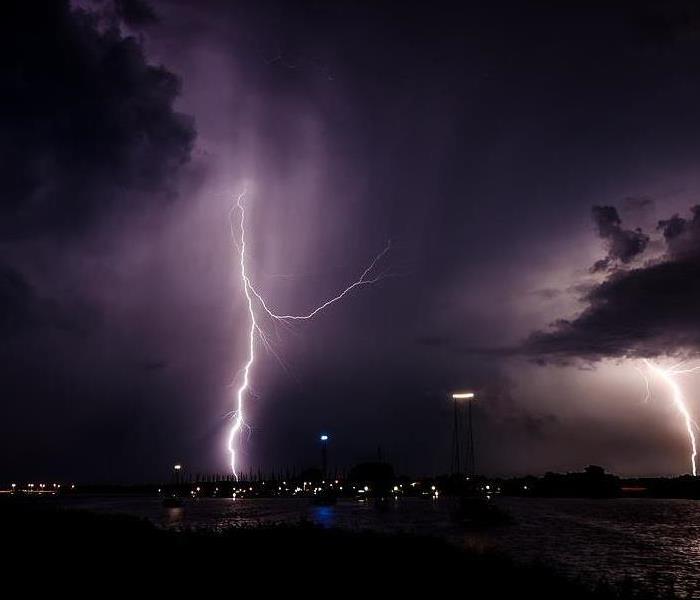 Winds and storms can be dangerous. Read these tips to understand the basics.
Winds and storms can be dangerous. Read these tips to understand the basics.
Damaging winds are one of the threats that comes with severe storms. These winds can catch you off guard and be problematic due to long-term structural impacts.
Why Damaging Winds Are Such a Major Concern
Tornadoes and hurricanes are not the only times damaging winds occur. Damaging winds are considered winds with wind speeds exceeding 50–60 mph and can be produced by a strong thunderstorm. Often, you will hear damaging winds referred to as “straight-line” winds to differentiate the damage from tornado damage.
The damage from straight-line winds can be especially destructive, often causing unanchored objects to become projectiles. Any windows or roof can take the brunt of this damage. If the damage is extensive, it can result in water damage to the home as outside elements come indoors through broken windows or damaged roofs.
Anyone who lives in a thunderstorm-prone area can be at risk from damaging winds, but there are some structures, such as mobile homes, especially at risk. Mobile homes, even those that are anchored, could sustain serious damage in winds gusting over 80 mph.
Ways to Prepare Your Home
There are a number of things you can do to protect your property from damaging winds, but there are two things to remember, keeping the “Two R’s” in mind: reinforce and remove.
Look into having your garage door reinforced by a professional.
Ensure that any loose objects on your property that could become wind-borne are properly stored or anchored. Remember that trash cans, grills and outdoor furniture are easily picked up by strong winds.
Larger, older decaying trees and branches should be professionally removed, which will ensure they cannot be blown onto your home.
Remember, high winds can occur without advanced notice. By taking some, or all, of the above actions, you can be prepared on a moment’s notice.
Also, if you are building a new home or renovating an older home, be sure windows, walls and doors are up to code for your area.
If your home has been hit by damaging winds and resulting water damage, the highly trained specialists at SERVPRO® of Hamilton & South Trenton are here to help with the cleanup and restoration of your home.
Does Your Business Have a Natural Disaster Plan?
10/3/2022 (Permalink)
Would your business be prepared to face all that Mother Nature can throw at it through floods, hurricanes, tornadoes, wildfires and earthquakes? The most important key to surviving these natural disasters is to be prepared for these situations.
Being prepared for these situations involves creating a natural disaster plan for your business. This blog will lay out some aspects to consider when designing that very important disaster plan.
Where to Start With Your Disaster Plan
There are many things you will need to consider, including your employees, your material assets and equipment, when developing a disaster plan for your business.
Some of those considerations should be:
- How to protect your employees
- How to secure your assets
- How to get business up and running again
Many checklists have been made available through sources like the Red Cross, FEMA and Ready.gov that can offer information that will help you identify areas that need to be included in your natural disaster preparedness plan. These sources will also help you see just how prepared you truly are.
Don’t Neglect Employee Safety
If a disaster should strike without warning, your plan must lay out clear and concise procedures and safety measures for the protection of your employees and visitors. Your evacuation routes and exits from your facility should all be properly and clearly marked, have an area designated that will serve as a shelter space, consider emergency light installation, and ask for volunteers to serve as designated “safety wardens” properly trained and ready to guide and assist with all emergency efforts.
When choosing a place for shelter, ideally this space would be a basement or storm cellar in the event of tornadoes or other high-wind situations. If there is no basement available, select a small interior room on the lowest level of the building, such as a closet or interior hallway.
How to Protect the Assets
In a brick and mortar location, you’ll still need to make careful decisions when it comes to protecting the assets inside the building. You have thousands of dollars tied up in equipment and/or merchandise that will be at risk should a natural disaster strike.
Be sure to have a complete and up-to-date inventory of all equipment and assets. Having photographs prior to a disaster whenever possible is also always helpful if insurance claims need to be made. If your assets are computer data-based and kept on a server, take the steps necessary to ensure that the backup system is making regular backups and that the storage system cannot be damaged, such as a cloud storage option.
If you own the building that you conduct your business in, get with a contractor to uncover areas that could be structurally strengthened. This contractor should be able to suggest possible safety upgrades and advise on any areas that may not make the grade in certain weather situations.
Getting Back to Business
When—and if—a natural disaster does occur, it may be entirely possible that your business will have to be closed for days or months due to the damage incurred. And every day you remain closed is another day of lost profits. It is wise to set up a disaster fund to help cover any additional costs that are not covered by your insurance.
Keep a list of contractors handy who will make themselves available for repairs, and know which cleanup and restoration service will be available to quickly respond to your emergency situation.
With SERVPRO® of Hamilton/South Trenton, you can count on us to get to the disaster faster and make it "Like it never even happened." Our training and expertise have prepared us to help with water damage, storm damage, fire damage and mold remediation quickly and effectively.
Knowing what to do when disaster strikes your business is of the utmost importance. When it comes to the cleanup and restoration aspects, depend on us to be there for you.
Business Owners Should Practice Flood Preparedness
10/3/2022 (Permalink)
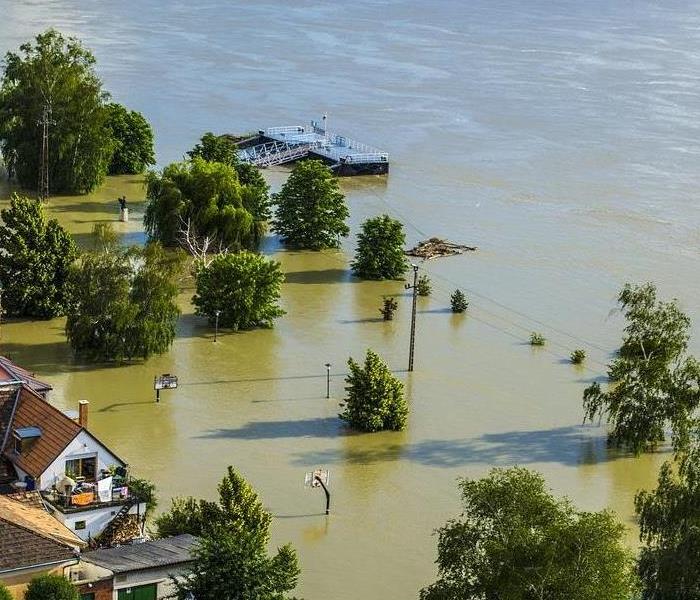 Creating a plan for floods is very important for business openers.
Creating a plan for floods is very important for business openers.
It is not uncommon for business owners to underestimate their flood preparedness, especially if they are not in an area historically known for flooding. However, it was recently reported that natural disasters involve flooding in 90% of instances and affect areas that are not typically known for flooding quite often.
Planning is a smart idea for business owners not only to increase safety within the workplace, but it can also serve to allow businesses to reopen more quickly after the flood passes. By planning ahead, business owners can have the peace of mind to know that they are ready should a flood occur.
How to Practice Flood Preparedness
Some key ways business owners can practice flood preparedness are:
- Make use of the Flood Map provided by FEMA to get an overview of flooding rates in your geographical location.
- Copy business documents and keep them in a secure location such as a waterproof safe or safety deposit box.
- Develop an official training guide for emergencies so employees can be educated and know what to do.
- Designate evacuation routes and mark them clearly.
- Consider adding flood insurance to your business policy, which does not typically include it.
- Create a personal emergency kit for your desk and an office-wide one in case someone is stranded.
- Find creative ways to raise electronics if necessary.
How to Prepare Documents for a Flood
As you begin the process of reopening the business after a disaster, having helpful documents will make the process much easier. Consider preparing and storing copies of the following:
- The continuity plan for after floodwaters recede
- Contact information for all employees, vendors, suppliers and any other parties that might need to be contacted right away
- Your insurance policy records and agent contact information
- Digital file backups and recovery instructions
- Financial documentation that may come in handy
Business Interruption Insurance
8/1/2022 (Permalink)
It's common practice to maintain commercial property insurance policies to repair and replace your assets in the event of a covered peril. In fact, for its cost, it's extremely risky to even consider not carrying this insurance. Commercial Property Insurance can pay your repair or replacement costs if your business property gets damaged or destroyed from a fire, theft, or other covered loss.
However, when your business is impacted by an event that forces closure, the impact of lost revenue and the burden of ongoing costs can be crippling. Few consider adding Business Income (interruption) coverage.
Business Income Coverage (BI) can help with operating expenses during the restoration period until the business can resume normal operations. This coverage can include:
- Lost Net Income
- Mortgage and Lease Payments
- Employee Payroll
- Taxes
- Loan Payments
As with any coverage policy, you need to consider reasonable terms when establishing the policy. After a major disaster, it can take more time than many people realize to get “back in business.” Business income coverage likely has a "restoration period.” This is the length of time that a policy will help pay for lost income and extra expenses while the business is being restored.
So, this then begs the question of "how much BI insurance coverage is needed?" The general rule is to use gross earnings and projections to help determine future profits. This will assist in determining the right amount of coverage.
What is NOT covered by BI Insurance? Typically, the following is not covered:
- Broken items resulting from a covered event or loss (such as glass)
- Flood or earthquake damage, which is covered by a separate policy
- Undocumented income that’s not listed on your business's financial records
- Utilities
- Pandemics, viruses, or communicable diseases (such as COVID-19)
BI Insurance may also include extra expenses which will cover anything beyond the normal day-to-day expenses, while the business recovers. This includes:
- Renting a temporary place of business while the original place of business is being restored
- Replacement of hardware, technology, and furniture
- Paying overtime for employees or hiring more employees
- Leasing equipment
Speak with your Commercial Insurance Agent to discuss BI insurance and other policies which could protect the business during unplanned outages of all types.
Contact us at 609-256-8890 if you have a service need or click here to visit our website to learn more about SERVPRO of Hamilton & South Trenton's System Services.
Benefits of HVAC System Cleaning
8/1/2022 (Permalink)
 HVAC Systems need to be cleaned especially in commercial buildings.
HVAC Systems need to be cleaned especially in commercial buildings.
Our SERVPRO staff are trained to take on even the biggest tasks. SERVPRO provides cleaning services to commercial buildings no matter the size.
For those with HVAC Systems, it is very important to do routinely maintenance. This has many benefits including better air quality and less energy wasted.
HVAC systems can get dirty over time and they have the potential to contain large amounts of dust and particulates. Indoor air quality is crucial and is one of the main concerns that building managers and building inhabitants have when they decide to investigate HVAC system. Normally, commercial buildings generate a great deal of contaminants and air pollutants, such as dander, dust, and chemicals. These contaminants are pulled into the HVAC system and re-circulated 5 to 7 times per day, on average. This re-circulation can cause a build-up of contaminants in the ductwork overtime.
Although filters are used, the heating and cooling system still gets dirty through normal use. Contaminants in the heating and cooling system cause it to work harder and shorten the life of your system. When an HVAC system is clean, it doesn’t have to work as hard to maintain the temperature you desire. As a result, less energy is used, leading to improved cost-effectiveness.
Source: Nadca.com
Call us at 609-256-8890 for HVAC cleaning services.
Why Carpet Cleaning is Important in the Workplace
8/1/2022 (Permalink)
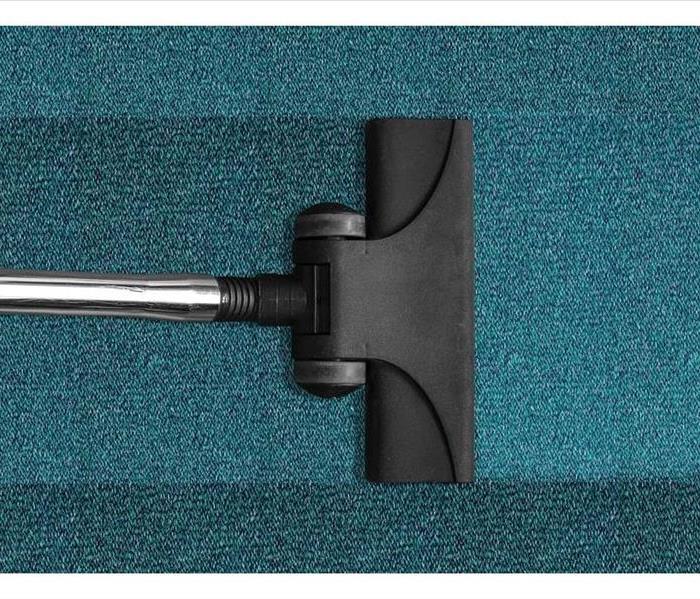 Carpet cleaning is very important in commercial buildings.
Carpet cleaning is very important in commercial buildings.
Maintenance Protects your Investment Flooring is a substantial investment —one you’ll want to protect for years to come. After all, the longer your flooring lasts, the less it costs. The initial cost for floor covering materials and installation does not fully encompass your total floor covering investment. The life cycle cost also factors in life expectancy of the carpet, costs for removal/disposal, lost revenues during renovations and maintenance costs over the life of the carpet.
Good maintenance helps protect your total flooring investment.
Maintenance helps carpet last longer and cost less proactive, regularly scheduled maintenance removes soil before it can build up and damage carpet fibers. This can actually extend the life of the carpet, reducing the costs of restoration, replacement and disposal. Reactive maintenance cannot fully restore a carpet to a like-new appearance. This results in shorter carpet life and higher carpet life cycle costs.
Maintenance Is Good for the Environment
Our life cycle analysis of carpet shows that the overall environmental footprint of carpet is reduced by increasing the amount of time a carpet remains on the floor. A consistent, proactive maintenance program can significantly improve the appearance retention throughout the life of the carpet. Less carpet waste going to landfills is always good for the environment.
Creating a Carpet Maintenance Program
Once the importance of proper carpet maintenance is understood, we can create a comprehensive maintenance program for you.
Step 1: Make preventive maintenance a priority preventing soil from entering the environment is easier and less expensive than removing it from the carpet.
Here are five simple but important steps in a preventive maintenance program:
Keep outside areas clean outside maintenance helps minimize immediate sources of soil. The cleaner you keep sidewalks, parking lots, garages and other areas around the perimeter of your building, the less dirt that will be tracked inside.
Use soil barriers walk-off mats, grates and removable elevator carpets help collect soil before it can be tracked throughout the building. Be sure soil barriers are large enough to allow for at least five steps across.
Vacuum daily, clean frequently and change often for best results. Protect desk areas chair pads under desk chairs prevent casters from crushing carpet and grinding in soil. Specify eating, drinking and smoking areas By restricting these activities to limited areas, you can help confine certain difficult kinds of soil.
Maintain your HVAC System To remove many airborne particles before they are recirculated, regularly replace or clean filters on air-handling equipment. Airborne soil includes industrial wastes, auto emissions, tobacco smoke and pollen.
Step 2: Manage Soil with regular vacuuming. Vacuuming is the most important dry soil management procedure. Effective vacuuming removes dry soil so that it cannot spread to other carpeted areas.
The level of effective vacuuming has two components: frequency and equipment type. Vacuuming Frequency:
• Heavy- to moderate-traffic areas (entrances, elevator lobbies, reception areas, busy corridors, cafeterias, vending machine areas, employee lounges) should be vacuumed daily.
• Light-traffic areas (offices, conference rooms) should be vacuumed at least two to three times per week. Equipment Type
• Dual-motor vacuums are very effective machines for thoroughly cleaning heavy- to moderate traffic areas. This vacuum uses two motors to clean. One motor drives a beater-brush bar that knocks dirt loose, while the second motor provides suction that pulls dirt into the vacuum bag.
• Single-motor vacuums can be very effective machines depending upon their design. For the most part, they should only be used in light-traffic areas. They are generally less powerful than dual-motor vacuums, but easier to maneuver around furniture.
• Detail vacuums can be used to clean around the edges of a room or in confined areas around furniture.
• Carpet sweepers may be used to remove larger particle-sized surface dirt and small litter in high-visibility areas during the business day. However, they are not an effective cleaning method and should not take the place of thorough vacuuming.
The Carpet and Rug Institute has identified vacuum cleaners that meet industry criteria for removal efficacy, particulate emission and carpet damage.
Step 3: Promptly Remove Spills and Stains Although spills are inevitable, permanent stains do not have to be. Most stains can be avoided or removed by immediate, or at least same-day, treatment. It is good practice to have spot and stain removal products and equipment on hand for immediate use.
Correct identification of spots and stains is the first step in proper removal because some types of spills may require special cleaning solutions and techniques.
But for most spills, the basic removal procedure is the same:
1. Blot as much of the spill as you can with an absorbent towel. Always work toward the center of the spill. Do not rub! If the spill is solid or semisolid, gently scrape off what you can using a dull knife.
2. Apply a general-purpose carpet spotter to the spill. This is a detergent solution that is specially made for use on carpets. Never use other kinds of cleaning solutions, such as bleach. These may permanently damage the carpet.
3. Tamp or pat in the carpet spotter with a tamping brush.
4. Wait three minutes, then blot again.
5. Rinse with clean water, then blot as dry as possible. If the stain remains, repeat the entire process. If the stain persists after the second time, contact us here at SERVPRO of Central Union County.
Step 4: Renew your carpet with proactive, periodic cleaning even the most effective, consistent vacuuming may leave some soil behind.
Periodic cleaning improves the appearance and extends the life of carpet. Periodic cleaning also removes oily, sticky soil from the carpet that attracts and holds additional soil. Depending on soiling conditions and other factors, there are a number of available cleaning methods. Your choice of method should be based on what will be the most effective and compatible with your carpet and its traffic levels.
Call us at 609-256-8890 for carpet cleaning services.
What to Expect When You are Expecting a Contractor
8/1/2022 (Permalink)
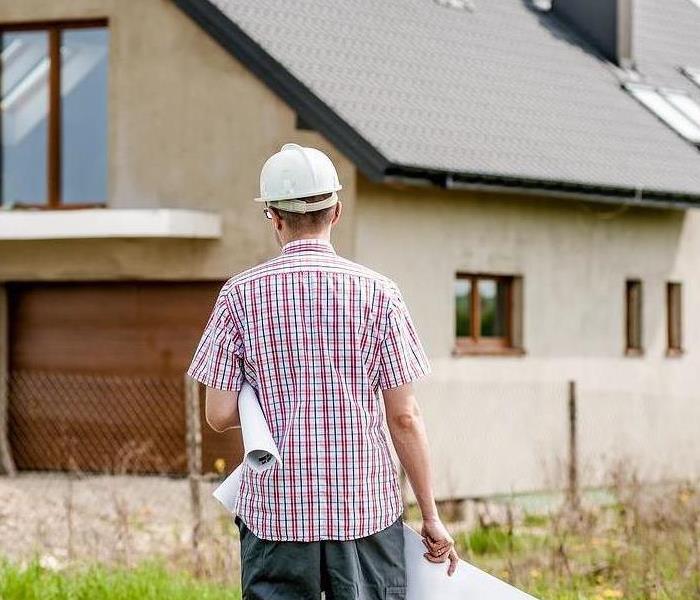 Contractors are very important for a job. Follow these tips to make it a smooth process.
Contractors are very important for a job. Follow these tips to make it a smooth process.
Looking for a commercial or residential construction company can be exhausting. You want to ensure that whoever you hire is the best company for the job at hand.
Know What You Want
As the client, you are the one driving the process. Before speaking with Contractors, spend time thinking about your goals for the project -- what it might look like, the amenities you want, and so on. If you don't know how to translate your goals into specific features or products, hire a design-build firm that can offer that service too.
Why Contractor Quotes Vary Drastically
Contractors cannot offer a correct fixed price because there are too many unknowns about the job, so try to eliminate as many of the unknowns as possible. For example, have them open up a wall to examine the skeleton of your house where the add-ons would happen.
Request to define the project specs to include only what he expects to do with the mutual understanding that if additional work is needed, you will get a change order — a written mini-bid for new work after the project has been started. This is common in the construction industry and it is the reason quotes vary by thousands of dollars. The cheapest quote also means they are not being conscientious of the realities that may come later to blow your budget when you were not prepared for unexpected expense(s).
Costs for all of the various elements of the job should include:
- Demolition and hauling trash
- Framing
- Plumbing
- Electrical work
- HVAC
- Tiling and floor covering installations
- Lighting fixtures
- Drywall and painting
- Finish carpentry
- Clean up
Contractors will often give you a fixed bid, but some work may be on a "cost plus" basis, charging you for materials, time/labor, and an administrative or overhead fee for their time managing those aspect of your project. “Cost plus” is sometimes a legitimate alternative, but it should have a cap or some provision to contain cost overruns that exceed your max budget.
Reputation Has More Value Than Price
Reputable and therefore trustworthy Contractors in trade locally for five or ten years will have an established network of subcontractors and suppliers in the area and a local reputation to uphold. That makes them a safer choice.
Ask for a business card with a real street address, not just a post office box, and get references from one or two early projects and some current customers. This will help you verify consistency and honor.
You should also vet their background by verifying their credentials and insist on a detailed contract before making a hiring decision.
Personality Is Prettier Than Price
You’re going to be spending a lot of time with this contractor, so when you make your decision, think about whether you feel comfortable with their personality, background, methods, and communication skills. Is everyone clear about the project at hand and on the same page? If not, you could end up disappointed, frustrated, and possibly out several thousand dollars beyond what you budgeted for.
Set Job Site Boundaries
Let the company know you expect routine precautions. Also, establish some ground rules about parking, bathroom use, smoking, and other issues that might concern you.
Have A Resolution Strategy
Any contractor you hire will become part of your life for at least the duration of the project. Make sure you pick someone with whom you can communicate, and trust your gut if first impressions leave you feeling uneasy. Reputable professionals will insist on clear written agreements in order to protect both parties.
During initial meetings, ask how unexpected issues or differences might be handled. This can include change orders (these should always be in writing, with cost issues directly noted) or more serious disputes, such as unintended damage or a failure to meet legal or reasonable standards.
Statistics on Main Causes of Fires
8/1/2022 (Permalink)
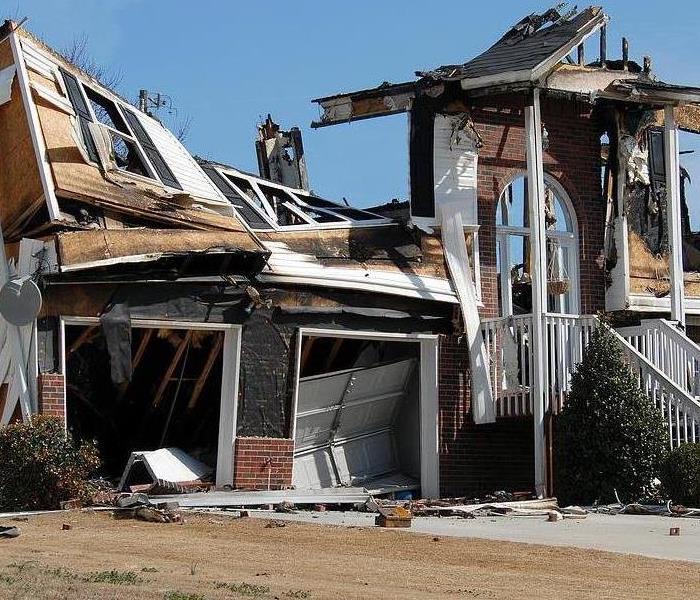 If you experience fire damage, call us and we will help make "Like it never even happened."
If you experience fire damage, call us and we will help make "Like it never even happened."
Unfortunately we all know for a fact that fires happen. As much precaution as we take to prevent them, they happen! So then what are the main causes of fires starting? The U.S. Fire Administration estimated that the leading reported causes of fires in non-residential buildings for 2013 was due to cooking materials (29.3%), intentional (9.7%), and carelessness (9.2%). However, The National Fire Protection Association (NFPA) broke down the statistics on the main causes of fire in healthcare, educational, and commercial properties.
Healthcare
In the healthcare arena, the U.S. fire departments responded to an estimated average of 6,240 structure fires during 2006-2010.
61% of fires were due to cooking equipment
7% of fires were due to clothing equipment
6% of fires were started intentionally
While cooking equipment seemed to have been the leading cause of fires, nursing homes were more likely to have fires involving clothes washer & dryer. And facilities providing care of those with developmental disabilities, mental illness or substance abuse had more fires that were intentionally set.
Education
In the educational arena, during 2007-2011 an estimated average of 4,060 structure fires per year were reported in educational facilities. And an estimated 700 structure fires per year were reported in college classrooms and adult education centers.
13% of fires began in a kitchen or cooking area
49% of fires were started intentionally
32% occurred in the lavatory or bathroom
Most fires in educational properties occurred in nursery, elementary, middle, or high schools.
Commercial
In the commercial arena, an estimated average of 3,700 fires in hotels were reported to the U.S. fire departments during 2006-2010. And the U.S. fire departments responded to an estimated average of 3,340 fires in offices during 2007-2011.
In Hotels:
45% of fires were due to cooking equipment
10% of fires were due to smoking material
9% of fires were due to heating equipment
Nearly three-quarters of fires in hotels didn’t spread beyond their origin. However, fires that began in a bedroom were responsible for 31% of civilian injuries and 72% of civilian deaths. Smoking materials were the cause of the fire in 79% of civilian deaths.
In Office Buildings:
29% of fires were due to cooking equipment
12% of fires were due to electrical and wiring equipment
11% of fires were due to heating equipment
Although cooking equipment was the leading cause of office fires, it only accounted for just 6% of the direct property damage. Electrical and lighting equipment caused 15% of direct property damage, while fires that were intentionally set caused 20% of direct property damage.
All in all cooking and electrical equipment, carelessness as well as fires set intentionally, are the main causes of fire. So what can you do to prevent fires from happening? Be cautious when using electricity or any kind of heating equipment and make sure your passive fire protection system (fire/smoke dampers, fire doors, and firestop) are inspected and tested to help ensure that your building as well as its occupants are safe in case of a fire.
If you experience a fire, call us at 609-256-8890 and we will make it like it never even happened!
Business Safety
8/1/2022 (Permalink)
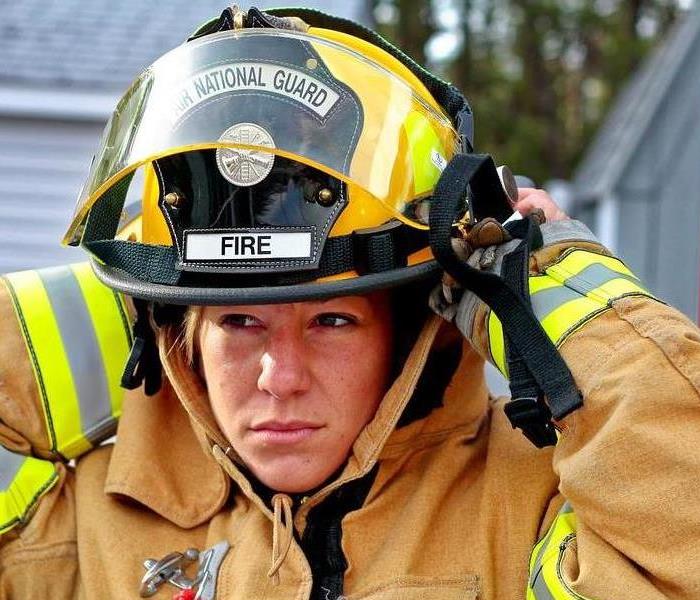 Follow these tips to keep your business safe in case of a fire.
Follow these tips to keep your business safe in case of a fire.
Fire Safety Tips for the Workplace
No matter what type of business you conduct at your workplace, fire safety should always be a main concern. Here are a few fire safety tips you can distribute to your staff:
Fire Prevention
- Keep your work area free of waste paper, trash and other items that can easily catch fire.
- Check on your electrical cords. If a cord is damaged in any way, replace it. Try not to lay cords in places where they can be stepped on, as this will contribute to deterioration of the protective outside coating.
- Don't overload your circuits.
- Turn off electrical appliances at the end of each day.
- Keep heat producing equipment away from anything that might burn. This includes copiers, coffee makers, computers, etc.
In the Event of a Fire
- Upon finding a fire, call 911 immediately and don't hand up with the emergency responder until told to do so.
- Close doors when exiting to help limit the spread of smoke and fire throughout the building.
- Never use elevators during an evacuation.
- Follow the escape plan and meet at a per-determined place outside of your building and away from danger. Conduct a headcount to ensure all of your staff has evacuated.
The best way to ensure the safety of your staff is through fire prevention and preparation. Talk with your staff about fire safety in the workplace today.
Fires in Kitchens
8/1/2022 (Permalink)
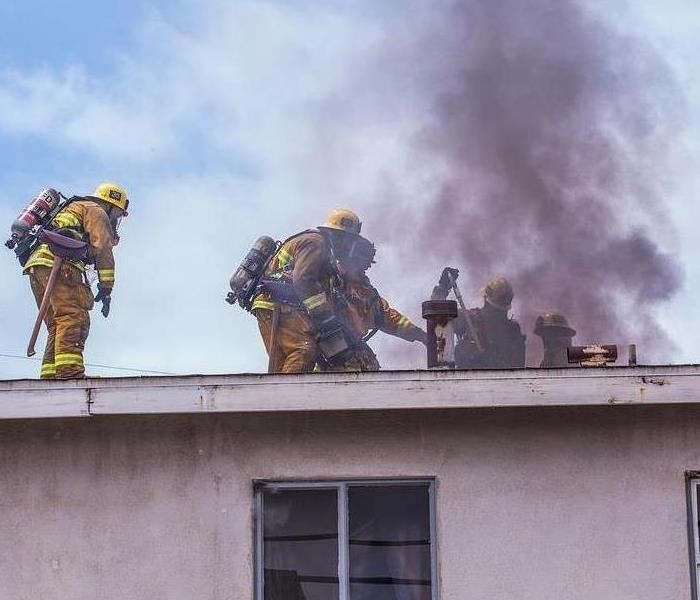 Follow these tips to stay safe from kitchen fires.
Follow these tips to stay safe from kitchen fires.
Cooking fires are the number one cause of home fires and home fire injuries. Home fires are more likely to start in the kitchen than any other room in your home. Unattended cooking causes nearly 90 percent of all kitchen fires. Here are some tips to prevent Kitchen fires.
- Never leave cooking food unattended! Fires can happen spontaneously. Cooking food should always be monitored. Make sure if you leave the room, to turn off the stove.
- Avoid any loose clothing. Baggy t-shirts or dangling sleeves can potentially catch on fire while around a stove.
- Always watch your kids! For parents, we want to keep our kids safe and sound from any fires. Try to avoid having your child(ren) around cooking areas. At least 3 feet away from the stove is ideal to insure their safety.
- Try to keep anything that can catch on fire away from your stove stop. This can include oven mitts, wooden utensils, paper or plastic bags, and towels or curtains. Materials like such can generate heat.
- Consider purchasing a fire extinguisher to keep in hands reach in your kitchen.
The Public Adjuster
7/18/2022 (Permalink)
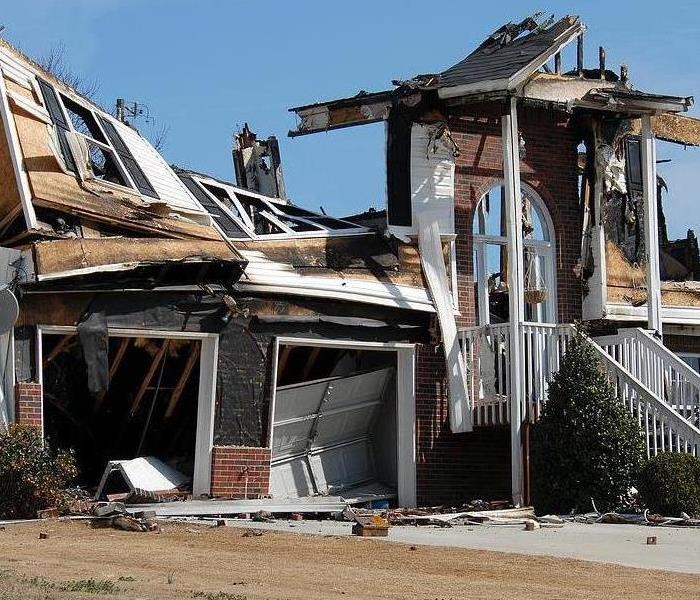 Fires can destroy homes, know your options of how to get help.
Fires can destroy homes, know your options of how to get help.
If you have ever filed an insurance claim, whether it be for your home, auto or health, you know it can be a very stressful process fraught with uncertainty and questions. Will I be covered? How much will I be covered for? How will it impact my premiums?
Because of this confusion and uncertainty, many turn towards a Public Adjuster to get them through their ordeal. But, before engaging a Public Adjuster, there are a few things you need to be aware of.
What happens first?
After you’ve taken care of your loved ones, you will need to get your home back in order. When you have a damaging event to your home, for which you wish to submit a claim, one of the first things you should do is to contact your agent or your insurance company directly.
Your insurance company will record your loss and issue you a claim number. They will also assign an internal or independent adjuster to review your claim. This adjuster works on behalf of the insurance company. This adjuster will schedule a visit to your home to inspect and assess the loss to determine coverage. This is a benefit to you as a policyholder and does not cost you anything.
Once coverage is determined, the insurance company’s adjuster will then discuss actions that need to be taken immediately, such as getting the home dried out or possibly boarded up if needed. They’ll then provide you with their assessed value of the loss.
So now comes the question of whether or not to use a Public Adjuster. Let’s go through this.
Exactly what is a public adjuster?
A public adjuster is someone that you pay to help you with your insurance claim. They are an insurance claims specialist who interprets the homeowner's policy, assesses the damage and how much it will cost to repair, and negotiate with the insurance company on behalf of the homeowner until the claim is settled.
The Public Adjuster does not represent your insurance company nor is he/she assigned by your insurance company. Public Adjusters are sought and hired by you to be your representative and deal with your insurance company. For their services, they will charge you a fee, typically a percentage of the total award amount that they negotiate with your insurance company.
Remember, a Public Adjuster can assist with the claims process, but cannot get you more money than you are entitled to under your insurance policy and will not be able to get your claim settled any faster. You are simply paying them for a service.
OK, so when should I use a Public Adjuster?
Many will hire a Public Adjuster simply because they don’t have the time to deal with the claim. Remember, though, you are paying a fee for this convenience.
Typically, the Public Adjuster will charge a fee of 10%-15% of the final claim awarded. This can be a sizable fee, so be sure before you sign any paperwork. It’s also important to know that this fee can be negotiated depending on the size of the loss.
If you chose to deal with the claim personally, there are steps you can take before bringing a Public Adjuster in. Your insurance company is a reputable business and they want you to continue to be a policyholder.
If you feel you can justify additional damages, speak with your insurance company’s assigned adjuster and present your case. If you are not getting anywhere, ask to speak with a more senior representative. You may find that these steps yield good results.
If you still feel that you need more representation, this is when you may consider working with a Public Adjuster. It’s really a judgment call as to whether or not you believe your loss, and the associated damages you claim, are fairly reflected in your insurance company’s assessment.
Before you proceed, do some simple math.
Let’s say you had a fire loss, for which your insurance company has assessed a $200,000 payment to cover the loss, but you feel you are entitled to $20,000 more and you have not been successful with your discussions with your adjuster. So, you hire a Public Adjuster with a fee of 10%. At the end of it, he argues and wins $10,000 more from your insurance company for a total payment of $210,000. The fee will be $21,000 to the Public Adjuster, netting you $189,000. You would have been better off accepting the initial payment offered by the insurance company.
How can I find a good Public Adjuster?
As with anything else, a Public Adjuster can be found by doing some internet searches. Another place to start would be going to the NAPIA website. They have a vetting process and require their members to be licensed and to have been in business for at least 2 years.
Some steps you should think about:
- Always avoid any Public Adjuster who tries to pressure you into signing a contract. Remember this is a business transaction.
- Interview several.
- Get reference lists and check with their prior clients.
- Check their company websites.
- You can also ask friends and colleagues who they might recommend.
- Avoid single practitioners or small firms unless they demonstrate a good track record.
Before signing anything, make sure your rights are protected:
- Determine how long you have to cancel any contract you sign. New Jersey protects consumers with a 72-hour cancellation provision under the Consumer Fraud Act.
- Verify that the Public Adjuster will remove any lien once the contract is terminated.
- Limit the contract to no more than six months.
Once you’ve identified your Public Adjuster, you will sign a contract between you and them, which obligates your relationship with them until the claim is settled. The Public Adjuster will likely place a lien on your insurance claim, naming them as an additional payee on all payments from your insurance company.
What role with the Public Adjuster play in the process?
So now you’ve hired a Public Adjuster. Here’s what you can count on him doing and what you should not expect.
You will still be very involved in helping the Public Adjuster document the loss. He will need details of the event and information about content damage and their value.
A public adjuster will assess your losses and help you get every penny you deserve, but don't expect miracles. Understand the insurance company may not agree to everything you want just because you hired a public adjuster.
The Public Adjuster will be your representative and negotiate every aspect of the loss with your insurance company until a final agreement is made. Once the negotiations are completed, your Public Adjuster’s job is done. They do not perform or manage the restoration portion of this project.
The next and final step is to begin the restoration process by hiring the various contractors needed to perform the cleaning and repairing of your home. This could start during negotiations between your Public Adjuster and your insurance company, depending on the urgency and what may have been agreed to.
Remember, the Public Adjuster may provide you contractor referrals to do the work, however, you are under no obligation to use them, after all, this is your home and you have every right to decide who performs the work.
Always consider using SERVPRO of Hamilton & South Trenton for your cleaning and restoration needs, regardless of any contractors your Public Adjuster may insist on using. SERVPRO of Hamilton & South Trenton is a full-service restoration company, providing everything from board-up and drying, to cleaning and rebuilding.
Summary
I hope this has helped you in understanding the role and costs surrounding using a Public Adjuster. There is always risk in any decision. Minimize your risk by doing your research first by working with your insurance company. It will be well worth it to go down this path first.
Always feel free to contact SERVPRO of Hamilton & South Trenton at (609) 256-8890 to discuss this before making your decision. We’re always glad to help.
Understanding Thunderstorm Damage
7/18/2022 (Permalink)
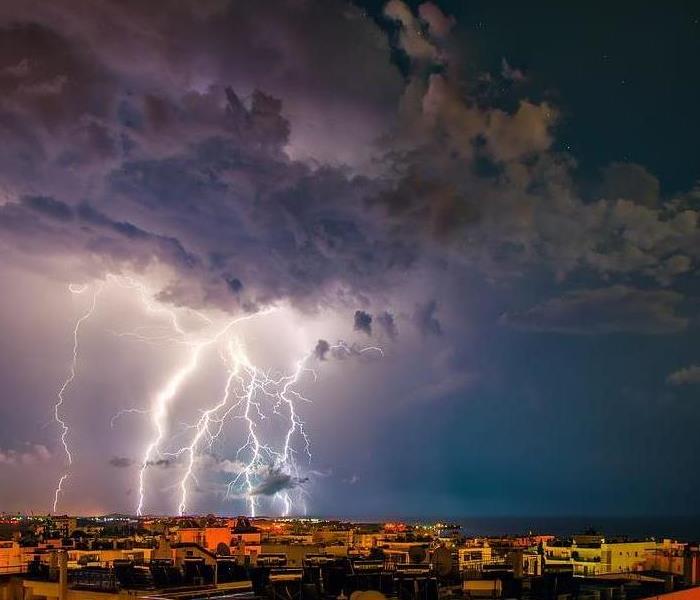 If you experience damage from a thunderstorm, reach out to us 24/7.
If you experience damage from a thunderstorm, reach out to us 24/7.
Thunderstorms are a regular occurrence during the warmer spring and summer seasons, bringing along the risk of damage to your property.
Thunderstorms come in varying levels of intensity. Do you know what those are?
Understanding Thunderstorms
Across the world, an average of 16 million thunderstorms occur each year. The U.S. can see upward of 100,000 thunderstorms annually, with an estimated 10% earning severe status.
Thunderstorms need certain conditions to be met in order to form. Moisture and rising unstable air are required, along with a “lifting” mechanism, which could be things like hills or mountains that force air to rise, or where warm/cold or wet/dry air bump together, causing that rising motion.
There are three stages in a thunderstorm’s life cycle. Those are the developing stage, the mature stage and the dissipating stage. It is during the mature stage that things like hail, strong rain, lightning, high winds and tornadoes are most likely to occur.
Common Types of Damage
Thunderstorms can prove dangerous in many different ways, but an extremely serious threat stems from the possibility of seeing flying debris due to high winds.
During severe storms, wind can see speeds in excess of 57.5 mph, and that is certainly high enough to result in damage to your property.
Even the most unexpected items could reach projectile status during a high wind situation. A smart thing to do is make sure you have scouted your yard for items that could turn dangerous, such as tree branches, lawn furniture, and fencing, and then taken steps to secure them before a storm comes into town.
Besides wind damage, thunderstorms can also produce these types of damage:
Lightning damage. Not only can lightning strikes cause a fire, they can also wreak havoc on your electrical systems. Since a lightning strike can pass through the wiring of your home, it can lead to the damage of anything plugged in.
Tornado damage. With wind speeds that can reach as high as 200 mph, tornadoes are especially destructive. They are able to cover a large area and do their damage in a limited amount of time.
Hail damage. Believe it or not, hail damage can top out around $1 billion a year. Small hail can damage crops throughout the country, while larger hail can damage vehicles, roofing and windows.
Flood damage. Rain almost always accompanies a storm, so it should not come as a surprise that heavy rains can turn into flood danger. Flash flooding can have the strength to rip trees out of the ground and sweep items and structures away.
The Dangers of Lightning during a Storm
7/18/2022 (Permalink)
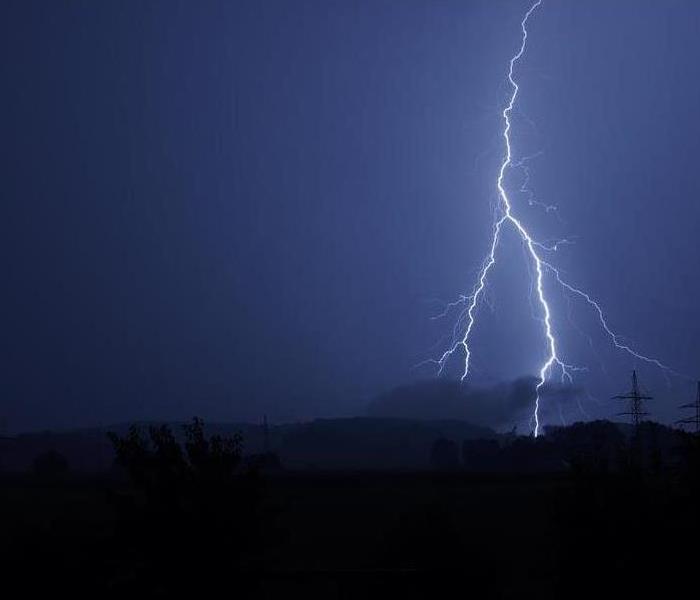 Lightning can be damaging, call us if you need our help.
Lightning can be damaging, call us if you need our help.
There are many ways in which a thunderstorm can cause damage. Flooding or wind damage are what often come to mind, but it is also important to consider the risks associated with lightning when discussing thunderstorms.
While some storms bring rain and water, every storm is made up of electricity, creating the possibility for lightning even in the absence of precipitation. Lightning bolts can be up to 500,000 degrees, causing damage and even fatalities when they strike. An understanding of what lightning is and how it can be dangerous is extremely helpful in helping homeowners prevent these risks.
How Thunderstorms and Lightning Coexist
All thunderstorms contain the electricity that makes a lightning strike possible. What we know as a lightning strike is actually a rapid burst of electricity that occurs when this charge becomes agitated.
The atmosphere is not an ideal conductor, which is why lightning tends to strike objects—this creates a less resistant route in getting to the ground. When a home is the object that has been struck, lightning will usually forge this path through water pipes and wiring.
How Lightning Is Dangerous to Homes
While there are many dangers surrounding thunderstorms, there are [three main ones involved with lightning striking a house]:
The risk of fire. One of the biggest dangers of a lightning strike to a house is the fire hazard it causes. Lightning is hot enough to ignite building materials, causing a fire to break out at the point of impact. Additionally, lightning traveling through wires can cause them to fray, creating fire hazards all throughout the home.
The risk of power surges. Because of the electrical charge at play with lightning, it can easily transfer that to the wiring in the home. This is what we call a power surge, which can affect any electronic device plugged in that is not routed through a surge protector.
The risk of shock waves. Shock waves are typically manifested in thunder, but they can also occur at the site of a lightning strike. Shock waves have been known to crack chimneys, break windows and explode cinder blocks, making them extremely hazardous to a home’s structure.
If your home has been affected by storm damages or lightning-related fires, give us a call today! We are experts in damage cleanup and can restore your damage quickly.
How to Prepare your Family for Storms
7/18/2022 (Permalink)
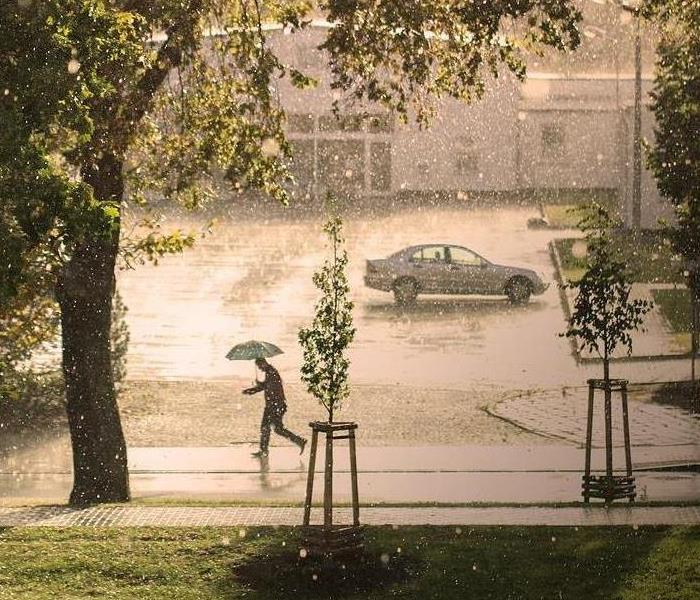 It is important to prepare for storms.
It is important to prepare for storms.
Today, we are fortunate to have advance warning for some types of severe weather, but there are also times where Mother Nature manages to catch us by surprise.
Fortunately, there are steps you can take and safety tips to follow that will guide you in preparing for your family’s safety in various severe weather occurrences.
Where to Start
One of the best ways to ensure your family’s safety is to have an established family emergency plan at the ready.
Be sure to go over your plan together as a family at the beginning of each weather season if there is an emergency plan in place so everyone knows exactly what to do.
Here are some things to take into consideration when creating your family emergency plan if you have not yet done so:
1. How will emergency alerts and warnings be received?
Thanks to technology today, emergency alerts and warnings are at our fingertips with our smartphones that are equipped with a weather app or Google. We can quickly receive emergency alerts, that provide us with valuable time in severe weather situations. Warnings and alerts are also still broadcast over radio and TV.
2. What type of storm shelter do you have?
Where tornadoes are a common occurrence, you’ll want to be in the lowest part of your home, preferably a basement, or if there is no basement, use an interior room on the lowest level that is away from corners, windows, doors and outside walls. Tornadoes aren’t the only weather circumstance that require a form of storm shelter, and you can learn about more of the situations that call for them by visiting ready.gov.
3. What are the evacuation routes?
Have you mapped out multiple evacuation routes because hurricanes, flooding and fires can force you from your home at a moment’s notice. It’s wise to have multiple routes in the event one is impassable, and be sure you find places to stay with your pets along the way if you have furry family members involved in your evacuation.
4. How will everyone stay in touch?
Cell phones are the easiest way to keep in touch with your family, but in some circumstances, that just will not be possible. Cell phone towers can be damaged and phones could be lost or left behind; not to mention batteries will not last forever and there will be no power to recharge them.
Your family should have an emergency communication plan in place as well as a safe meeting place so that you can all meet there if separated.
If a storm does cause damage to your home or business, don’t hesitate to call your friends at SERVPRO® of Hamilton & South Trenton to get the cleanup and restoration process started.
SERVPRO is ready for any storm
7/18/2022 (Permalink)
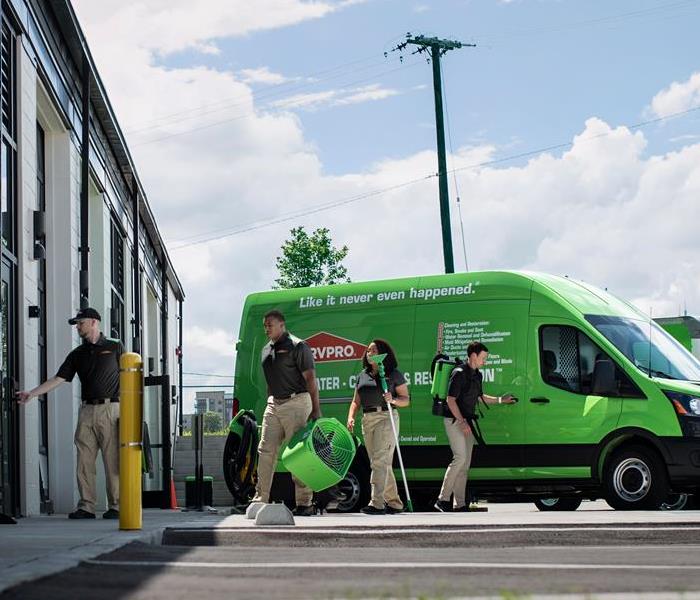 SERVPRO Hamilton & South Trenton is ready to help you.
SERVPRO Hamilton & South Trenton is ready to help you.
SERVPRO of Hamilton & South Trenton specializes in storm and flood damage restoration. Our crews are highly trained, and we use specialized equipment to restore your property to its pre-storm condition.
Faster Response
Since we are locally owned and operated, we are able to respond quicker with the right resources, which is extremely important. A fast response lessens the damage, limits further damage, and reduces the restoration cost.
Resources to Handle Floods and Storms
When storms hit Hamilton and South Trenton, we can scale our resources to handle a large storm or flooding disaster. We can access equipment and personnel from a network of over 1,650 Franchises across the country and elite Disaster Recovery Teams that are strategically located throughout the United States.
Have Storm or Flood Damage? Call Us Today at (609) 604-8241
Ways to Prevent Mold Growth after Water Damage
7/18/2022 (Permalink)
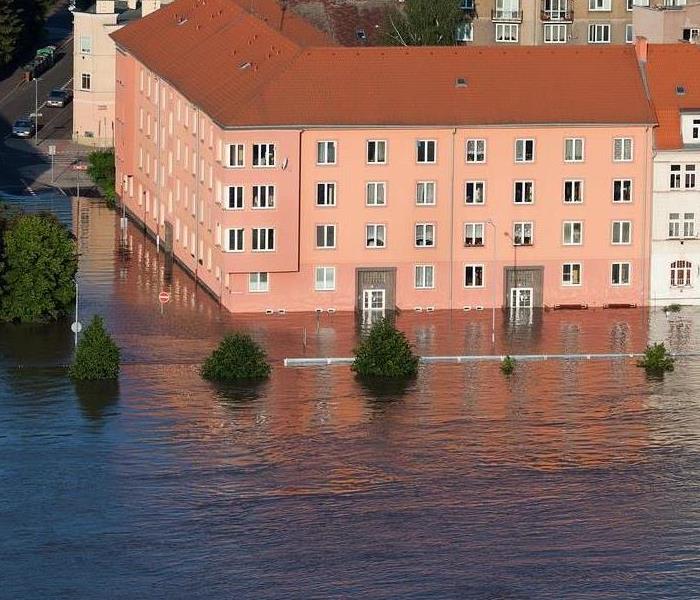 After a flood, mold can grow. Call us to help if you notice mold growth.
After a flood, mold can grow. Call us to help if you notice mold growth.
Water damage is difficult for home and business owners—not only because of the structural damage it can cause but also because of the unique health hazards and risks it can present.
One of the most dangerous of these risks is mold growth.
Here are the steps you can take to stop mold from taking hold if your home has been affected by water damage:
Before You Get Started
- Do not attempt to re-enter your building until officials have deemed it safe and are positive all water has receded.
- Take photos and videos of damage throughout—making sure to include damage done to furniture and walls—for insurance claim purposes.
Drying Should Begin Right Away
- Set up as many fans, dehumidifiers and heaters as possible to speed up drying time.
- Begin vacuuming with a heavy-duty, outdoor vacuum before the cleanup crew arrives.
- Weather permitting, open windows and doors to maximize airflow for as long as possible.
Items Exposed to Water Should Be Sorted
- Metal, plastic glass and other non-porous materials can often be cleaned, disinfected and reused.
- Porous materials exposed to water damage, such as wood, upholstery and paper of any kind, can trap mold and should be discarded.
- It is important to note that drying carpet will not necessarily remove mold spores if they’ve already begun to grow.
A Professional Should Always Be Consulted
In some cases, carpets can be salvaged after water damage. However, most experts will recommend replacing the carpet pad at a minimum.
Mold is incorrectly associated with discolorations and foul odors when the reality is that mold can often lurk unnoticed long before it is visible. Replacing the carpet pad is significantly less costly than a full re-carpeting of the home, but only a professional can determine if this is adequate enough to prevent mold from spreading.
Understanding Water Types
7/18/2022 (Permalink)
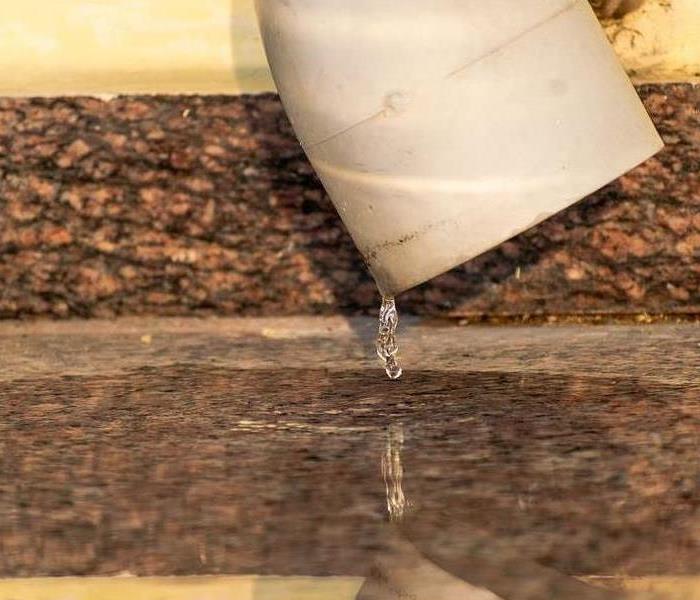 Different types of water require different types of cleanup. Call us to help.
Different types of water require different types of cleanup. Call us to help.
SERVPRO of Hamilton & South Trenton are here to help you understand what type of water you are dealing with to ensure proper cleanup when your home or business suffers a water damage.
We classify these waters in three ways. Clean water is water from a broken pipe, or other water source (such as rain). The term gray water is slightly contaminated water. Clean water becomes gray water when it is left untreated allowing bacteria and other contaminants to begin growing. Black water is highly contaminated and filled with fungi, bacteria, chemicals and more. Black water is typically caused by sewage damage, flooding or any type of natural disaster. Black water should only be handled by trained professionals. Consider taking the following precautions to help minimize damage or prevent further damage while waiting for help to arrive.
Damage from Clean Water
- We advise our customer to not enter any rooms with standing water. Electrical hazards may exist and should be avoided. Turn off your circuit breakers for wet areas of the building if access to the power distribution panel is safe from potential electrical shock.
- Shut off water source if possible.
- Remove as much excess water as possible by mopping and blotting. Wipe excess water from wood furniture after removing lamps and tabletop items.
- Remove and prop up wet upholstery cushions to allow more even drying.
- Do not use your household vacuum cleaner to remove water as there is potential for electrical shock or causing damage to the vacuum cleaner.
- Do not turn on ceiling fixtures if ceiling is wet; do not enter rooms where ceilings are sagging from retained water.
Damage from Contaminated Water
- Avoid all contact with sewage and items contaminated by sewage.
- Do not walk through contaminated areas, as you could spread damage to unaffected areas.
- Do not turn on the HVAC system if there is a possibility of spreading contaminated air.
- Do not use household fans to dry the structure; air flow could spread contaminants.
- Discard any food and/or products for personal hygiene and cleanliness if exposed to the contaminated areas.
When you have a water damage, don’t leave your property to chance. Call your SERVPRO of Hamilton & South Trenton (609) 604-8241
Common Causes and Signs of Water Damage
7/18/2022 (Permalink)
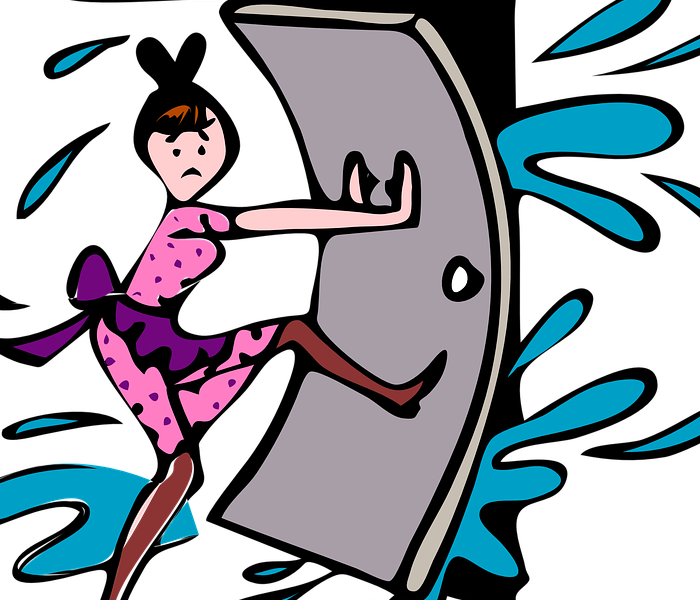 Water flooding a house.
Water flooding a house.
One of the most probable, and costly, setbacks your home can suffer is water damage. Homeowners and renters across the country lose billions of dollars because of it each year. It can occur at any time. There are a handful of situations that can cause water damage in a home:
- Problems with your HVAC system.
- Cracks in your foundation or walls.
- Severe storms, floods and other extreme weather.
- Leaky or burst pipes.
- Malfunctioning dishwashers or washing machines.
- Roof damage, such as missing shingles or cracked flashing.
- Drainage problems on your property.
Water damage is recognizable when it’s caused by a flood, but other causes are harder to spot. If you are unsure of what to look for, it can be easy to miss until it becomes a major problem. Here are the usual signs of water damage in a home:
- Paint peeling from your walls
- Mold growth (which can look like dark discoloration) on any surface
- Warping of your floors.
- A strong musty smell in a room.
- Sagging in parts of your walls or ceiling.
- Stains or discolored patches on walls or ceilings.
- Water pooling in your yard after a storm.
Source: www.budgetdumpster.com/
Home Mold Testing - DIY Kit - Use With Caution
7/1/2022 (Permalink)
You can expect mold and mildew outside your home because of the damp natural conditions of the outdoors. Mold and mildew inside the house is a different problem because the inside of your home shouldn't remain damp.
The presence of moisture is the most significant contributor to mold growth. To fight the infestation, you should conduct a room-by-room assessment of the house to identify problem areas. The moisture can come from condensation due to poor ventilation (attic), from a water leak (around bathrooms), or outdoor intrusion (foundation walls).
Detection
Mold and mildew in a home are not always easy to detect if it exists within attics or is hidden within walls. If you suspect your indoor air quality is hindered by hidden mold, the best course of action is to contact an Industrial Hygienist (IH).
The IH will take both surface and air samples to detect the presence of mold on the structure. These two tests are essential to take in concert with each other as they will help detect the presence of mold in areas that cannot be seen or reached, such as in wall cavities. They will also help determine the severity and types of mold in a specific area of the home.
If you choose to take your own surface sample as a first step, mold detection kits can be purchased in most home improvement stores and are easy to use. Swab the surface in the area you're concerned about. Test results show in as little as 5 minutes, and much like a pregnancy test, you'll either see one line (negative results) or two lines (positive).
Use caution as these tests are not necessarily conclusive, given the absence of air samples and misinterpretation by the user. Only a trained professional should perform mold testing using the proper methods.
Even if your home test is positive, it does not necessarily mean you have a serious problem but that you should consider consulting a professional indoor air quality inspector or contact SERVPRO of Hamilton & South Trenton. You can also have an optional laboratory analysis of your test results conducted for an additional fee.
Click here to go to our website and learn a bit more about Mold Remediation.
Fighting the Mold you Find
If you discover mold on the home's interior, the first step in solving the problem is to eliminate the source of moisture—whatever that may be. Otherwise, any mold or mildew you clean is likely to return.
For minor problems, you may be able to clean the surface of the materials with an antimicrobial cleaner. For major problems, remove materials that cannot be thoroughly cleaned of mold-like insulation, carpeting, or drywall. Use your antimicrobial cleaner to clean the surrounding area as well as the places where you actually see mold and mildew, so make sure you remove all traces of the substances.
Finally, replace the removed building materials with new, mold-free materials.
Mold can be a serious issue with challenging aspects in remediating it properly. We highly recommend calling in a professional, like SERVPRO, to help you evaluate the proper steps before proceeding on your own.
Contact us at (609) 256-8890 if you have a service need or click here to visit our website to learn more about SERVPRO of Hamilton & South Trenton's System Services.
Is it Mold or is it Rust?
7/1/2022 (Permalink)
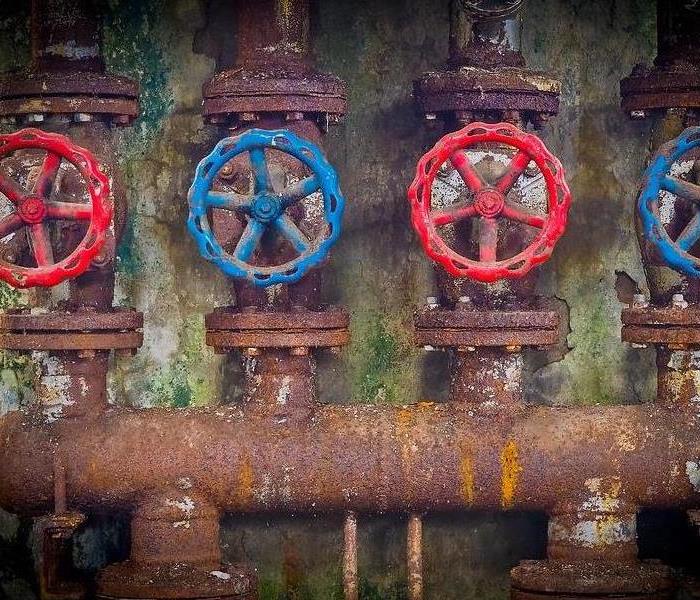 Rust on water pipes.
Rust on water pipes.
Can you easily tell the difference between mold and rust? Many people look at a reddish colored stain and assume its rust, although that’s not always the case. Before you break out your heavy-duty cleaning solutions, it pays to understand what you’re up against: mold, rust, or even another stain.
What’s Normal for Your Home?
If you’re seeing new stains on walls, floors, or countertops, you’ll want to make sure they’re not the result of water infiltration or excess humidity in your home. Try to pinpoint a reason for the stain, based on what room it’s in and the common daily activity. Mold tends to be found in damp, humid areas, while rust forms when metallic surfaces start to corrode. Recognizing the differences between mold and rust helps you determine the best way to take care of an issue before it becomes more pervasive.
What’s that Stain? Mold vs Rust
Areas prone to dampness, such as bathrooms and basements, can easily foster the growth of mold or mildew. If you see a stain that looks like mold or rust in your shower, sink area, or basement, you’ll want to clean them as quickly as possible to avoid permanent damage. However, different cleaning solutions are used to treat different stains. Rust, hard water marks, grease, and mold may all look similar, but if you use the wrong cleaner, you may not be able to fully remove them.
Identifying Rust
Rust is the result of iron, or a metal alloy containing iron, such as steel, corroding. Rust is most often observed as a red, yellow or reddish-brown surface stain. Rust is caused by water or damp air touching the surface or a metal prone to rusting. Some common areas where rust is spotted in the home, according to the International Association of Certified Home Inspectors (InterNACHI), include the following:
- Water Pipes
- Metal Roofs and Chimneys
- Oil tanks for home with oil heat
- Electrical Panel Boxes
- Nails
Preventing Rust
Rust can be prevented by keeping metals out of damp and humid areas. Protective coatings, such as varnish may also be applied to surfaces prone to rusting. Ensuring that metal fixtures in your home are kept dry can also help to prevent rust. Wipe up spills immediately and check your basement after heavy storms to spot signs of flooding as soon as possible.
Removing Rust
Removing rust can be a tough job, but with the right cleaners, you should be successful. For lighter rust stains, some household products, such as baking soda or vinegar might work. Mild abrasives like steel wool pads may also remove surface rust, but they may also leave behind scratch marks. There are also many specialized rust removal products sold that you can try for smaller stains. One product you should never use on rust is bleach, which could react negatively with the rust and actually worsen it.
If you do attempt to clean rust, always follow the instructions on any commercial cleaning product. Be sure to don safety gear, including gloves, safety glasses and a face mask. Always work in a well-ventilated area. If you’re not comfortable with the task, find a handyman or painter that is.
Mold Stains
Mold can resemble other stains like rust or mildew in appearance, but there are actually over 300 types of mold. The colors of mold can range from black to brown, white or gray, or even pink, blue or green. Mold also presents in a range of textures from downy to fuzzy. Some mold is powdery and some has a more slimy texture.
Mold can grow as the result of a single event, such as a broken pipe or indoor water infiltration due to floods or leaks. It’s important to catch the signs of indoor mold growth as early as possible and have them taken care of before they lead to greater damage. Mold sometimes can leave a stain, but that’s not always the case. A damp, musty odor can also be a sign of mold growth.
If you notice mold growth in damp areas of your home, you can clean affected surfaces with a specialized mold removal product. Common, everyday household cleaning solutions may not be effective against mold. Typically, mold cannot be totally eradicated from porous surfaces, like shower curtains, drywall, or insulation; these items should be disposed of and replaced.
When cleaning mold, you should always wear protective gear, such as a face mask, and ensure that you’re working in an adequately ventilated area. You can read more about the protective gear recommended for mold removal. SERVPRO of Hamilton & South Trenton can help you determine the best way to remove the mold. Once the mold is removed, it’s a good idea to have the area tested by a professional. If mold has continued to grow in your home, you may have a more pervasive problem that requires additional professional remediation from SERVPRO of Hamilton & South Trenton.
Evaluating Mold Issues
Because so many of the stains we see around the house look similar, it may be difficult to determine what is causing the discoloration and damage. If you notice stains on your walls, countertops, or floors that look like mold or rust, contact SERVPRO of Hamilton & South Trenton and request a free home inspection to help diagnose your problem.
Contact us at (609) 604-8241 if you have a service need or click here to visit our website to learn more about SERVPRO of Hamilton & South Trenton's System Services.
Mold and Humidity Threats in Vacation Residences
7/1/2022 (Permalink)
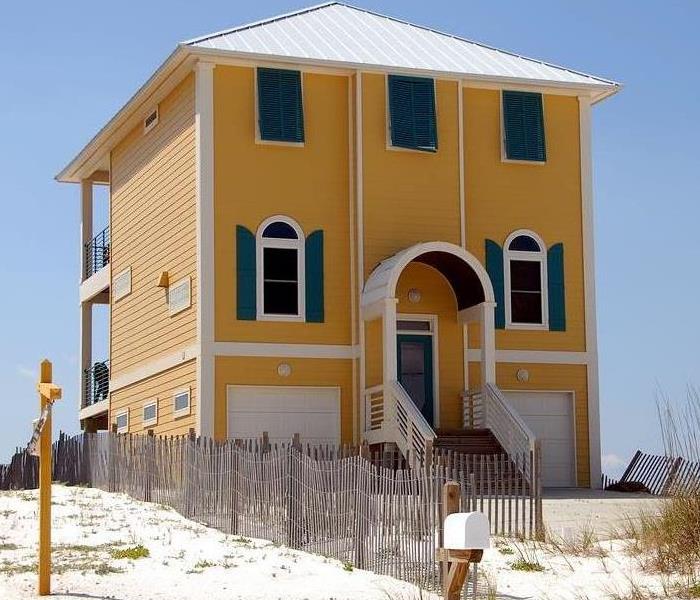 A vacation home can be affected by mold and humidity.
A vacation home can be affected by mold and humidity.
A closed-up vacation house can be a breeding ground for mold in the summer months. Moisture from a nearby lake or river, or the humidity in the air, can lead to that musty odor vacationers have come to expect upon arriving at their weekend getaway.
Mold is a particularly hidden foe. It exists nearly everywhere in an inactive state, and all it needs to grow is a food source (drywall will do nicely) and a source of moisture, such as high humidity.
To get rid of the damp odor, most homeowners will turn on the air conditioner and maybe a dehumidifier and wait for the smell to go away. While much of the odor may dissipate in a few hours, the mold is still there. And, when they leave for a week, it's back again when they return.
Left untreated, mold will continue to grow and spread and can damage walls, ceilings, carpeting, and more. Every time the house is closed up and the a/c is turned off, the moisture creeps back in, and the mold begins growing again.
MOISTURE SOLUTIONS
What can HVAC contractors do to help? First, it's important to stress that the key to preventing mold is eliminating moisture. The first step is to address any leaks in roofing, chimneys, and foundations. Perhaps you can recommend someone who can do a thorough check and perform the repairs necessary to stop the leaks. If mold remediation is needed, your customer should get bids from several companies specializing in this, as it can be costly.
Reducing humidity through air conditioning is a key to controlling mold, but, of course, leaving the a/c on all summer long will run up utility bills. Fresh outside air is also critical, but vacation homeowners won't want to leave windows open while not using the property.
Some relatively new offerings in air conditioning systems can help manage mold problems. One example is a small-duct, high-velocity air handler, which has a unique cooling coil that removes 30 percent more humidity from the air than a traditional system. Eliminating moisture is critical in avoiding mold growth, so this feature is essential.
Another helpful technology is a continuously operating outdoor inverter unit that works so efficiently that homeowners can leave it on while they're away without breaking the bank. It runs on various speeds — typically a very low speed — always striving for the most efficient operation by making small, incremental changes to keep a constant temperature. A traditional system must ramp-up to full operating power every time it cycles on, requiring a tremendous amount of energy. You won't have this issue with the inverter unit.
When cooling a summer home, the inverter technology is an excellent way for customers to keep the air conditioning going when they're gone, but at a lower cost.
Another great option is a ventilation system operated by a programmable control board. Based on the size of the home, the control board calculates how much fresh outside air to bring in at all times, opening and closing dampers as needed to maintain a healthy level of fresh air. Look for options that meet ASHRAE 62.2 standards for IAQ.
These newer technologies can go a long way toward reducing energy consumption while letting fresh air in and keeping mold problems at bay. More savings and fewer molds mean a healthier and happier vacation for everyone.
Contact us at (609) 256-8890 if you have a service need, or click here to visit our website to learn more about SERVPRO of Hamilton & South Trenton System Services.
The Public Adjuster
7/1/2022 (Permalink)
If you have ever filed an insurance claim, whether it be for your home, auto or health, you know it can be a very stressful process fraught with uncertainty and questions. Will I be covered? How much will I be covered for? How will it impact my premiums?
Because of this confusion and uncertainty, many turn towards a Public Adjuster to get them through their ordeal. But, before engaging a Public Adjuster, there are a few things you need to be aware of.
What happens first?
After you’ve taken care of your loved ones, you will need to get your home back in order. When you have a damaging event to your home, for which you wish to submit a claim, one of the first things you should do is to contact your agent or your insurance company directly.
Your insurance company will record your loss and issue you a claim number. They will also assign an internal or independent adjuster to review your claim. This adjuster works on behalf of the insurance company. This adjuster will schedule a visit to your home to inspect and assess the loss to determine coverage. This is a benefit to you as a policyholder and does not cost you anything.
Once coverage is determined, the insurance company’s adjuster will then discuss actions that need to be taken immediately, such as getting the home dried out or possibly boarded up if needed. They’ll then provide you with their assessed value of the loss.
So now comes the question of whether or not to use a Public Adjuster. Let’s go through this.
Exactly what is a public adjuster?
A public adjuster is someone that you pay to help you with your insurance claim. They are an insurance claims specialist who interprets the homeowner's policy, assesses the damage and how much it will cost to repair, and negotiate with the insurance company on behalf of the homeowner until the claim is settled.
The Public Adjuster does not represent your insurance company nor is he/she assigned by your insurance company. Public Adjusters are sought and hired by you to be your representative and deal with your insurance company. For their services, they will charge you a fee, typically a percentage of the total award amount that they negotiate with your insurance company.
Remember, a Public Adjuster can assist with the claims process, but cannot get you more money than you are entitled to under your insurance policy and will not be able to get your claim settled any faster. You are simply paying them for a service.
OK, so when should I use a Public Adjuster?
Many will hire a Public Adjuster simply because they don’t have the time to deal with the claim. Remember, though, you are paying a fee for this convenience.
Typically, the Public Adjuster will charge a fee of 10%-15% of the final claim awarded. This can be a sizable fee, so be sure before you sign any paperwork. It’s also important to know that this fee can be negotiated depending on the size of the loss.
If you chose to deal with the claim personally, there are steps you can take before bringing a Public Adjuster in. Your insurance company is a reputable business and they want you to continue to be a policyholder.
If you feel you can justify additional damages, speak with your insurance company’s assigned adjuster and present your case. If you are not getting anywhere, ask to speak with a more senior representative. You may find that these steps yield good results.
If you still feel that you need more representation, this is when you may consider working with a Public Adjuster. It’s really a judgment call as to whether or not you believe your loss, and the associated damages you claim, are fairly reflected in your insurance company’s assessment.
Before you proceed, do some simple math.
Let’s say you had a fire loss, for which your insurance company has assessed a $200,000 payment to cover the loss, but you feel you are entitled to $20,000 more and you have not been successful with your discussions with your adjuster. So, you hire a Public Adjuster with a fee of 10%. At the end of it, he argues and wins $10,000 more from your insurance company for a total payment of $210,000. The fee will be $21,000 to the Public Adjuster, netting you $189,000. You would have been better off accepting the initial payment offered by the insurance company.
How can I find a good Public Adjuster?
As with anything else, a Public Adjuster can be found by doing some internet searches. Another place to start would be going to the NAPIA website. They have a vetting process and require their members to be licensed and to have been in business for at least 2 years.
Some steps you should think about:
- Always avoid any Public Adjuster who tries to pressure you into signing a contract. Remember this is a business transaction.
- Interview several.
- Get reference lists and check with their prior clients.
- Check their company websites.
- You can also ask friends and colleagues who they might recommend.
- Avoid single practitioners or small firms unless they demonstrate a good track record.
Before signing anything, make sure your rights are protected:
- Determine how long you have to cancel any contract you sign. New Jersey protects consumers with a 72-hour cancellation provision under the Consumer Fraud Act.
- Verify that the Public Adjuster will remove any lien once the contract is terminated.
- Limit the contract to no more than six months.
Once you’ve identified your Public Adjuster, you will sign a contract between you and them, which obligates your relationship with them until the claim is settled. The Public Adjuster will likely place a lien on your insurance claim, naming them as an additional payee on all payments from your insurance company.
What role with the Public Adjuster play in the process?
So now you’ve hired a Public Adjuster. Here’s what you can count on him doing and what you should not expect.
You will still be very involved in helping the Public Adjuster document the loss. He will need details of the event and information about content damage and their value.
A public adjuster will assess your losses and help you get every penny you deserve, but don't expect miracles. Understand the insurance company may not agree to everything you want just because you hired a public adjuster.
The Public Adjuster will be your representative and negotiate every aspect of the loss with your insurance company until a final agreement is made. Once the negotiations are completed, your Public Adjuster’s job is done. They do not perform or manage the restoration portion of this project.
The next and final step is to begin the restoration process by hiring the various contractors needed to perform the cleaning and repairing of your home. This could start during negotiations between your Public Adjuster and your insurance company, depending on the urgency and what may have been agreed to.
Remember, the Public Adjuster may provide you contractor referrals to do the work, however, you are under no obligation to use them, after all, this is your home and you have every right to decide who performs the work.
Always consider using SERVPRO of Hamilton & South Trenton for your cleaning and restoration needs, regardless of any contractors your Public Adjuster may insist on using. SERVPRO of Greater Sussex County is a full-service restoration company, providing everything from board-up and drying, to cleaning and rebuilding.
Summary
I hope this has helped you in understanding the role and costs surrounding using a Public Adjuster. There is always risk in any decision. Minimize your risk by doing your research first by working with your insurance company. It will be well worth it to go down this path first.
Always feel free to contact SERVPRO of Hamilton & South Trenton at (609) 256-8890 to discuss this before making your decision. We’re always glad to help.
Places To Find Cash After A Disaster
7/1/2022 (Permalink)
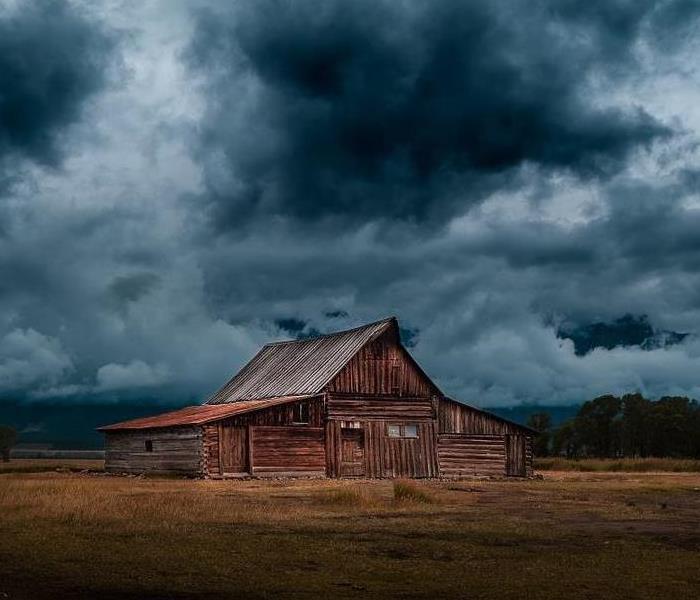 A home in an area with a storm.
A home in an area with a storm.
It happens when you least expect it, and you certainly don't plan for it. The natural disaster, like a flood, fire or any other type of personal catastrophe that leaves you in dire need of liquid funds.
Self preservation requires cash. If you’re hit with an emergency and need to find cash fast, of course, the first place to look are your bank accounts. If these funds are not sufficient, then look to these resources.
1. Family and Close Friends
If you need to find cash fast, ask your family and friends. If they can help, remember to always treat this as a loan and never treat it casually.
If you need to, attach an interest rate and a payment time frame, as you would any official loan from a financial institution. This is important because your family or friend have to charge you something for the transaction to be considered a loan and not a gift that could have tax and estate planning implications.
2. The Government
FEMA is able to provide disaster assistance for such needs as temporary housing, home repair, disaster-related medical expenses, vehicle damage and cleanup costs. Another source, the U.S. Small Business Administration (SBA) offers federally subsidized loans for renters, private nonprofit organizations and home and business owners.
Here's the catch...to qualify for either a FEMA or SBA loan, you must live in a federally declared disaster zone and file a claim with their insurance company first.
3. Life Insurance
Permanent life insurance policies are great resources because they’re readily accessible funds. The can be borrowed against without having to qualify for a loan, and you can pay a policy loan back on your own schedule.
However, rules will vary with insurance providers. Many require policyholders to own their policies for a few years before they can qualify to borrow. You’ll also be charged interest for taking out a policy loan.
4. CDs, Savings Bonds and Mutual Funds / Stocks
CD's: You can take your money out of a CD, but you’ll likely pay a penalty. Sacrificing some earnings is a relatively insignificant compared to paying interest rates on a life insurance loan.
Savings bonds: Savings bonds are another quick cash resource. You might need to pay a three-month interest penalty if a bond is redeemed too early though. In both cases, of course you’ll pay income tax on any interest earned.
Mutual Funds: You can sell stocks as well as mutual funds and annuities. If you take this route, consult your financial adviser about likely tax issues and penalties.
5. College 529 Savings
You may need to borrow from your future to pay present obligations. You 529 College Savings Account is a good resource for this. However, according to the Securities and Exchange Commission, those who withdraw funds out of a 529 plan for non-qualified education expenses will pay income tax and a 10 percent penalty on any earnings.
6. Retirement Accounts
Retirement accounts can be used to fund personal financial needs. It's important to understand the long term personal retirement planning impact. So plan accordingly and know the difference between a Roth IRA and a traditional IRA.
Roth IRA holders may withdraw their own contributions — not earnings — without tax or penalty.
Traditional IRA holders may start taking penalty-free distributions on their accounts if they begin taking regular distributions, but specific rules apply. You’ll pay income taxes and a 10 percent penalty on the taxable amount if you’re under age 59½.
7. A 401(k) Loan
A 401(k) loan is usually a better option than using a 529 or IRA loan.
401(k) holders can borrow up to half of their account balance, up to $50,000, tax-free, but, in most cases, funds must be repaid within five years.
The shortcoming is that you have to stay with your current employer for the duration of the loan period. If you leave your job, you’ll have 30 to 60 days to repay the loan or face penalties.
Before pulling funds from any long-term investment, read the fine print and always consult your tax adviser.
Contact us at (609) 604-8241 if you have a service need or click here to visit our website to learn more about SERVPRO of Hamilton & South Trenton System Services.
Lightning in a Thunderstorm
7/1/2022 (Permalink)
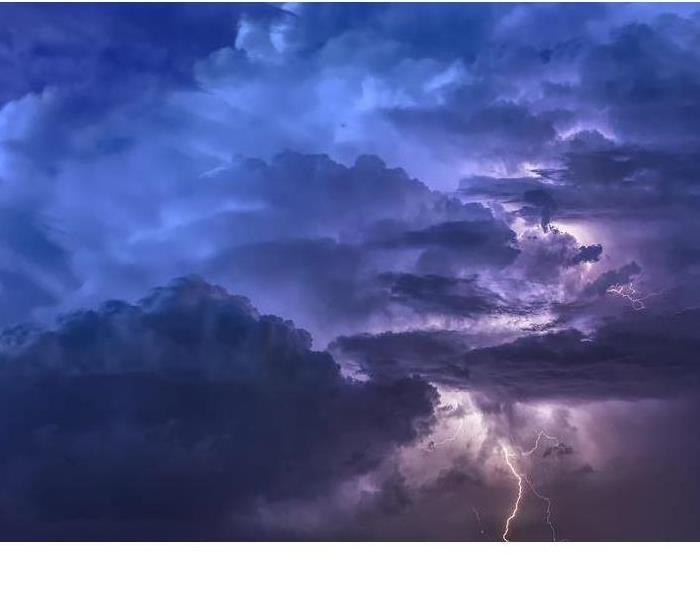 Lightning in the sky.
Lightning in the sky.
There are many ways in which a thunderstorm can cause damage. Flooding or wind damage are what often come to mind, but it is also important to consider the risks associated with lightning when discussing thunderstorms.
While some storms bring rain and water, every storm is made up of electricity, creating the possibility for lightning even in the absence of precipitation. Lightning bolts can be up to 500,000 degrees, causing damage and even fatalities when they strike. An understanding of what lightning is and how it can be dangerous is extremely helpful in helping homeowners prevent these risks.
All thunderstorms contain the electricity that makes a lightning strike possible. What we know as a lightning strike is actually a rapid burst of electricity that occurs when this charge becomes agitated.
The atmosphere is not an ideal conductor, which is why lightning tends to strike objects—this creates a less resistant route in getting to the ground. When a home is the object that has been struck, lightning will usually forge this path through water pipes and wiring.
How Lightning Is Dangerous to Homes
While there are many dangers surrounding thunderstorms, there are [three main ones involved with lightning striking a house]:
The risk of fire. One of the biggest dangers of a lightning strike to a house is the fire hazard it causes. Lightning is hot enough to ignite building materials, causing a fire to break out at the point of impact. Additionally, lightning traveling through wires can cause them to fray, creating fire hazards all throughout the home.
The risk of power surges. Because of the electrical charge at play with lightning, it can easily transfer that to the wiring in the home. This is what we call a power surge, which can affect any electronic device plugged in that is not routed through a surge protector.
The risk of shock waves. Shock waves are typically manifested in thunder, but they can also occur at the site of a lightning strike. Shock waves have been known to crack chimneys, break windows and explode cinder blocks, making them extremely hazardous to a home’s structure.
If your home has been affected by storm damages or lightning-related fires, give us a call today! We are experts in damage cleanup and can restore your damage quickly.
Storm Damage: What are the causes?
7/1/2022 (Permalink)
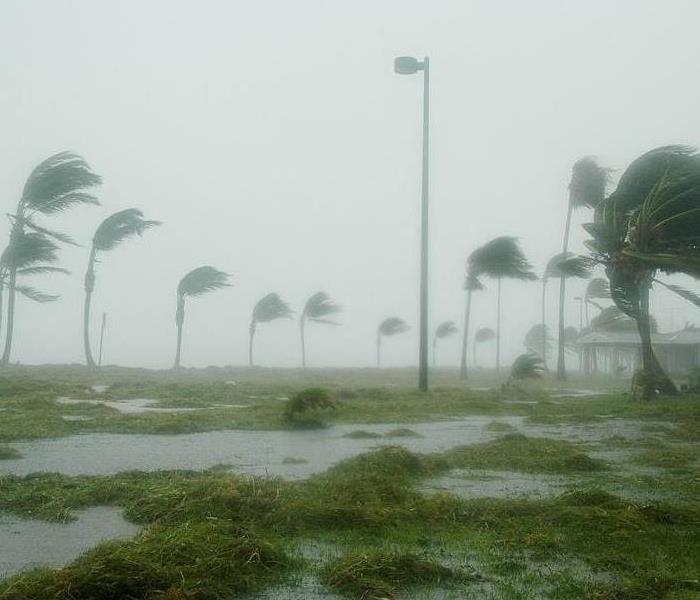 Winds and rain in a hurricane.
Winds and rain in a hurricane.
In the past few months, New Jersey has been experiencing a high level of heavy rainfall. Did you know heavy rainfall and subsequent flooding is one of the common types of damage from storms? There are ten common types of storms and being familiar with them aids in storm preparation and damage prevention.
We know how important it is to homeowners to keep homes safe from storm damage.
The 5 most common storms are:
- Hurricanes
- Tornadoes
- Thunderstorms
- Snow storm
- Hail storms
The fact is that hurricanes cause damage far past the coast. That storms cause damage is obvious, but the kinds of damage they cause and how is not always known.
Since hurricanes have long-term effects (Hurricane Sandy impacted 24 states), it’s very important to be educated on that type of storm in particular.
Hurricane damage is caused by three distinct but related storm elements: storm surge, floods, and wind.
Storm surge is when water rises far past the predicted tide level. This rise occurs because the wind from the hurricane pushes the water toward the shore, giving it nowhere to go, except up and in. The force of storm surge can be so strong as to destroy buildings and roads.
Storm surge is a direct cause of floods. The extra water from storm surge can reach far inland, causing widespread floods as it goes. Hurricanes can also cause rainfall as far as 100 miles past where the hurricane actually hits. Even tropical storms that don’t reach hurricane level can cause excess rainfall and thus floods.
Wind from hurricanes can reach speeds of 74 mph up to 155 mph. Winds of this speed cause widespread destruction by uprooting trees, downing power lines, and carrying debris and tossing it against other structures, even causing roofs to lift. It’s not unheard of for hurricane winds to form tornadoes.
Storm surge, floods, and winds can cause damage that is far-reaching, unexpected, and overwhelming. You can take precautions by packing an emergency preparedness kit, installing weather-resistant features to your house, and always following official safety orders or directives.
Storm Safety
7/1/2022 (Permalink)
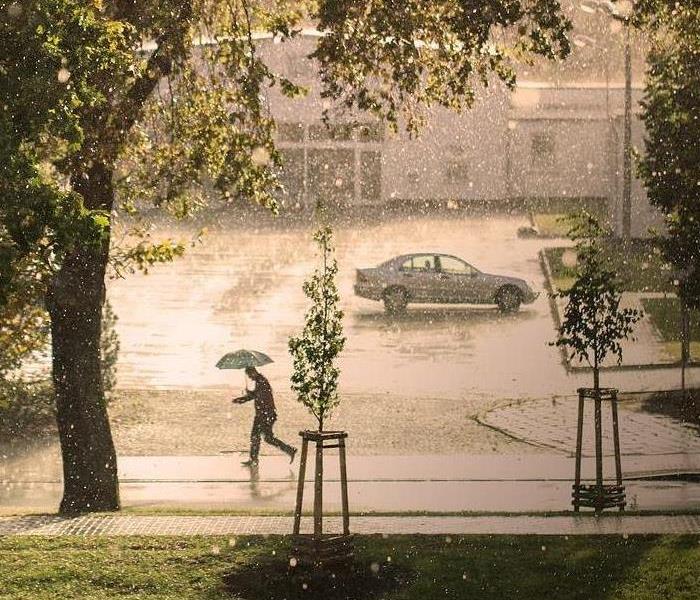 A rainstorm that has the possibility of causing damage.
A rainstorm that has the possibility of causing damage.
What a heat wave we have been experiencing lately in the northeast. I think everyone here in Jersey can agree that it finally feels like summer! We have been experiencing hot sunny weekends in the 90s, impromptu trips to the beach, and endless barbeques. But with hot weather comes brutal showers.
Severe thunderstorms pummeled across New Jersey and the Northeast these last few days, causing flooding on major roads, widespread ongoing power outages, fallen trees and utility lines, damage to homes and even fatality. SERVPRO of Hamilton & South Trenton would like to stress the severity and the potential threat storms can cause.
To keep from putting yourself at risk, we encourage our community to please stay away from storm-damaged areas, downed power lines that can potentially have live wires, and to never drive through a flooded road. During storms, use a battery-operated radio to get updates from local officials. Stay away from windows and doors. Make an emergency supply kit. We recommend having water, non-perishable food, flashlights and extra batteries, clothing and hygiene items, important documents, and cash.
As Always, SERVPRO of Hamilton & South Trenton are here to handle any water damages, no matter the home or business. Give us a call at (609) 604-8241 to set up a free inspection with us. We are here to serve our community!
SERVPRO Cares About Your Safety - Carbon Monoxide
6/3/2022 (Permalink)
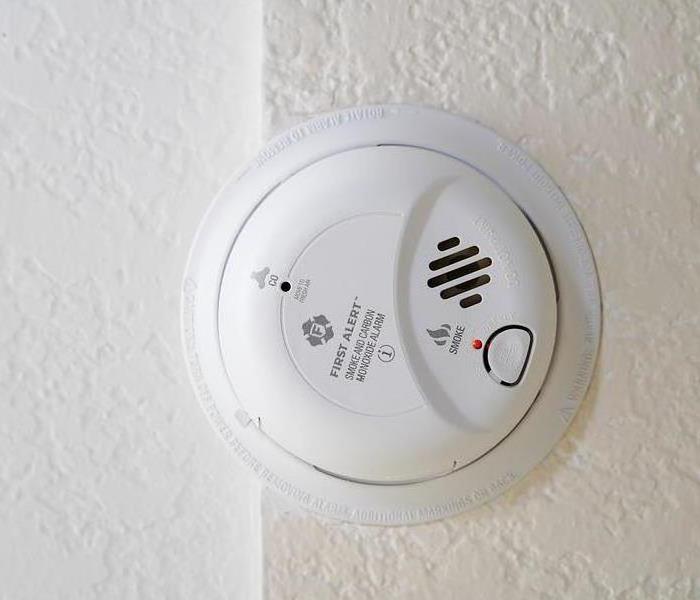 Carbon monoxide detector.
Carbon monoxide detector.
Your safety is always top of mind with SERVPRO of Hamilton, South Trenton.
Every year, hundreds of people in the US die from accidental CO poisoning, and 50,000 visit the emergency room.
Carbon Monoxide is an odorless and invisible fume generated by furnaces, kerosene heaters, portable generators, and similar fuel-burning appliances. Carbon Monoxide can build up in enclosed spaces and you can be poisoned and die from breathing these fumes.
Common symptoms of Carbon Monoxide poisoning include headaches, nausea, vomiting, chest pain, and confusion. Most people are poisoned while they sleep.
Here are some steps you can take to reduce the risk and prevent CO poisoning:
- Make sure you install a CO detector in different parts of the home and frequently check that the batteries are working.
- Never operate your car in a closed garage.
- Keep vents and flues clean of debris and blockages.
- Make sure your home heating system is inspected annually.
- Never operate a generator or other gasoline-powered equipment within 20 feet of an open window or door and never inside the home.
Remember, CO poisoning is preventable. If you suspect CO poisoning, do not wait, call 911.
Contact us at 908-650-8611 if you have a service need or click here to visit our website to learn more about SERVPRO of Hamilton, South Trenton's System Services.
Cleaning you Kitchen Exhaust System
6/3/2022 (Permalink)
The ventilation system above or next to your stove top serves several important functions in the kitchen. It helps remove moisture, smoke and odors, helps improve indoor air quality, and most importantly, helps trap flammable, aerated grease that is creating during the cooking process. Some states or cities require a ventilation hood to be present in the kitchen but even if your area doesn’t require one, you’ll want to make sure one is installed in your kitchen. Regularly cleaning and maintaining this ventilation system will help it function better, remove bacteria and mold, and reduce the risk of a kitchen fire.
Why your kitchen needs an exhaust system
In addition to whisking away odors, steam and smoke, a good ventilation or exhaust system will suck in and trap tiny grease and oil particles that would otherwise end up drifting throughout the kitchen and into rest of the home. Additionally, if you cook with natural gas, understand that a certain amount of nitrogen dioxide (along with carbon monoxide and formaldehyde) may be produced when cooking. These chemicals are bad for the lungs and can aggravate people with asthma or respiratory issues. When cooking, always turn on the exhaust system to help improve the indoor air quality.
How to clean the hood, filters and ventilation system
The exhaust system filters act as a trap for grease and oil and should be cleaned or replaced often. How often depends upon the type of filter system as well as how often you cook. If you wok fry food weekly, for example, a monthly cleaning will be necessary. But most find that a regular schedule of cleaning the filters every 3 months is the best way to keep a routine that you can stick to. Recirculating hoods use charcoal disposable filters and should be replaced every 6 to 12 months. Check with your manufacturer for more specific replacement or cleaning instructions.
To clean the wire mesh filters first remove them from the hood or ventilation system. You can either wash them by hand with warm soapy water (some find that baking soda works great too) or you can place them in an empty dishwasher and run a full cycle. You may need to repeat these methods if they are particularly greasy. Once they are clean, inspect them to insure there is no rusted or broken parts. Let them dry completely before placing them back in the ventilation system.
The rest of the ventilation system, like the hood, should also be periodically cleaned. Most hoods are made from stainless steel so use a cleaning product designed for this material or use one of ournon-toxic stainless steel cleaning recipes here. You’ll want to remove dust, grease and debris and always rub the stainless steel in the direction of the grain.
Commercial kitchens regularly have the entire exhaust system cleaned to remove grease and prevent dangerous fires. Homeowners can have this done as well; find a professional who is a member of the International Kitchen Exhaust Cleaning Association.
What happens if you don’t clean the stove ventilation system
The three biggest reasons for keeping the filters and ventilation hood clean are better indoor air quality, reduction of bacteria and mold, and fire risk reduction. As mentioned above, having a functioning and clean ventilation system will help create a healthier indoor air quality. This is especially important in the cooler months of fall and winter when many homeowners are cooking inside more and have the windows closed.
The warm and moist environment directly above a hot stove top is perfect for growing bacteria and mold, especially when there is a steady supply of food particles and oils. Dust can also stick to this grease buildup and create a nasty mess, not to mention a bad smell.
Kitchen fires are a very real hazard that you need to be aware of. When cooking on the stove, high heat mixed with oil can create a flame. If this flame is high enough, or near enough a grease-soaked filter, the flames can catch and spread. A grease or cooking fire can be very scary, spread quickly, and is responsible for 50% of reported residential house fires every year. Always keep a fire extinguisher labeled “for cooking fires” or with a “K” to put out a kitchen grease fire..
The Deception of Water Damage
6/3/2022 (Permalink)
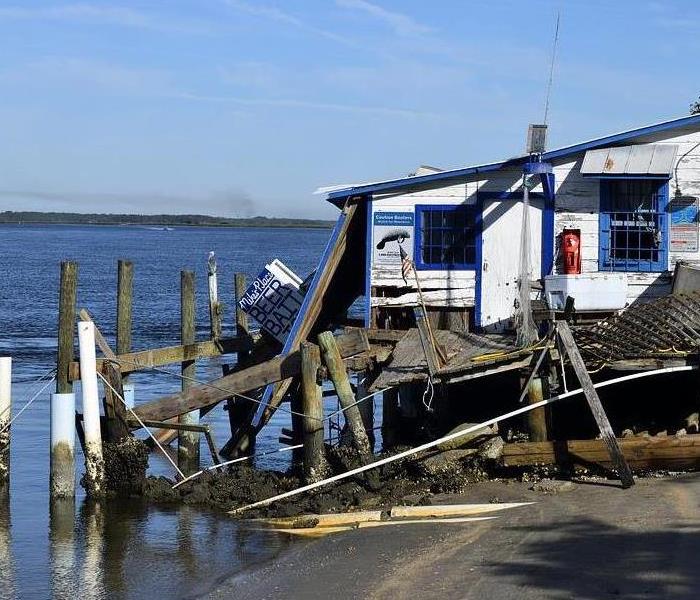 A house destroyed by a hurricane.
A house destroyed by a hurricane.
Water damage can be deceptive. Water penetrates into structural cavities creating trapped pockets of saturation. The detection of water in these areas can often only be discovered with sophisticated moisture detection meters. Undetected moisture will continue to cause damage. This damage, at a minimum, will cause odors. Greater damage will surface when materials delaminate, shrink, split and further deteriorate to where costly repairs are required.
More than just removing excess water, IICRC-certified (Institute of Inspection Cleaning and Restoration Certification) restorers have the knowledge and equipment to further dry a home or facility (including substructure materials) completely back to preloss conditions. Through timely response and the careful monitoring of water damage, mold and other issues can be prevented. If water damage has been present too long, mold will occur.
All IICRC-certified professionals have the training and experience to identify moisture sources, evaluate mold growth (visible or suspected), contain damage, remove contamination and dry materials to ensure that mold will not return.
Every technician in SERVPRO of Hamilton and South Trenton is Certified through the IICRC, and experienced in their craft.
Why is my window AC unit leaking water inside my house?
6/3/2022 (Permalink)
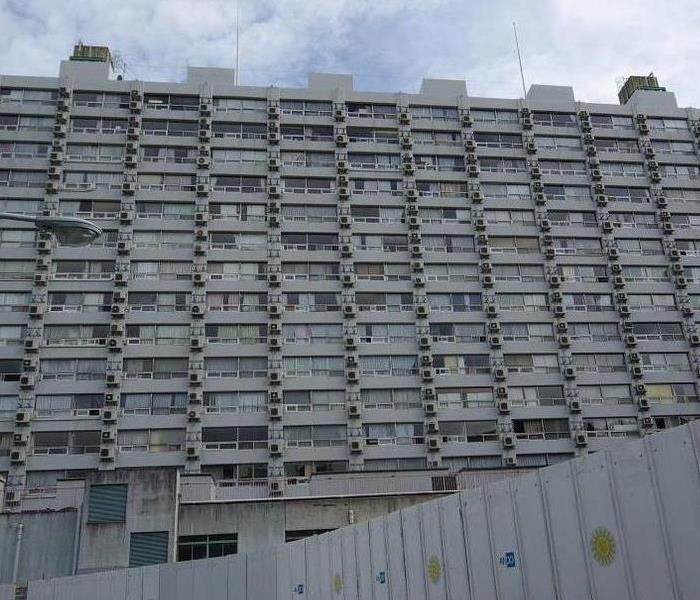 Building with multiple window AC units.
Building with multiple window AC units.
Question: I just turned my window AC unit on today and it is leaking water inside my house. What could be the problem? I had it running for 3 weeks and all of a sudden it started to leak. Water is on the plastic vent where the cold air blows out. I believe that is where it is leaking from but not sure. Can you tell me how to fix this?
ANSWER: You need to check a few things to be sure the ac unit is installed properly and there is no water drainage block present.
– Unplug the window AC unit.
– Clean up all the water on the AC unit, on the window ledge, and on the floor of your room.
– Check and be sure the AC is tightly sealed in the window.
– Do you feel warm air coming into the room around the AC unit?
– If you feel warm air coming in you need to seal it again.
– Check to see if the drain holes on the rear of the ac unit are blocked.
– Clean the drain holes to allow water to drip out.
– Make sure the filter is clean and not clogged with massive dirt or dust.
– After cleaning up the water and having it turned off for 30 minutes or so, then turn it back on to make sure the water doesn’t appear again.
Here are the reasons water can drip from a window air conditioner unit:
AIR LEAK – AIR CONDITIONER NOT PROPERLY SEALED IN WINDOW:
If your window air conditioner is not sealed correctly, the warmer air from outside gets inside the air conditioner. When this happens, the moisture that is in the warmer air will be condensed by the colder air inside the air conditioner. When there is excess moisture, the water will leak.
DRAIN IS BLOCKED – DIRT OR DUST HAS BLOCKED THE DRAIN HOLES:
There are drain holes (drip pan) at the rear of window AC units. They can get blocked from dusty conditions or dirt in the air. When this type of blockage happens, the water that would normally drip out will be trapped and water will leak from the front of the AC unit and at both sides of the unit. Be sure to keep the drain holes clean and free of debris. Also clean the filters or replace them to prevent any type of blockage that may cause a water leak.
OUTSIDE TEMP IS LOWER – HEAVY MOISTURE IN OUTSIDE AIR:
If it is raining or there is heavy moisture in the air outside, water evaporates much less than usual. This leads to excess water moisture in the air conditioner and this will cause water leaks. This is normal for most window AC units and using a drip pan can solve the issue if there is heavy moisture in the air outside.
CONDENSER PUMP NOT WORKING – BROKEN OR CLOGGED PUMP:
If the condenser pump in the AC is faulty or clogged, it will cause water to leak. You can check the condenser/pump if you feel confident. Check for any blockage or loose wires. If the pump seems to be okay visually, you will need to test the pump with a meter to see if it is faulty. If so, you may be better off buying a new AC unit.
If your home has experienced any water damage, the team at SERVPRO® is always available to help with cleanup and restoration, making it look “Like it never even happened.” Contact us at 908.650.8611.
Outdoor Entertaining
6/3/2022 (Permalink)
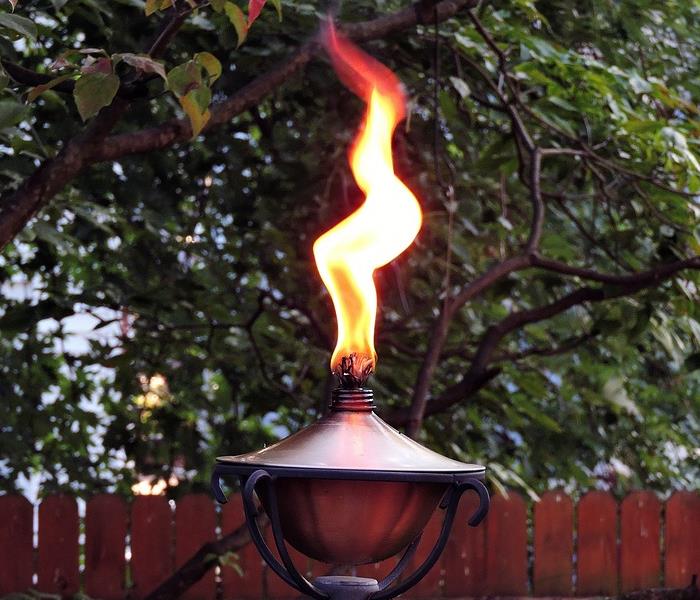 Open flame tiki torch in a backyard.
Open flame tiki torch in a backyard.
Summer outdoor parties are some of the best events of the year and one of the safest ways to enjoy summer in the midst of our ongoing pandemic.
The warm nights, food cooking on the grill, and friends and family spending quality time together in the backyard or around the pool create wonderful memories that last a lifetime. But, hosting outdoor events also means there’s an increased risk of home fires.
Fortunately, following some simple safety tips and guidelines can help ensure you and your guests stay safe. Consider the following as you host your next outdoor event:
- Have an adult present at all times when a portable fireplace is burning
- Use sturdy candle holders that won’t tip over easily
- Keep anything that can burn, as well as children and pets, at least three feet away from open flames
- Use battery-operated flameless candles and solar-powered patio (tiki) torches in place of an open flame. Flameless candles come in all colors, shapes, and sizes, and many are scented. Flameless candles look and feel like the real ones, and add a beautiful soft glow to any outdoor event.
Outdoor entertaining by the numbers
- Outside fireplaces or fire pits caused nearly 3,700 grass and brush fires
- Outdoor patio heater or fire pit injuries have grown each year
- More than half of all candle fires start when things that can burn are too close to the candle
- An average of over 8,800 home fires involved grilling activities each year
- Annually, sparklers, fountains, and novelties account for up to 25% of emergency room fireworks-related injuries.
Contact us at 908-650-8611 if you have a service need or click here to visit our website to learn more about SERVPRO of Hamilton, South Trenton System Services.
What You Need to Know About Air Duct Cleaning
6/3/2022 (Permalink)
Air duct cleaning is a misnomer. In actuality, the entire HVAC system should be cleaned. Failure to clean all components of the system can result in recontamination of the entire system, thus minimizing the benefits of cleaning.
Just as you wouldn’t clean only half of your living room floor, you also would not want to clean only part of your HVAC system. NADCA recommends cleaning the entire HVAC system, including the following components:
- air ducts
- coils
- drain pan
- registers
- grills
- air plenum
- blower motor and assembly
- heat exchanger
- air filter
- air cleaner
There are two key components to HVAC cleaning: breaking contaminants loose, and collection of contaminants.
Breaking Contaminants Loose
Properly cleaning HVAC systems requires removing the sources of contamination. Source removal begins with the use of one or more agitation devices designed to loosen contaminants from the surfaces within the heating and air conditioning system. Examples of agitation devices include: brushes, air whips and compressed air nozzles or “skipper balls.” Agitation can also be achieved through hand-brushing or contact vacuuming.
Collection of Contaminants
During cleaning, the entire HVAC system is placed under continuous negative pressure (a vacuum) to prevent the spread of contaminants. Continuous negative pressure allows very fine particles to be removed from the system as they become airborne, ensuring that these particles are not released into the living space when the system is turned on after cleaning. This negative pressure also serves to extract the loosened contaminants, which are collected and removed from your home.
System Access
HVAC system cleaning is not a complex process, but each job is unique. Where possible, access to duct interiors should be made through existing openings such as supply diffusers, return grills, duct end caps and existing service openings. Cleaning technicians may need to cut access holes in the duct work in order to reach inside with various cleaning tools. Creation of these service openings, and their subsequent closure, requires craftsmanship and professional skills.
Equipment Requirements
There is a wide variety of equipment available to HVAC cleaning professionals. Both truck-mounted and portable vacuums can be used to stop the spread of contaminants and get the system cleaned to the NADCA Standard.
Antimicrobial Chemicals
Antimicrobial chemicals include sanitizers, disinfectants and deodorizers that can be applied to nonporous surfaces in HVAC systems to address microbial contamination and help control odors. Only chemicals registered with the United States Environmental Protection Agency (EPA) can be used. These products should only be considered after mechanical surface cleaning has been performed and if the need for such treatment has been deemed necessary. Review the NADCA White Paper on Chemical Applications in HVAC Systems for more information.
Contact us at 908-650-8611 if you have a service need or click here to visit our website to learn more about SERVPRO of Hamilton, South Trenton's System Services.
Home Mold Testing - DIY Kit - Use With Caution
6/3/2022 (Permalink)
You can expect mold and mildew outside your home because of the damp natural conditions of the outdoors. Mold and mildew inside the house is a different problem because the inside of your home shouldn't remain damp.
The presence of moisture is the most significant contributor to mold growth. To fight the infestation, you should conduct a room-by-room assessment of the house to identify problem areas. The moisture can come from condensation due to poor ventilation (attic), from a water leak (around bathrooms), or outdoor intrusion (foundation walls).
Detection
Mold and mildew in a home are not always easy to detect if it exists within attics or is hidden within walls. If you suspect your indoor air quality is hindered by hidden mold, the best course of action is to contact an Industrial Hygienist (IH).
The IH will take both surface and air samples to detect the presence of mold on the structure. These two tests are essential to take in concert with each other as they will help detect the presence of mold in areas that cannot be seen or reached, such as in wall cavities. They will also help determine the severity and types of mold in a specific area of the home.
If you choose to take your own surface sample as a first step, mold detection kits can be purchased in most home improvement stores and are easy to use. Swab the surface in the area you're concerned about. Test results show in as little as 5 minutes, and much like a pregnancy test, you'll either see one line (negative results) or two lines (positive).
Use caution as these tests are not necessarily conclusive, given the absence of air samples and misinterpretation by the user. Only a trained professional should perform mold testing using the proper methods.
Even if your home test is positive, it does not necessarily mean you have a serious problem but that you should consider consulting a professional indoor air quality inspector or contact SERVPRO of Hamilton, South Trenton. You can also have an optional laboratory analysis of your test results conducted for an additional fee.
Click here to go to our website and learn a bit more about Mold Remediation.
Fighting the Mold you Find
If you discover mold on the home's interior, the first step in solving the problem is to eliminate the source of moisture—whatever that may be. Otherwise, any mold or mildew you clean is likely to return.
For minor problems, you may be able to clean the surface of the materials with an antimicrobial cleaner. For major problems, remove materials that cannot be thoroughly cleaned of mold-like insulation, carpeting, or drywall. Use your antimicrobial cleaner to clean the surrounding area as well as the places where you actually see mold and mildew, so make sure you remove all traces of the substances.
Finally, replace the removed building materials with new, mold-free materials.
Mold can be a serious issue with challenging aspects in remediating it properly. We highly recommend calling in a professional, like SERVPRO, to help you evaluate the proper steps before proceeding on your own.
Contact us at 908-650-8611 if you have a service need or click here to visit our website to learn more about SERVPRO of Hamilton, South Trenton's System Services.
PREPAREDNESS FOR PETS
6/3/2022 (Permalink)
 Two rottweiler puppies
Two rottweiler puppies
Have you accounted for Fido or Lucy when emergency planning?
After The Storm
After Hurricane Katrina, "It’s estimated that over 15,500 animals were ultimately rescued. Of the 15,500 animals rescued, only 15%-20% were ever reunited with their owners.”
Source: Louisiana Society for the Prevention of Cruelty to Animals, la-spca.org
Pets are just as important as any family member to most people, so why would you not make them a part of your preparedness planning? There are several things you can do to make sure they stay safe as well during an emergency.
Pet Emergency Kit
Ready.gov/pets lists the below items as essential to building your Pet Emergency Kit.
- Food. At least a three-day supply in an airtight, waterproof container.
- Water. At least three days of water specifically for your pets.
- Medicines and medical records.
- Important documents. Registration information, adoption papers, and vaccination documents. Talk to your veterinarian about microchipping and enrolling your pet in a recovery database.
- First aid kit. Cotton bandage rolls, bandage tape, and scissors; antibiotic ointment; flea and tick prevention; latex gloves, isopropyl alcohol, and saline solution. Including a pet first aid reference book is a good idea too.
- Collar or harness with ID tag, rabies tag and a leash.
- Crate or pet carrier. Have a sturdy, safe crate or carrier in case you need to evacuate. The carrier should be large enough for your pet to stand, turn around and lie down.
- Sanitation. Pet litter and litter box if appropriate, newspapers, paper towels, plastic trash bags and household chlorine bleach.
- A picture of you and your pet together. If you become separated, a picture of you and your pet together will help you document ownership and allow others to assist you. Add species, breed, age, sex, color, and distinguishing characteristics.
- Familiar items. Familiar items, such as treats, toys, and bedding can help reduce stress for your pet.
Evacuations
While practicing fire escape or evacuation plans, be sure to include pets. If an evacuation happens, don’t leave pets behind as they can be lost or injured.
Identification
Micro-chipping pets is a great way to locate them. Most veterinary clinics and shelters have scanners that will read the microchip information to help find a pet’s owners.
Be sure to take four-legged friends into consideration when planning for emergencies. Visit ready.gov/pets for further tips and safety precautions to think about for you or your insured’s families’ pets, or your tenant's pets’ during a disaster.
Contact us at 908-650-8611 if you have a service need or click here to visit our website to learn more about SERVPRO of Hamilton, South Trenton's System Services.
Why People Choose Us for Cleaning | SERVPRO® of Hamilton, South Trenton
4/18/2022 (Permalink)
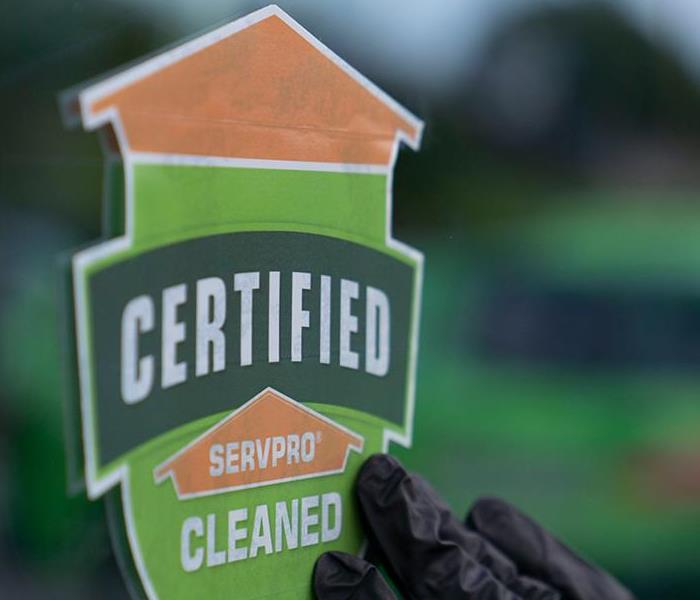 Contact us at 908.650.8611 for all of your spring cleaning needs.
Contact us at 908.650.8611 for all of your spring cleaning needs.
April showers bring May flowers, and a chance to tackle some spring cleaning! Spring is a great time to sweep those winter blues away and freshen up your environment. Luckily, SERVPRO is a pro in home cleaning.
We know how it is. Sometimes things just happen: spills on the carpet, pet accidents, and the general wear and tear of everyday life. These things take their toll on your carpets, upholstery, and other items. Sometimes you just need a deeper clean for your home than you can do yourself.
You need a professional cleaning company that can provide heavy duty cleaning services. That's when you can call the certified professionals at SERVPRO.
We can clean carpets, upholstery, drapes, blinds, window treatments, ceilings, floors, and walls. SERVPRO offers specialty cleaning services too, including HVAC/air duct cleaning, biohazard/crime scene cleanup, document restoration and odor removal.
So many of our restoration services, such as mold remediation and fire damage, involve the quality of the air in your home. When you call SERVPRO for your home's HVAC and air duct maintenance, we bring that experience and professional training, just as we do to any other restoration or cleaning project.
When you find your home has been invaded by a serious, persistent odor like smoke, pet, or sewage stench, it can be a challenging situation. Our team is trained to identify and eliminate offensive odors, whether they come from an inside or outside source. We won't simply mask odors but will use professional odor removal techniques to tackle the cause of the problem.
If you need a little spring-cleaning help, don't worry! SERVPRO's residential cleaning services will not only ease the burden of the constant maintenance of your home, but will also create a safe, clean, and comfortable living environment for your family.
Contact us at 908.650.8611 for all of your spring cleaning needs.
It’s Time to Prepare for Spring Storms | SERVPRO® of Hamilton, South Trenton
4/18/2022 (Permalink)
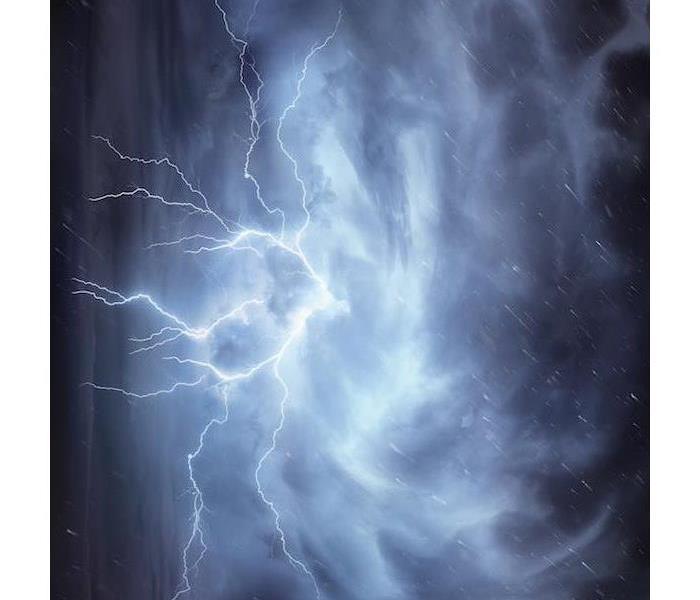 If your home/business is damaged in a storm, you can depend on SERVPRO of Hamilton, South Trenton to get the cleanup and restoration process started.
If your home/business is damaged in a storm, you can depend on SERVPRO of Hamilton, South Trenton to get the cleanup and restoration process started.
Spring is here! That means that, even though we are enjoying warmer weather, we also must now prepare for whatever Mother Nature may choose to send our way.
Spring = ThunderstormsWith the arrival of spring comes longer days and more sunshine, but it also brings the threat of severe weather throughout the country. It’s a toss-up this time of year, meaning the weather may change at moment’s notice.
Unstable temperatures are the cause of the changing weather, with temps that can go from warm to cold even in the same day. That temperature change can result in extreme weather changes as well.
Thunderstorms become more common during the spring and are the main cause of severe weather. A thunderstorm will occur whenever warm, moist air collides with cool, dry air, a common occurrence in the spring and summer.
In taking a look at natural catastrophe losses in the U.S. for 2017, severe thunderstorms were the most common and produced some of the costliest results. Out of 50 events, there were 85 fatalities and an estimated total of $25.4 billion in overall losses.
With these storms comes the threat of flooding, high winds and even tornadoes if the conditions are right. It has been found that in modern history, 10% of all violent tornadoes have occurred in March, with April, May and June taking the top spots at 30%, 24% and 15% respectively.
Make Sure Your Family Is PreparedWeather forecasters are not able to predict the weather with 100% accuracy, but fortunately, they do have the technology available to at least give us an idea of severe weather that could be coming. Advanced warnings, along with the right preparation, can greatly improve overall safety for your family.
Here are some things you can do to your home to prepare for the chance of severe weather:
- Clear out your home’s gutters, drains and downspouts.
- Trim trees of precarious limbs or branches that could break off in a storm.
- Secure or store outdoor belongings if severe weather is in the forecast.
Having an emergency kit on hand is always advised. These kits should include the following:
- Battery-operated flashlight and NOAA weather radio, with extra batteries for both
- Emergency evacuation or shelter plans
- Important personal info, like telephone numbers of neighbors, family and friends, insurance and property info, numbers for the utility companies, and medical info
- A first-aid kit with things like non-latex gloves, adhesive bandages, tweezers, sterile gauze pads, aspirin packets, adhesive cloth tape and scissors
- 3–5 day supply of bottled water and nonperishable food
- Personal hygiene items
- Blankets or sleeping bag
Despite its unpredictability, there is one thing that always remains true of the spring weather season: It always happens. If your home or business is damaged in a storm, you can depend on SERVPRO of Hamilton, South Trenton to get the cleanup and restoration process started fast.
SERVPRO of Hamilton, South Trenton Cares About Your Safety - Generator Safety
3/28/2022 (Permalink)
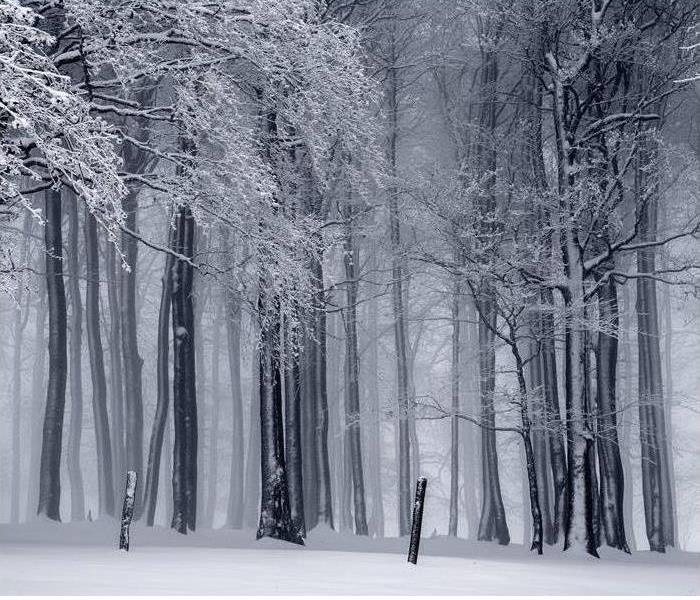 We are available for cleanup and restoration services 24 hours a day, seven days a week.
We are available for cleanup and restoration services 24 hours a day, seven days a week.
Winter season is upon us and power outages may follow. If you have a generator on hand for power outages during severe weather, follow the safety tips below provided by the American Red Cross.
- Never use a generator, grill, camp stove, or other gasoline, propane, natural gas, or charcoal-burning devices inside a home, garage, basement, crawl space, or any partially enclosed area.
- To avoid electrocution, keep the generator dry and do not use it in wet conditions. Operate it on a dry surface under an open canopy-like structure, such as under a tarp held up on poles. Do not touch the generator with wet hands.
- Opening doors and windows or using fans will not prevent carbon monoxide (CO) buildup in the home. Although CO can’t be seen or smelled, it can rapidly lead to full incapacitation and death. Even if you cannot smell exhaust fumes, you may still be exposed to CO. If you start to feel sick, dizzy, or weak while using a generator, get to fresh air immediately.
- Install CO alarms in central locations on every level of your home or property and outside sleeping areas to provide early
warnings.
Contact us at 908.650.8611 if you have a service need or click here to visit our website to learn more about SERVPRO of Hamilton, South Trenton's System Services.
SERVPRO of Hamilton, South Trenton Cares About Your Safety - Carbon Monoxide
3/28/2022 (Permalink)
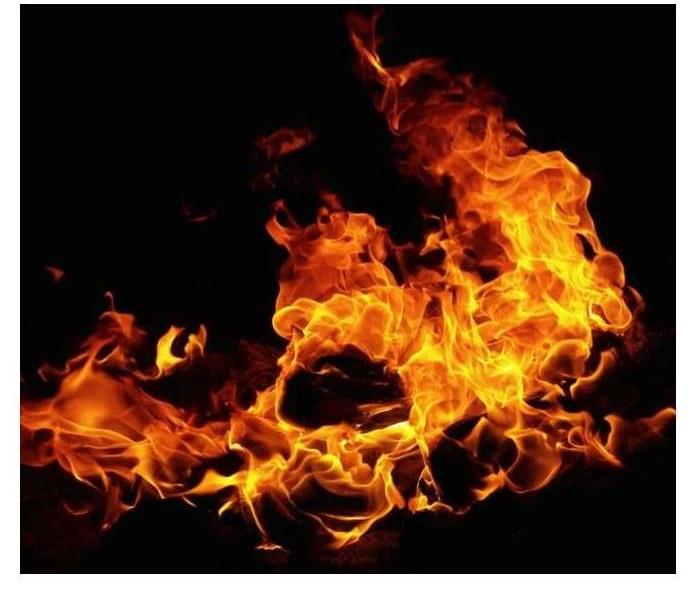 Our trained experts are here to help 24/7—contact us today.
Our trained experts are here to help 24/7—contact us today.
Your safety is always top of mind with SERVPRO of Hamilton, South Trenton.
Winter months present a particular concern with accidental carbon monoxide poisoning. Every year, hundreds of people in the US die from accidental CO poisoning, and 50,000 visit the emergency room.
Carbon Monoxide is an odorless and invisible fume generated by furnaces, kerosene heaters, portable generators, and similar fuel-burning appliances. Carbon Monoxide can build up in enclosed spaces and you can be poisoned and die from breathing these fumes.
Common symptoms of Carbon Monoxide poisoning include headaches, nausea, vomiting, chest pain, and confusion. Most people are poisoned while they sleep.
Here are some steps you can take to reduce the risk and prevent CO poisoning:
- Make sure you install a CO detector in different parts of the home and frequently check that the batteries are working.
- Never operate your car in a closed garage.
- Keep vents and flues clean of debris and blockages.
- Make sure your home heating system is inspected annually.
- Never operate a generator or other gasoline-powered equipment within 20 feet of an open window or door and never inside the home.
Remember, CO poisoning is preventable. If you suspect CO poisoning, do not wait, call 911.
Contact us at 908.650.8611 if you have a service need or click here to visit our website to learn more about SERVPRO of Hamilton, South Trenton's System Services.
How We Approach Restoration Differently | SERVPRO® of Hamilton, South Trenton
10/11/2021 (Permalink)
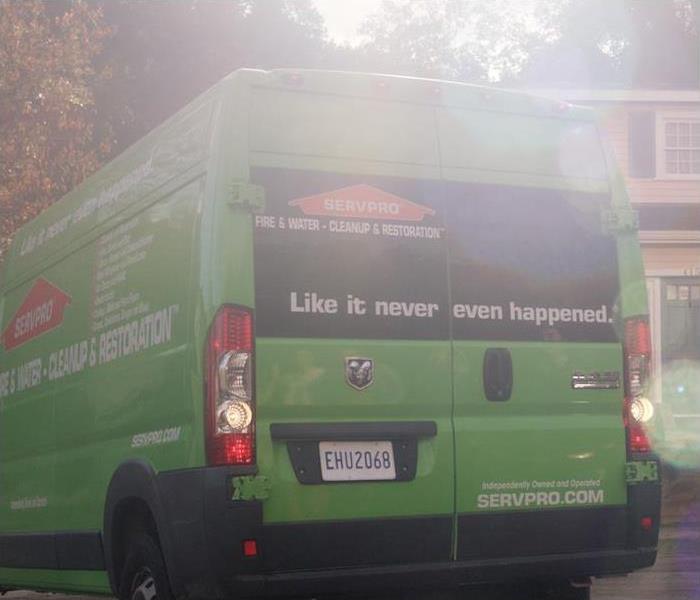 A quick response time with an alert team will ensure that your restoration needs are professionally completed by SERVPRO of Hamilton, South Trenton.
A quick response time with an alert team will ensure that your restoration needs are professionally completed by SERVPRO of Hamilton, South Trenton.
There is a lot that goes into choosing a restoration company as a homeowner. Not only are you picking someone to restore your home, but you are also forced to make a big decision during a stressful time in life. Choosing the right company will give you peace of mind and make your experience a positive one, but it’s important to pick one that is trustworthy.
Because there are so many types of damages that can occur from a disaster, it is important to choose a company that can handle a variety of situations.
When water damage turns into structural damage or a small kitchen fire releases toxic soot particles into the air, homeowners will want a company that can handle the entire situation. Seeking a company that can handle complications is essential for a positive experience.
Our Approach to Restoration
Our restoration jobs are just as much about providing excellent service as they are restoring your home. These are the ways in which we approach restoration differently:
With a Guaranteed Quick Response Time
Emergencies do not have respect for anyone’s schedule, which is why we do not have business hours. Our emergency service line is an around-the-clock service, meaning you can call us 24 hours a day to report the damage. Once we receive the call, our technicians will spring into action in order to get to you ASAP.
With an Experienced Team
Our restoration technicians are industry leaders with proven results. Trained according to IICRC standards, they will ensure the most up-to-date methodology is used in your restoration for any type of damage.
With a National Network
Our franchise locations are located across the country with over 1,700 locations. This means that we have a national network to utilize for resources. Therefore, we can treat a large-scale disaster with the same care and efficiency as we would an isolated spot of thunderstorm damage.
If you have experienced storm damage, we are always here to help! Call our restoration experts 24⁄7 so we can address your damages quickly.
Taking Water Damage Into Consideration | SERVPRO® of Hamilton, South Trenton
10/11/2021 (Permalink)
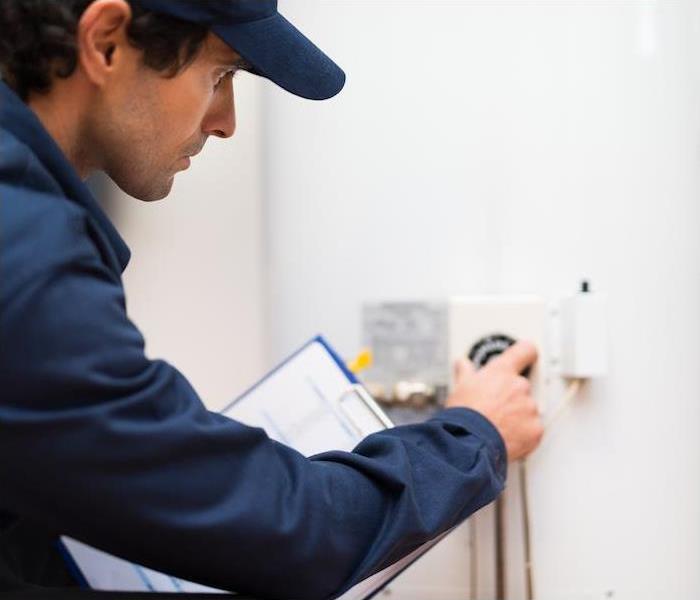 Water damage can happen at any time. SERVPRO of Hamilton, South Trenton will ensure that each water mitigation job is done correctly and completely.
Water damage can happen at any time. SERVPRO of Hamilton, South Trenton will ensure that each water mitigation job is done correctly and completely.
Water. Let’s face it—we need it to live—everything needs it! But what we don’t need is for it to be causing damage to our property and our homes.
When it comes to damage caused by water, there are many reasons it happens. How many of those reasons are you aware of?
Common CausesThe most prevalent reasons for a filed homeowners insurance claim are:
- Wind damage
- Water damage from sources other than weather
- Hail
- Weather-related water damage
- Burglary
Water damage is so common that it appears on this list twice, in two different categories. To make it simple, remember that it can be classified as non-weather-related and weather-related.
Water damage that is not caused by weather occurs most often in the home and is the result of plumbing and appliance malfunction issues. Water damage caused by weather can cause just as big of headache but does not occur as often. Weather-related water damage is caused by events such as rain, snow or melting ice.
The top five reasons for water damage in the home are plumbing, appliance leaks, water pipe issues, older water heaters and weather.
Water Damage PreventionWhile water damage can be pricey, it could be even more pricey if a homeowner is not covered by homeowners insurance. Check your homeowner policy for your coverages. In most cases, damages that are covered in a standard policy are:
- Damages caused by winter weather
- The expulsion of water, even if it is accidental
- Damaged or broken down hot water heating system
- Plumbing that freezes
Fortunately, there are ways to keep water damage from occurring, thereby saving yourself some headaches in the future.
Here are some ideas for preventive maintenance to help you protect your home as much as possible from the damage caused by water:
- Hire a plumber to install back flow valves and standpipes in basement drains.
- Raise your appliances and personal items up off the basement floor.
- Clean all gutters and downspouts.
- Never place grease down the kitchen drain.
When you follow these suggested tips, you just might reduce the probability for any water damage incidents in your home.
Water damage can be a nightmare to deal with but fortunately, you will always have SERVPRO® of Hamilton, South Trenton on your side to help with the cleanup and restoration process.
An Introduction to Mold Remediation | SERVPRO® of Hamilton, South Trenton
10/8/2021 (Permalink)
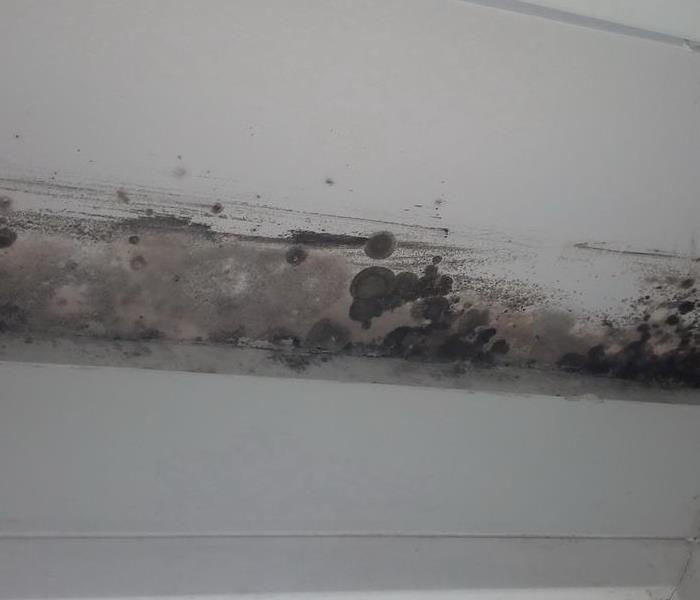 If the worst should happen and your business is damaged, know that SERVPRO® of Hamilton, South Trenton will make it "Like it never even happened."
If the worst should happen and your business is damaged, know that SERVPRO® of Hamilton, South Trenton will make it "Like it never even happened."
When there is water damage in a commercial property, mold growth will likely follow. Mold can begin to grow within 48 hours after moisture exposure.
If you are ever facing a mold issue, knowing what steps to take is very important, which is why we have chosen to use this blog to discuss the subject of mold remediation.
Mold Remediation, Not Removal
Mold remediation and mold removal ads are everywhere, and you’ve probably seen ads for these services, but the truth is there is no such thing as mold removal. Removing all mold from a home or business is simply impossible. Instead, a qualified restoration company focuses on mold remediation, which in turn brings mold levels back to a normal and natural level.
Mold spores occur naturally almost everywhere, both inside and outside. The issue arises only when a minor mold problem is left untreated and then turns into a major mold issue.
During mold remediation, the contaminated areas will be isolated by technicians. Depending on the amount of remediation required, this would be done by either closing all doors and windows or sealing off all doorways and openings with polyethylene sheeting. The technicians will use a method called “misting” to suppress the dust in the contaminated areas.
Materials that are wet and mold-damaged are removed and discarded in plastic bags. Any areas that have been exposed to and affected by the mold are then thoroughly cleaned and dried. A HEPA vacuum may be brought in at sometime during the remediation process to help remove contamination and debris.
Then, the mold-affected area is treated with a biocide and left overnight to start killing the mold spores. The following day, the mold remediation crew will return and encapsulate the affected area and beyond.
When to Contact a Professional
If you believe your business may have been affected by mold, you’ll want to act quickly. Upon evaluation of the size of the problem, and if the moldy area is more than 10 square feet, you will want call in the professionals.
The professionals you hire for mold remediation should be highly trained and certified in areas such as:
- Applied microbial remediation
- Water damage restoration
- Applied structural drying
While some minor mold issues can be successfully resolved by home and business owners on their own, it is always safest to talk to professionals and get the remediation process started quickly before further damage sets in.
At SERVPRO® of Hamilton, South Trenton our mold damage specialists are trained and certified experts in mold remediation. If your home or business is experiencing a mold issue, contact us to begin the mold remediation process.
The Dangers of Lightning During Storms | SERVPRO® of Hamilton, South Trenton
10/8/2021 (Permalink)
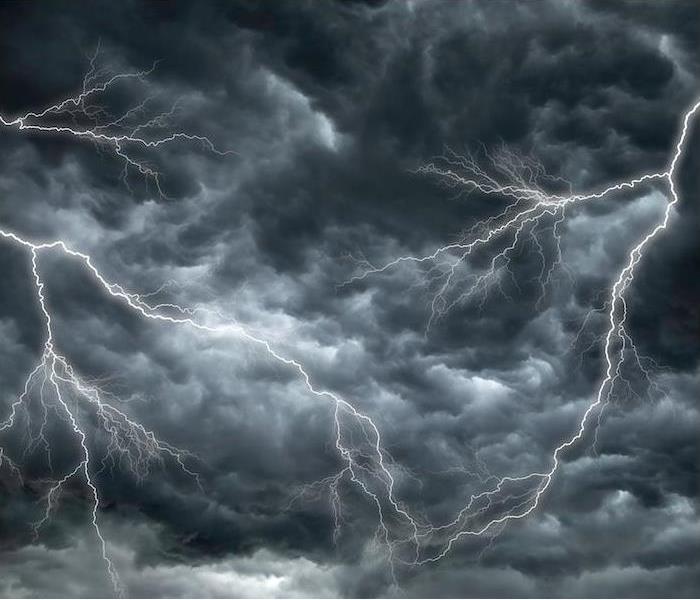 Storm & lightning damage require specialized restoration techniques and equipment. When a storm hits your home, you need the company with experience.
Storm & lightning damage require specialized restoration techniques and equipment. When a storm hits your home, you need the company with experience.
There are many ways in which a thunderstorm can cause damage. Flooding or wind damage are what often come to mind, but it is also important to consider the risks associated with lightning when discussing thunderstorms.
While some storms bring rain and water, every storm is made up of electricity, creating the possibility for lightning even in the absence of precipitation. Lightning bolts can be up to 500,000 degrees, causing damage and even fatalities when they strike. An understanding of what lightning is and how it can be dangerous is extremely helpful in helping homeowners prevent these risks.
How Thunderstorms and Lightning CoexistAll thunderstorms contain the electricity that makes a lightning strike possible. What we know as a lightning strike is actually a rapid burst of electricity that occurs when this charge becomes agitated.
The atmosphere is not an ideal conductor, which is why lightning tends to strike objects—this creates a less resistant route in getting to the ground. When a home is the object that has been struck, lightning will usually forge this path through water pipes and wiring.
How Lightning Is Dangerous to HomesWhile there are many dangers surrounding thunderstorms, there are [three main ones involved with lightning striking a house]:
The risk of fire. One of the biggest dangers of a lightning strike to a house is the fire hazard it causes. Lightning is hot enough to ignite building materials, causing a fire to break out at the point of impact. Additionally, lightning traveling through wires can cause them to fray, creating fire hazards all throughout the home.
The risk of power surges. Because of the electrical charge at play with lightning, it can easily transfer that to the wiring in the home. This is what we call a power surge, which can affect any electronic device plugged in that is not routed through a surge protector.
The risk of shock waves. Shock waves are typically manifested in thunder, but they can also occur at the site of a lightning strike. Shock waves have been known to crack chimneys, break windows and explode cinder blocks, making them extremely hazardous to a home’s structure.
If your home has been affected by storm damages or lightning-related fires, give us a call today! We are experts in damage cleanup and can restore your damage quickly.
Why Business Owners Choose Us for Restoration
10/7/2021 (Permalink)
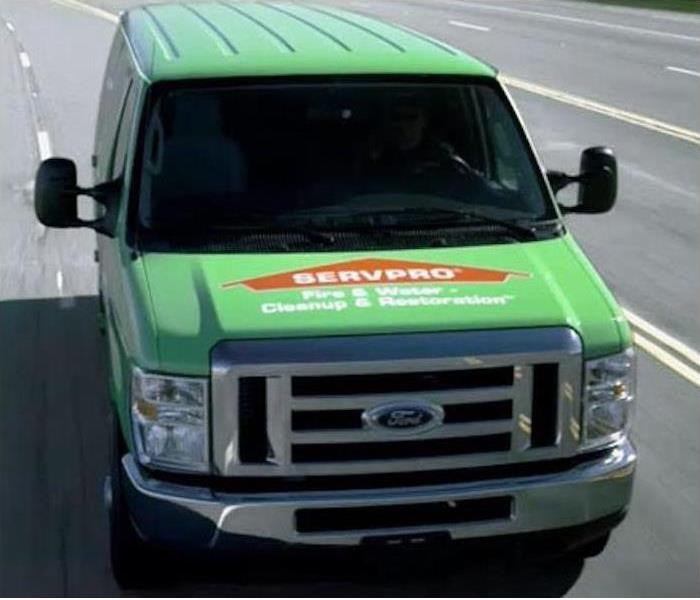 Our trained experts are here to help 24/7—contact us today.
Our trained experts are here to help 24/7—contact us today.
For many business owners, sustaining damage to their business can damage more than just their property—it can also damage their entire venture. In a recent FEMA study, they determined 40 to 60% of businesses will not reopen following a natural disaster. That is why if your business has sustained fire, water or mold damage, either due to a disaster or any other cause, it is important to choose a company that is well-versed in commercial restoration.
We know how important your business is to your livelihood, which is why we make it our mission to be experts in commercial restoration. Having a team you trust on your side will help you focus on other crucial business aspects and help get your doors open again faster. These are just a few of the reasons why business owners have chosen us for commercial restoration:
1. We’re Proud of Our Response Time
You may be aware that our slogan is “faster to any size disaster,” but that’s more than just something we say. Our emergency line is open 24⁄7, 365 days a year to ensure our restoration experts are alerted right away when a business owner calls to report the damage.
A quick response time not only gives business owners peace of mind, but it also makes the restoration process more efficient. By getting to the scene quickly, our technicians can stop further damage from occurring, saving both time and money on the project. This makes for one less thing business owners have to worry about as they get their business on track to reopen.
2. We’re Proud of Our Technicians
Our technicians are leaders in the restoration field because of the education and training they receive. They study the guidelines set forth by the Institute of Inspection, Cleaning and Restoration Certification (IICRC) to learn about best practices, restoration techniques and other insider tips in the field.
Technicians also have the opportunity to further their education through certification programs, online courses and other industry knowledge throughout their employment. This allows them to be prepared for any damage scenario your business might face.
3. We’re Proud of Our Equipment
The materials and procedures we use on commercial restoration projects comply with the IICRC’s guidelines, ensuring we are tackling the job with the most advanced tools in the industry.
From water extraction machines following flooding or odor removal equipment to remove smoke after a fire, we’ve got the tools to make your commercial remediation a success.
If you’re in need of commercial restoration, do not hesitate to make the call so you can get your business back faster. Our trained experts are here to help 24/7—contact us today.
Learn More About Our “Restore First” Mentality
10/7/2021 (Permalink)
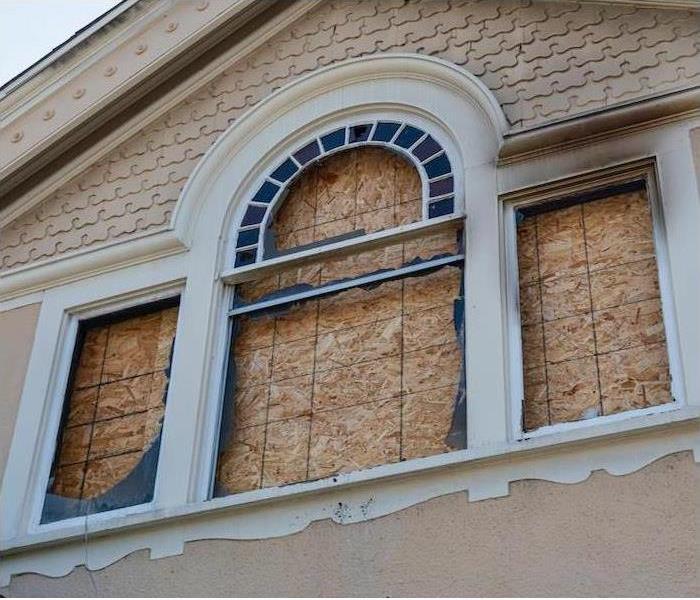 Our team of highly trained restoration experts are available for emergency cleanup and restoration services 24 hours a day, seven days a week.
Our team of highly trained restoration experts are available for emergency cleanup and restoration services 24 hours a day, seven days a week.
When disaster strikes, we get there fast, but that is not the only reason why we need to be first on your list of calls if the worst should occur.
What sets us apart—our team of technicians have a “restore first” mentality, complemented by specialized equipment and cleaning techniques. By making this our mission, we are able to minimize potential disruptions to your home and life and get you back into your home as quickly as feasible.
How It Works
When a fire has damaged your property, it’s a scary time, but once you reach out to our team, we’ll take some of the weight off your shoulders.
No two fires act the same, so it’s logical that the damage they inflict would also be different. That’s why we believe in starting with a standardized process, but adding onto it and enhancing it to meet your individual needs.
1. You call us. When you reach out via our 24⁄7 Emergency Line, we will spring into action. Our first step is to ask you questions about the fire and your home’s unique space and needs. That set of questions helps inform our strategy.
2. We inspect and assess the fire damage. Our next step is to visit your home. During this visit, we will inspect and test adjoining rooms of the property to determine the extent of fire, smoke and soot damage. Based on what we see and determine, we will take immediate next steps.
3. We board up windows and tarp the roof. Because fire damage often compromises windows, walls and roofs, we will make sure that your property is secured and protected from further damage. This will involve boarding up missing windows and walls and placing a tarp over the top of damaged roofs.
4. We remove water and begin the drying out process. When we think of fire, we don’t think of water damage. But we should, because water is a necessary component of fighting fires. So our next step is to remove any standing water and start drying out objects and spaces when possible.
5. We remove smoke and soot from all surfaces. We use specialized equipment and techniques to remove smoke and soot from ceilings, walls and other surfaces in your home.
6. We clean and sanitize your home. This is another place where the “restore first” mentality comes into play. We will attempt to clean objects and surfaces whenever possible, rather than removing and replacing them. We also use industrial air scrubbers and fogging equipment to help remove odors.
7. We complete the restoration. This is our final step, bringing your property back to the condition it was in before the fire. Restoration may involve minor repairs like replacing drywall, painting and installing new carpet. It could also involve major repairs like reconstruction of damaged areas.
Remember, if you need us, we’ll be there—no matter the time or day. Our team of highly trained restoration experts are available for emergency cleanup and restoration services 24 hours a day, seven days a week.
How to Protect Your Home from a Fire When Electricity Returns| SERVPRO® of Hamilton/South Trenton
8/18/2021 (Permalink)
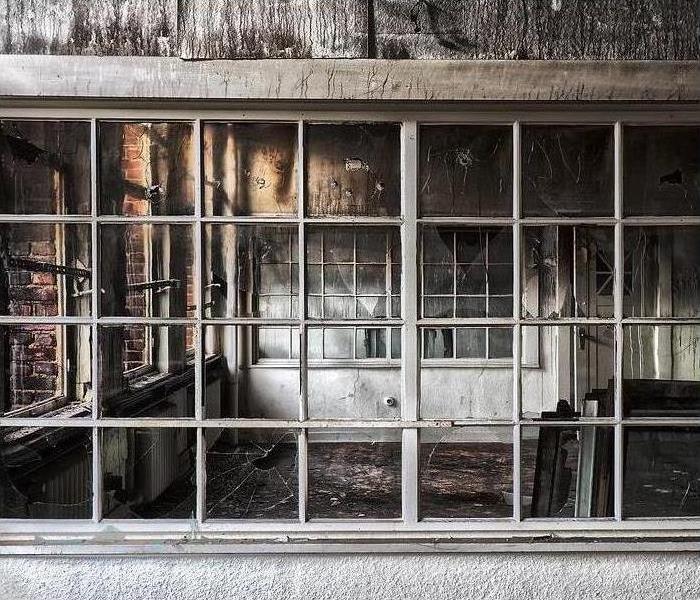 Having a team on your side after a disaster can help relieve stress. SERVPRO® of Hamilton, South Trenton is here to help 24/7.
Having a team on your side after a disaster can help relieve stress. SERVPRO® of Hamilton, South Trenton is here to help 24/7.
Did you know that when your power comes back on, the initial surge can cause damages to your appliances or possibly a fire if they are still plugged in.
In the United States, it is reported that a home fire is put on record every 24 seconds according the NFPA. That works out to be nearly 8,600 house fires a day.
Though the vast majority of house fires are cooking related, surges, malfunctioning appliances and frayed wires or cords are also often to blame. Because fire can spread rapidly and can quickly consume an entire house, it is essential to be vigilant in prevention for the safety of your household (even during a disaster).
Prevention Tips When The Power Goes Out
- Walk around an unplug bigger power users, television, computers, appliances, and turn off smaller ones like lamps and radios.
- Turn off the main supply of power to the house or remove the fuses.
- During summer months, turn the air conditioner off.
By following these tips, you can mitigate the risk of frying your electronics or overloading your house’s circuits.
When The Power Comes Back On
Once the power returns, wait a few minutes before turning on the main supply switch. To give the electrical system a chance to stabilize, turn on essential appliances first, then gradually turn on other electronics.
Restarting appliances all at once can almost double the amount of electricity that they use when running normally. When the main switches are re-energized, this demand can cause breakers to trip. It helps if you don't have all your appliances waiting to draw power the instant it is restored.
Fire and smoke damage can be devastating to your home, and in many circumstances, can be accompanied by water damage. If your home is damaged by fire or smoke, we are here to help restore your home to pre-fire condition. Contact us at (908) 650-8611.
We are available for cleanup and restoration services 24 hours a day, seven days a week.
Commercial Clean-ups| SERVPRO® of Hamilton & South Trenton
8/18/2021 (Permalink)
 Call us to make it, "Like it never even happened."
Call us to make it, "Like it never even happened."
Commercial cleaning and restoration present unique challenges. Our goal is to provide excellent results while minimizing the disruption to your clients. SERVPRO of Hamilton & South Trenton are fully equipped to take on your commercial property no matter the size of the job.
Commercial Services:
- Air Ducts / HVAC
- General & Specialty Cleaning
- Post Construction Cleaning
- Punch List Services
- Dry Ice Blasting
- Power Washing
- Biohazard & Sewage
- Odor Removal / Deodorization
We offer our services to any time of commercial property:
- Small/Large Office Buildings
- High-Rise Office Buildings
- Apartment Buildings
- Restaurants
- Hotel/Motels
- Small Retail Stores
- Large Retail/Big-Box Stores
- High-Rise Residential
- Manufacturing & Industrial
- Government/Military
For any additional information, please feel free to contact our office for all of your commercial property needs.
How to Prevent House Fires | SERVPRO® of Hamilton, South Trenton
8/3/2021 (Permalink)
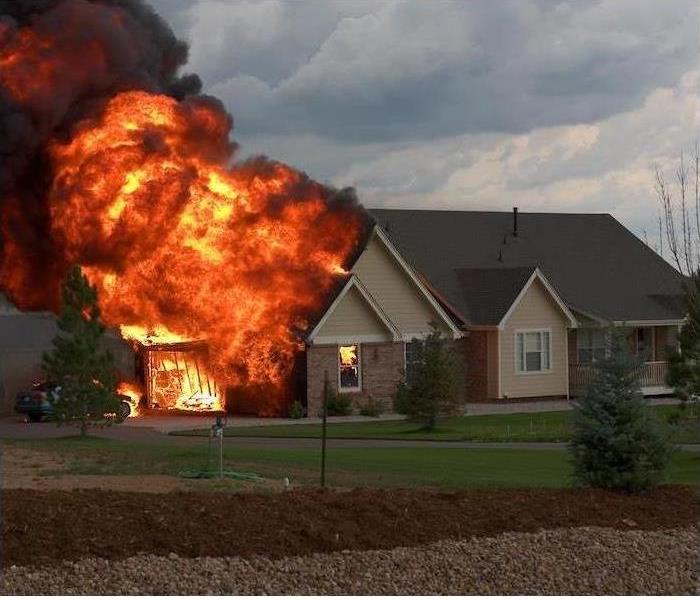 If your home has suffered damage from a house fire, give us a call. We are certified in fire and soot remediation, and here to help 24/7.
If your home has suffered damage from a house fire, give us a call. We are certified in fire and soot remediation, and here to help 24/7.
Smoke alarms are a great tool for house fire prevention, but they are not the only way to lessen your risk.
The causality of house fires is varied, but one thing that is consistent is how frequently they occur. By learning about the statistics and proven prevention methods, homeowners can keep their families safe.
The Numbers Behind House Fires
In the United States, it is reported that a home fire is put on record every 24 seconds according to the NFPA. That works out to nearly 8,600 house fires a day.
Though the vast majority of house fires are cooking-related, malfunctioning appliances, frayed wiring or cords, and carelessness with open flames are also often to blame. Because fires spread rapidly and can quickly consume an entire home, it is essential to be vigilant in prevention for the safety of your household.
House Fires Prevention Tips
Being proactive is the best defense against house fires. By keeping these fire prevention tips in mind, you can minimize your risk and keep your home safer:
Maintain smoke detectors. Maintain your smoke detectors by testing them each month and replacing them every 10 years.
Clean the dryer. After each load of laundry is dried, make a point to clear lint from the tray. Lint can build up and become a fire hazard when the dryer gets warm.
Keep an eye on open flames. Fires can start and spread faster than you think, which is why it is never wise to leave the room when there is an open flame. Whether it is a candle, cooking flame or fireplace, always keep an eye on them.
Maintain electrical cords. Cords and electrical wires should be checked often for frayed spots and immediately replaced if they are present. Never run electrical cords under rugs or behind furniture, as they can produce heat.
Read product labels. Chemicals in household products can be highly flammable, and so can products that come in aerosol cans. Keep these away from sunlight or heat sources.
Avoiding Fire Hazards While Cooking | SERVPRO® of Hamilton, South Trenton
8/3/2021 (Permalink)
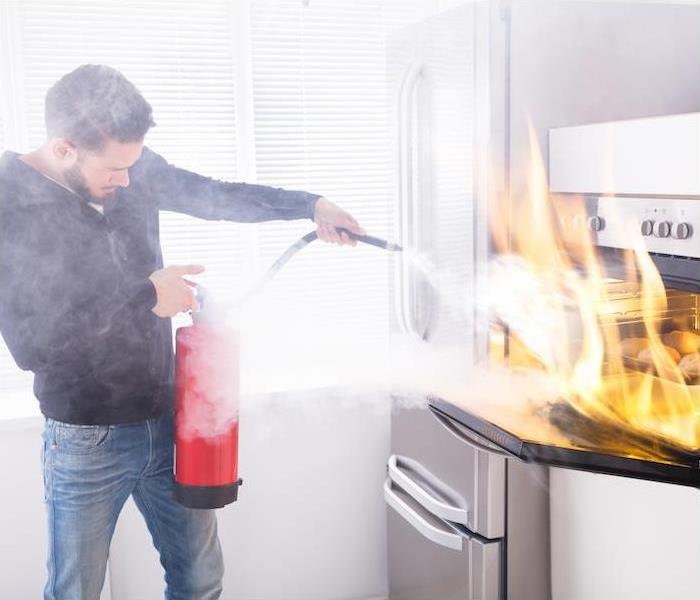 If your home has experienced damage from a cooking fire, know that we are here to make it “Like it never even happened."
If your home has experienced damage from a cooking fire, know that we are here to make it “Like it never even happened."
Even though the kitchen can be a wonderfully versatile place for family and friends to gather to enjoy a fresh-cooked meal or to spend quality time together, danger can lurk. Unfortunately, home fires can often begin in the kitchen.
Fires resulting from cooking are the No. 1 cause of home fires and injuries and, often, the leading cause of these kitchen fires is unattended cooking.
Over $130 million in homeowners insurance claims that were related to grease and other cooking fires were paid out in 2017 by State Farm Insurance. According to the insurance company, these are the worst states for kitchen fires:
- North Carolina
- Texas
- Pennsylvania
- California
- Ohio
- Illinois
- Maryland
- New York
- Alabama
- Georgia
Staying Safe in the Kitchen
There are other safety tips to look into, as well as the well-known tip of remaining in the kitchen while cooking. Here are some other helpful tips to observe while cooking:
1. Be careful of your clothing. If you are wearing long, flowing sleeves or loose fitting clothing, it is best to change into a short or close-fitting sleeved shirt or make sure any loose shirts are tucked in or tied back away from the stove. Loose clothing could catch fire if you aren’t careful and get too close while cooking over the stove.
2. Be aware of what you are placing on or near the stovetop. Make sure there are no kitchen towels, oven mitts, appliance cords or even curtains too close to the stovetop when cooking. Ideally, it is best to move anything flammable away from the stove.
3. Place a fire extinguisher in or close to the kitchen. It is best to have at least one fire extinguisher located in your home and, ideally, one that is near your kitchen. Make sure you know how to properly use the extinguisher, just in case it is ever needed.
4. Wait before throwing hot grease in the garbage can. Even if the grease may not be on fire, it could still be hot enough to cause something in the trash to burn. Letting the grease cool a bit and then disposing of it in an old coffee can is safest. Also, know the smoke points of the oils you cook with. Be sure to never subject a low-smoke point oil to high heat when cooking, as it could catch fire.
5. Be sure there is a fire escape plan established. Thinking about the worst that can happen is not fun, but it’s better if you are over-prepared rather than unprepared if an emergency were to occur. Go over exit routes and designated meeting points with your family, making sure that everyone knows what to do.
Fire safety in the kitchen is an absolute necessity, as it can help prevent dangerous and destructive cooking fires. If your home has experienced damage from a cooking fire, know that SERVPRO of Hamilton, South Trenton is here to make it “Like it never even happened.”
Make Sure Your Business Is Ready for Potential Disasters | SERVPRO® of Hamilton, South Trenton
8/2/2021 (Permalink)
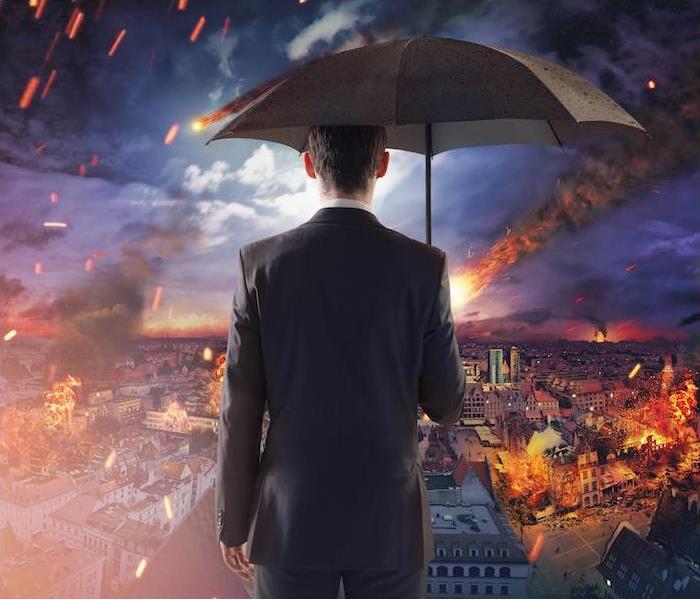 If the worst should happen and your business is damaged, know that SERVPRO® of Hamilton, South Trenton will make it "Like it never even happened."
If the worst should happen and your business is damaged, know that SERVPRO® of Hamilton, South Trenton will make it "Like it never even happened."
When you are a business owner, one of the most important factors to think about is emergency preparedness.
Disaster are going to happen, and while having a plan in place cannot stop all disasters, it can still offer a certain sense of security and at least ensure that your employees are aware of what to do if a disaster or emergency situation should occur.
What’s Your Plan?
Please take the time and make it a priority to sit down and work out an emergency preparedness plan for various disaster situations that could affect your business!
There are numerous emergencies your business should have a preparedness plan in place for, including:
- Fire
- Severe weather, including thunderstorms and winter storms
- Other natural hazards like floods, hurricanes, tornadoes and earthquakes
- Human-caused hazards, including accidents or acts of violence
- Technology-related issues like power outages and equipment failure
When disaster strikes, it doesn’t matter if it’s a man-made incident or natural, if no emergency plan is in place for your business, things could get even more stressful quickly.
You should make sure that safety training and familiarization of emergency preparedness plans are included in the company onboarding process, team-building activities and continuing education opportunities. By encouraging your employees to familiarize themselves with proper safety protocol and emergency procedures, you’re not only giving them the tools to protect themselves, but you are also setting them up to help protect guests/visitors and the business itself.
Where to Begin
In beginning to set up an emergency plan for your business, start by evaluating which scenarios are most likely to occur—and go as far as considering the longshots that could still happen. After all, it’s better to prepare for all the worst-case scenarios and not be caught off guard.
There are plenty of online resources to help guide you through this process, including Ready.gov, the American Red Cross, FEMA and the CDC.
If you have a business impact analysis (BIA) done, it will help predict potential effects a disaster may have on your business. This would include lost or delayed sales and income, increased expenses from repairs, and delayed implementation of business plans. Don’t forget to make sure a crisis communications plan is in place, too.
Once you have come up with an emergency preparedness plan, be sure to review it and practice it with employees. Reviewing and rehearsing various scenarios can help ensure the process remains fresh in their minds and can help employees feel more empowered.
Disaster can strike when you least expect it, but by being prepared and having a plan in place, your business will be better suited to handle whatever Mother Nature has in store. If the worst should happen and your business is damaged, know that SERVPRO® of Hamilton, South Trenton is here to help make it “Like it never even happened.”
Does Your Business Have a Natural Disaster Plan? | SERVPRO® of Hamilton, South Trenton
8/2/2021 (Permalink)
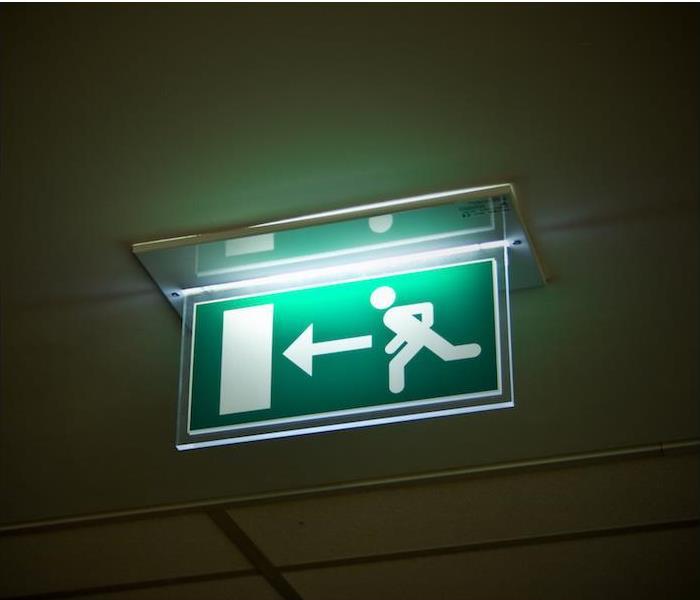 When it comes to the cleanup and restoration aspects, depend on SERVPRO® of Hamilton, South Trenton to be there for you.
When it comes to the cleanup and restoration aspects, depend on SERVPRO® of Hamilton, South Trenton to be there for you.
Would your business be prepared to face all that Mother Nature can throw at it through floods, hurricanes, tornadoes, wildfires and earthquakes? The most important key to surviving these natural disasters is to be prepared for these situations.
Being prepared for these situations involves creating a natural disaster plan for your business. This blog will lay out some aspects to consider when designing that very important disaster plan.
Where to Start With Your Disaster Plan
There are many things you will need to consider, including your employees, your material assets and equipment, when developing a disaster plan for your business.
Some of those considerations should be:
- How to protect your employees
- How to secure your assets
- How to get business up and running again
Many checklists have been made available through sources like the Red Cross, FEMA and Ready.gov that can offer information that will help you identify areas that need to be included in your natural disaster preparedness plan. These sources will also help you see just how prepared you truly are.
Don’t Neglect Employee Safety
If a disaster should strike without warning, your plan must lay out clear and concise procedures and safety measures for the protection of your employees and visitors. Your evacuation routes and exits from your facility should all be properly and clearly marked, have an area designated that will serve as a shelter space, consider emergency light installation, and ask for volunteers to serve as designated “safety wardens” properly trained and ready to guide and assist with all emergency efforts.
When choosing a place for shelter, ideally this space would be a basement or storm cellar in the event of tornadoes or other high-wind situations. If there is no basement available, select a small interior room on the lowest level of the building, such as a closet or interior hallway.
How to Protect the Assets
In a brick and mortar location, you’ll still need to make careful decisions when it comes to protecting the assets inside the building. You have thousands of dollars tied up in equipment and/or merchandise that will be at risk should a natural disaster strike.
Be sure to have a complete and up-to-date inventory of all equipment and assets. Having photographs prior to a disaster whenever possible is also always helpful if insurance claims need to be made. If your assets are computer data-based and kept on a server, take the steps necessary to ensure that the backup system is making regular backups and that the storage system cannot be damaged, such as a cloud storage option.
If you own the building that you conduct your business in, get with a contractor to uncover areas that could be structurally strengthened. This contractor should be able to suggest possible safety upgrades and advise on any areas that may not make the grade in certain weather situations.
Getting Back to Business
When—and if—a natural disaster does occur, it may be entirely possible that your business will have to be closed for days or months due to the damage incurred. And every day you remain closed is another day of lost profits. It is wise to set up a disaster fund to help cover any additional costs that are not covered by your insurance.
Keep a list of contractors handy who will make themselves available for repairs, and know which cleanup and restoration service will be available to quickly respond to your emergency situation.
With SERVPRO® of Central Union County, you can count on us to get to the disaster faster and make it "Like it never even happened." Our training and expertise have prepared us to help with water damage, storm damage, fire damage and mold remediation quickly and effectively.
Knowing what to do when disaster strikes your business is of the utmost importance. When it comes to the cleanup and restoration aspects, depend on SERVPRO® of Hamilton, South Trenton to be there for you.
Business Owners Should Practice Flood Preparedness | SERVPRO of Hamilton, South Trenton
8/2/2021 (Permalink)
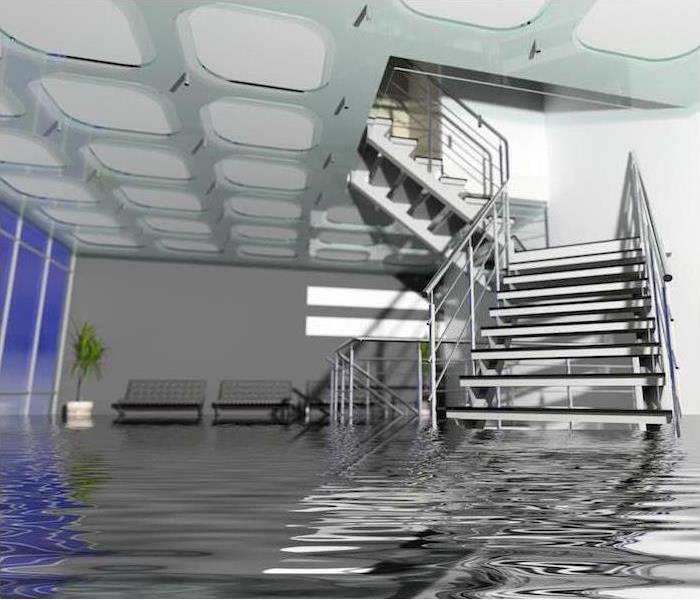 If your business has experienced a flood, we are always here to help. Call us 24/7 to get our team of professionals to your business quickly.
If your business has experienced a flood, we are always here to help. Call us 24/7 to get our team of professionals to your business quickly.
It is not uncommon for business owners to underestimate their flood preparedness, especially if they are not in an area historically known for flooding. However, it was recently reported that natural disasters involve flooding in 90% of instances and affect areas that are not typically known for flooding quite often.
Planning is a smart idea for business owners not only to increase safety within the workplace, but it can also serve to allow businesses to reopen more quickly after the flood passes. By planning ahead, business owners can have the peace of mind to know that they are ready should a flood occur.
How to Practice Flood Preparedness
Some key ways business owners can practice flood preparedness are:
- Make use of the Flood Map provided by FEMA to get an overview of flooding rates in your geographical location.
- Copy business documents and keep them in a secure location such as a waterproof safe or safety deposit box.
- Develop an official training guide for emergencies so employees can be educated and know what to do.
- Designate evacuation routes and mark them clearly.
- Consider adding flood insurance to your business policy, which does not typically include it.
- Create a personal emergency kit for your desk and an office-wide one in case someone is stranded.
- Find creative ways to raise electronics if necessary.
How to Prepare Documents for a Flood
As you begin the process of reopening the business after a disaster, having helpful documents will make the process much easier. Consider preparing and storing copies of the following:
- The continuity plan for after floodwaters recede
- Contact information for all employees, vendors, suppliers and any other parties that might need to be contacted right away
- Your insurance policy records and agent contact information
- Digital file backups and recovery instructions
- Financial documentation that may come in handy
Storm Damage: What are the Causes? SERVPRO of Hamilton & South Trenton
7/20/2021 (Permalink)
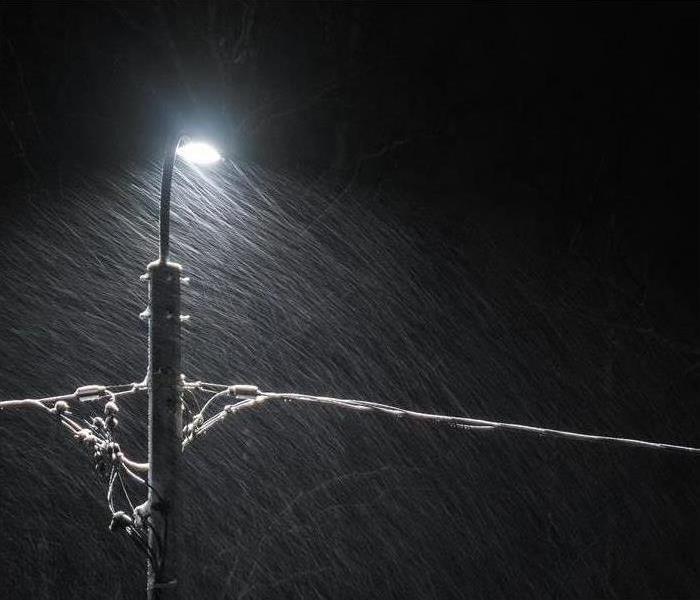 When disaster strikes, we strike back!
When disaster strikes, we strike back!
In the past few months, New Jersey has been experiencing a high level of heavy rainfall. Did you know heavy rainfall and subsequent flooding is one of the common types of damage from storms? There are ten common types of storms and being familiar with them aids in storm preparation and damage prevention.
We know how important it is to homeowners to keep homes safe from storm damage.
The 5 most common storms are:
- Hurricanes
- Tornadoes
- Thunderstorms
- Snow storm
- Hail storms
Since New Jersey is so far north and so close to the coast, it’s very possible that you may experience each of these kinds of events.
The fact is that hurricanes cause damage far past the coast. That storms cause damage is obvious, but the kinds of damage they cause and how is not always known.
Since hurricanes have long-term effects (Hurricane Sandy impacted 24 states), it’s very important to be educated on that type of storm in particular.
Hurricane damage is caused by three distinct but related storm elements: storm surge, floods, and wind.
Storm surge is when water rises far past the predicted tide level. This rise occurs because the wind from the hurricane pushes the water toward the shore, giving it nowhere to go, except up and in. The force of storm surge can be so strong as to destroy buildings and roads.
Storm surge is a direct cause of floods. The extra water from storm surge can reach far inland, causing widespread floods as it goes. Hurricanes can also cause rainfall as far as 100 miles past where the hurricane actually hits. Even tropical storms that don’t reach hurricane level can cause excess rainfall and thus floods.
Wind from hurricanes can reach speeds of 74 mph up to 155 mph. Winds of this speed cause widespread destruction by uprooting trees, downing power lines, and carrying debris and tossing it against other structures, even causing roofs to lift. It’s not unheard of for hurricane winds to form tornadoes.
Storm surge, floods, and winds can cause damage that is far-reaching, unexpected, and overwhelming. You can take precautions by packing an emergency preparedness kit, installing weather-resistant features to your house, and always following official safety orders or directives.
Making Sure Your Family is Prepared for Severe Weather | SERVPRO® of Hamilton & South Trenton
7/20/2021 (Permalink)
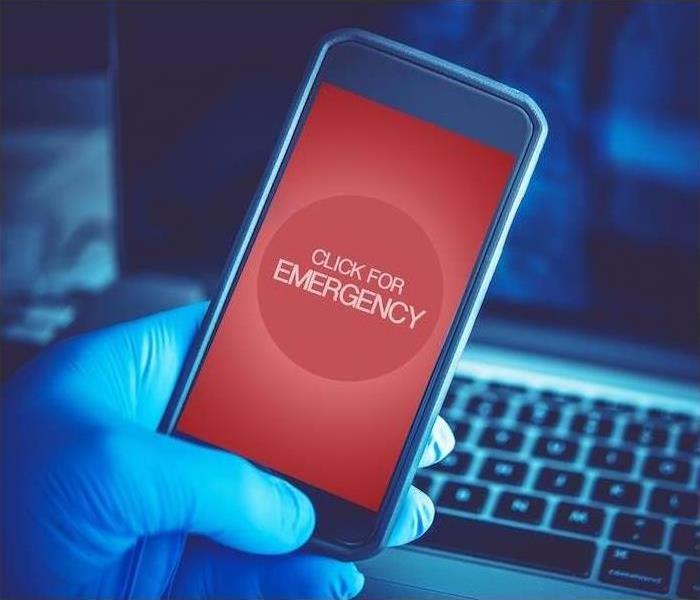 Having a team on your side after a disaster can help relieve stress. SERVPRO of Hamilton, South Trenton is here to help 24/7.
Having a team on your side after a disaster can help relieve stress. SERVPRO of Hamilton, South Trenton is here to help 24/7.
Today, we are fortunate to have advance warning for some types of severe weather, but there are also times where Mother Nature manages to catch us by surprise.
Fortunately, there are steps you can take and safety tips to follow that will guide you in preparing for your family’s safety in various severe weather occurrences.
Where to Start
One of the best ways to ensure your family’s safety is to have an established family emergency plan at the ready.
Be sure to go over your plan together as a family at the beginning of each weather season if there is an emergency plan in place so everyone knows exactly what to do.
Here are some things to take into consideration when creating your family emergency plan if you have not yet done so:
1. How will emergency alerts and warnings be received?
Thanks to technology today, emergency alerts and warnings are at our fingertips with our smartphones that are equipped with a weather app or Google. We can quickly receive emergency alerts, that provide us with valuable time in severe weather situations. Warnings and alerts are also still broadcast over radio and TV.
2. What type of storm shelter do you have?
Where tornadoes are a common occurrence, you’ll want to be in the lowest part of your home, preferably a basement, or if there is no basement, use an interior room on the lowest level that is away from corners, windows, doors and outside walls. Tornadoes aren’t the only weather circumstance that require a form of storm shelter, and you can learn about more of the situations that call for them by visiting ready.gov.
3. What are the evacuation routes?
Have you mapped out multiple evacuation routes because hurricanes, flooding and fires can force you from your home at a moment’s notice. It’s wise to have multiple routes in the event one is impassable, and be sure you find places to stay with your pets along the way if you have furry family members involved in your evacuation.
4. How will everyone stay in touch?
Cell phones are the easiest way to keep in touch with your family, but in some circumstances, that just will not be possible. Cell phone towers can be damaged and phones could be lost or left behind; not to mention batteries will not last forever and there will be no power to recharge them.
Your family should have an emergency communication plan in place as well as a safe meeting place so that you can all meet there if separated.
If a storm does cause damage to your home or business, don’t hesitate to call your friends at SERVPRO® of Hamilton, South Trenton to get the cleanup and restoration process started.
Understanding the Basics of Damaging Winds | SERVPRO® of Hamilton & South Trenton
7/13/2021 (Permalink)
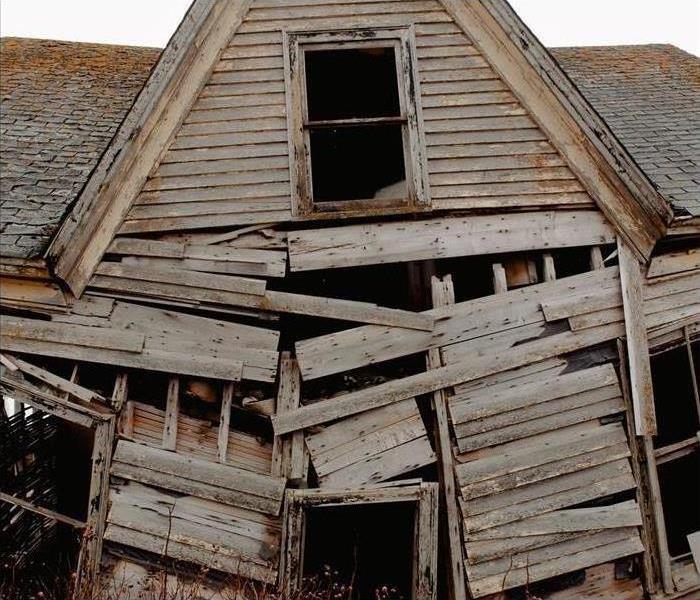 We are available for cleanup & restoration services 24 hours a day, seven days a week.
We are available for cleanup & restoration services 24 hours a day, seven days a week.
Damaging winds are one of the threats that comes with severe storms. These winds can catch you off guard and be problematic due to long-term structural impacts.
Why Damaging Winds Are Such a Major Concern
Tornadoes and hurricanes are not the only times damaging winds occur. Damaging winds are considered winds with wind speeds exceeding 50–60 mph and can be produced by a strong thunderstorm. Often, you will hear damaging winds referred to as “straight-line” winds to differentiate the damage from tornado damage.
The damage from straight-line winds can be especially destructive, often causing unanchored objects to become projectiles. Any windows or roof can take the brunt of this damage. If the damage is extensive, it can result in water damage to the home as outside elements come indoors through broken windows or damaged roofs.
Anyone who lives in a thunderstorm-prone area can be at risk from damaging winds, but there are some structures, such as mobile homes, especially at risk. Mobile homes, even those that are anchored, could sustain serious damage in winds gusting over 80 mph.
Ways to Prepare Your Home
There are a number of things you can do to protect your property from damaging winds, but there are two things to remember, keeping the “Two R’s” in mind: reinforce and remove.
Look into having your garage door reinforced by a professional.
Ensure that any loose objects on your property that could become wind-borne are properly stored or anchored. Remember that trash cans, grills and outdoor furniture are easily picked up by strong winds.
Larger, older decaying trees and branches should be professionally removed, which will ensure they cannot be blown onto your home.
Remember, high winds can occur without advanced notice. By taking some, or all, of the above actions, you can be prepared on a moment’s notice.
Also, if you are building a new home or renovating an older home, be sure windows, walls and doors are up to code for your area.
If your home has been hit by damaging winds and resulting water damage, the highly trained specialists at SERVPRO® of Hamilton & South Trenton are here to help with the cleanup and restoration of your home.
The Dangers of Lightning During Storms | SERVPRO® of Hamilton/South Trenton
7/13/2021 (Permalink)
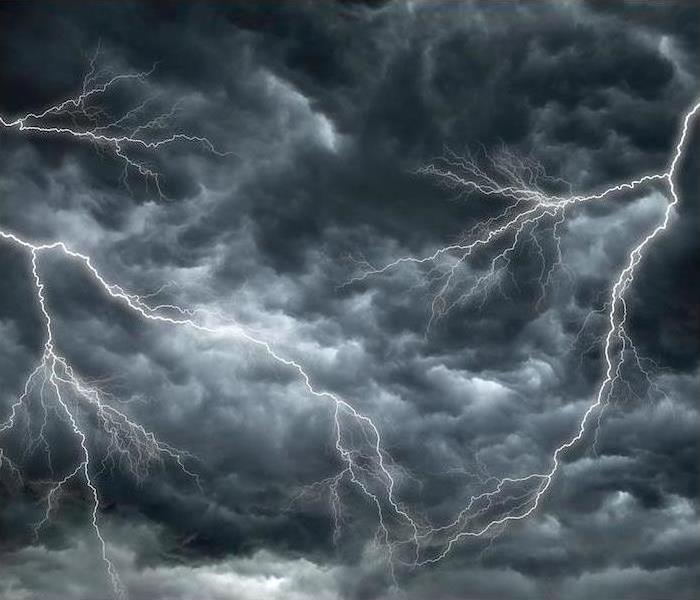 Storm & lightning damage require specialized restoration techniques and equipment. When a storm hits your home, you need the company with experience.
Storm & lightning damage require specialized restoration techniques and equipment. When a storm hits your home, you need the company with experience.
There are many ways in which a thunderstorm can cause damage. Flooding or wind damage are what often come to mind, but it is also important to consider the risks associated with lightning when discussing thunderstorms.
While some storms bring rain and water, every storm is made up of electricity, creating the possibility for lightning even in the absence of precipitation. Lightning bolts can be up to 500,000 degrees, causing damage and even fatalities when they strike. An understanding of what lightning is and how it can be dangerous is extremely helpful in helping homeowners prevent these risks.
How Thunderstorms and Lightning Coexist
All thunderstorms contain the electricity that makes a lightning strike possible. What we know as a lightning strike is actually a rapid burst of electricity that occurs when this charge becomes agitated.
The atmosphere is not an ideal conductor, which is why lightning tends to strike objects—this creates a less resistant route in getting to the ground. When a home is the object that has been struck, lightning will usually forge this path through water pipes and wiring.
How Lightning Is Dangerous to Homes
While there are many dangers surrounding thunderstorms, there are [three main ones involved with lightning striking a house]:
The risk of fire. One of the biggest dangers of a lightning strike to a house is the fire hazard it causes. Lightning is hot enough to ignite building materials, causing a fire to break out at the point of impact. Additionally, lightning traveling through wires can cause them to fray, creating fire hazards all throughout the home.
The risk of power surges. Because of the electrical charge at play with lightning, it can easily transfer that to the wiring in the home. This is what we call a power surge, which can affect any electronic device plugged in that is not routed through a surge protector.
The risk of shock waves. Shock waves are typically manifested in thunder, but they can also occur at the site of a lightning strike. Shock waves have been known to crack chimneys, break windows and explode cinder blocks, making them extremely hazardous to a home’s structure.
If your home has been affected by storm damages or lightning-related fires, give us a call today! We are experts in damage cleanup and can restore your damage quickly.
Taking Water damage Into Consideration | SERVPRO® of Hamilton & South Trenton
7/9/2021 (Permalink)
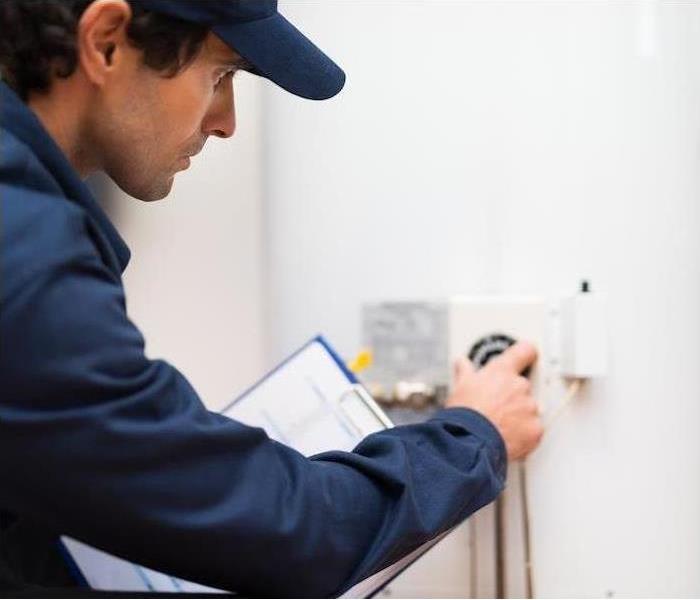 Water damage can be a nightmare to deal with but fortunately, you will always have us.
Water damage can be a nightmare to deal with but fortunately, you will always have us.
Water. Let’s face it—we need it to live—everything needs it! But what we don’t need is for it to be causing damage to our property and our homes.
When it comes to damage caused by water, there are many reasons it happens. How many of those reasons are you aware of?
For the period covering 2009 to 2015, The Travelers Companies Inc. discovered the most prevalent reasons for a filed homeowners insurance claim were:
- Wind damage
- Water damage from sources other than weather
- Hail
- Weather-related water damage
- Burglary
Water damage is so common that it appears on this list twice, in two different categories. To make it simple, remember that it can be classified as non-weather-related and weather-related.
Water damage that is not caused by weather occurs most often in the home and is the result of plumbing and appliance malfunction issues. Water damage caused by weather can cause just as big of headache but does not occur as often. Weather-related water damage is caused by events such as rain, snow or melting ice.
The top five reasons for water damage in the home are plumbing, appliance leaks, water pipe issues, older water heaters and weather.
Water Damage Prevention
While water damage can be pricey, it could be even more pricey if a homeowner is not covered by homeowners insurance. Check your homeowner policy for your coverages. In most cases, damages that are covered in a standard policy are:
- Damages caused by winter weather
- The expulsion of water, even if it is accidental
- Damaged or broken down hot water heating system
- Plumbing that freezes
Fortunately, there are ways to keep water damage from occurring, thereby saving yourself some headaches in the future.
Here are some ideas for preventive maintenance to help you protect your home as much as possible from the damage caused by water:
- Hire a plumber to install back flow valves and standpipes in basement drains.
- Raise your appliances and personal items up off the basement floor.
- Clean all gutters and downspouts.
- Never place grease down the kitchen drain.
When you follow these suggested tips, you just might reduce the probability for any water damage incidents in your home.
Water damage can be a nightmare to deal with but fortunately, you will always have SERVPRO® of Hamilton & South Trenton on your side to help with the cleanup and restoration process.
A Look at Common Causes of Water Damage in Your Home
7/9/2021 (Permalink)
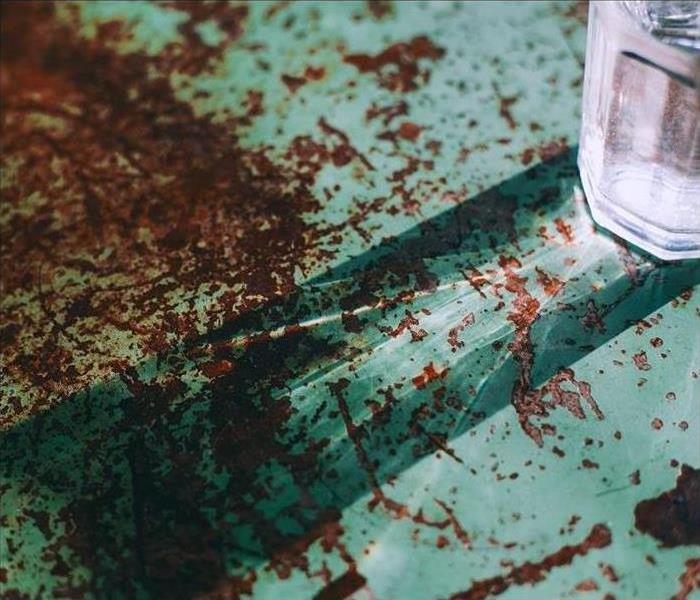 Water damage can happen at any time. We will ensure that each water mitigation job is done correctly and completely.
Water damage can happen at any time. We will ensure that each water mitigation job is done correctly and completely.
Severe weather is usually one of the first things that comes to mind for many when thinking of water damage. It’s true that storms and flooding can cause catastrophic water damage, but they are often not the main culprits. Various items in your home can be the culprits responsible for many water damage situations.
Understanding Water Damage
Many homeowners will face water damage. Water damage was the third most common reason for homeowners insurance claims between 2011 and 2015, with an average payout per claim of $8,861.
Insurance claims are impacted by the type of water damage. Gradual damage, for example, is often not covered by insurance. Gradual damage is something that has been happening over time, such as plumbing issues in the walls causing damage to the walls, ceilings or floors, or water damage caused by cracks in the foundation. Unfortunately, many aspects of gradual water damage are not covered by homeowners insurance, while storm-related water damage usually is.
Common Water Damage Culprits
The Insurance Institute for Business & Home Safety (IBHS), lists the leading causes of water damage as outlined below:
Plumbing drain system failures. These can occur when a sewer drain backs up and overflows into a home or from material performance issues. In their study, IBHS determined that 52% of drain system failures were caused by sewer backups and 37% were related to material performance issues. It was also discovered that the average costs incurred due to drain system failure were higher in southern states than in other areas of the country.
Plumbing supply system failures. Frozen pipes can burst due to water pressure buildup caused by freezing water or when the supply system material fails and results in a leaking or burst pipe. Per IBHS, plumbing supply system failures are the leading source of residential water losses, costing an average of $5,092 per claim after the deductible. Homes with ages of 16 to 40 years made up a larger group of supply system material failure claims.
Toilet failures. Toilets are the second highest cause of residential water damage loss after plumbing supply system failures and result from faulty fill valves to clogged drain lines. Surprisingly, according to IBHS, toilet failures on the first floor of a home resulted in more extensive claims than those in basements or upper floors.
Water heater failures. If your water heater has reached its life expectancy, expect that the tank will begin to rust and corrode, resulting in leaking or bursting issues. IBHS found that 69% of all water heater failures were a result of a slow leak or sudden burst and, on average, cost $4,444 per incident after the deductible has been paid.
Washing machine failures. Typically washing machine failures are caused by supply hose failures, machine overflows and drain line failures. Washing machines are one of the top 10 sources of residential water damage losses. Per IBHS, supply hose failures accounted for over half of all washing machine-related losses.
If your home has experienced any water damage, the team at SERVPRO® of Hamilton & South Trenton is always available to help with cleanup and restoration, making it look “Like it never even happened.”
Getting to Know the 3 Types of Water Classifications | SERVPRO® of Hamilton & South Trenton
7/9/2021 (Permalink)
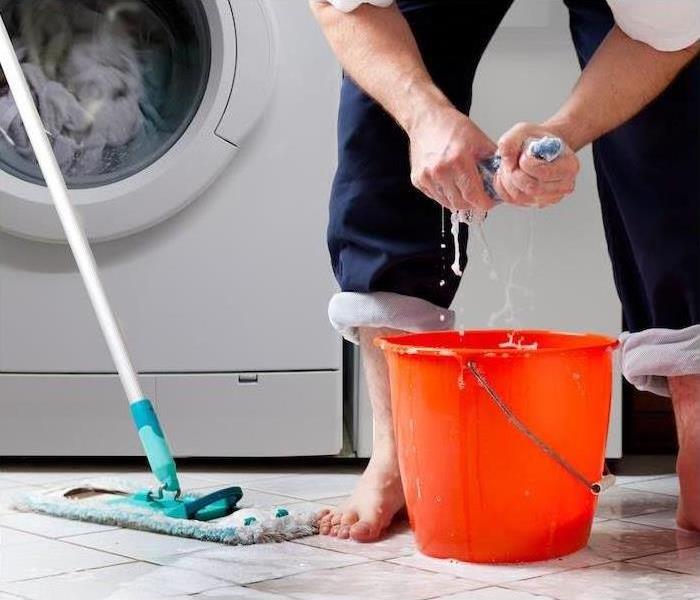 We are available for cleanup and restoration services 24 hours a day, seven days a week.
We are available for cleanup and restoration services 24 hours a day, seven days a week.
If you think all water that causes water damage is the same, think again! There are three classifications for it: clean, gray and black.
By gaining a better understanding of the differences in these types of water, it will help you understand how to better handle a water damage situation.
Whenever there is a water damage situation, it doesn’t matter what type of water has caused damage because a cleanup and restoration process will always follow. First, and most important, is removing all moisture and damp items as quickly as possible to hinder the growth of mold, which begins to flourish in this ideal environment.
Clean Water
The name says it all; clean water is considered “clean” and not likely to be the type that would pose an immediate threat to your health. This water contains no contaminants and is the result of:
- Broken water lines
- Malfunctioning appliances
- Toilet holding tanks
- Snow melt and rainwater
Clean water is the easiest type of water damage to work with because there are fewer microbes living in the water. But remember, it only takes 48 hours and contact with the surfaces of a building for clean water to become a category two, becoming gray water.
Gray Water
Damage from gray water makes water damage cleanup and restoration a bit more serious. This is water that may pose a health risk because it will most likely contain chemical or biological contamination. This slight contamination means that gray water would need to be thoroughly treated before it is safe for consumption.
Water that comes from dishwashers, aquariums, showers, etc. is considered gray water, and the 48-hour exposure time applies here as well, as it will become black water if it is not quickly and property treated.
Black Water
A black water damage situation is considered the most serious of the three classifications as this water is highly contaminated by harmful chemicals and biological matter. This would include floodwaters containing soil and all sewage waters.
Sewage is contaminated with microbes, which include bacteria, protozoans, molds, fungi and more—many of these can cause health effects to humans.
Some of the diseases that can be transmitted by black water are:
- Cholera
- Typhoid
- Hepatitis
- Gastroenteritis-type illnesses
Any water involved in a flooding situation should be considered dangerous and assumed to be black water since it will pick up contaminants along its path.
The Institute of Inspection, Cleaning and Remediation Certification (IICRC), an organization that certifies and sets the standards for the cleaning and restoration industry, recognizes these three classifications of floodwater. Our highly trained technicians have all studied IICRC’s standards and best practices in water restoration and are available to help determine the steps to take to get your home back to normal.
It doesn’t matter what type of water has caused damage to your home or business, we are here to help get the situation under control and make it "Like it never even happened." Don’t hesitate to reach out to us if you need emergency cleanup and restoration services!
Fire Safety Basics to Help Protect your Family | SERVPRO® of Hamilton & South Trenton
7/9/2021 (Permalink)
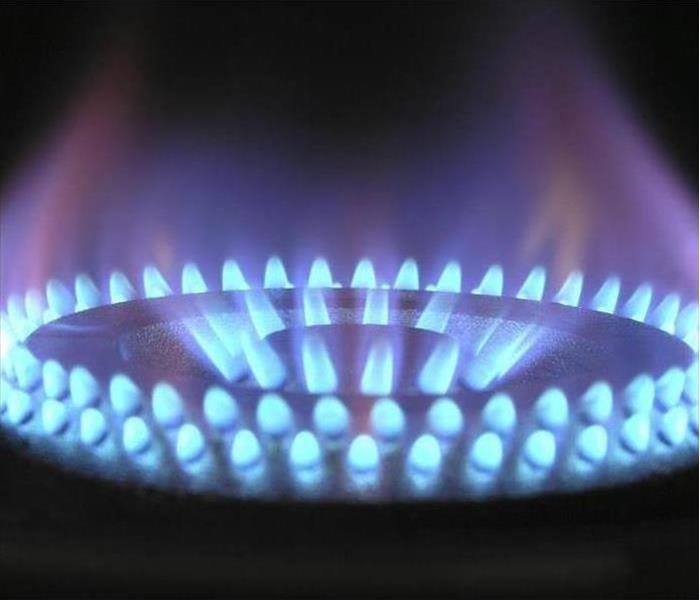 A quick response time with an alert team will assure that your restoration needs are professionally completed.
A quick response time with an alert team will assure that your restoration needs are professionally completed.
Every year in the United States, more than 350,000 house fires happen, adding up to more than $5.5 billion in property damage. Beyond the financial loss, these fires also lead to nearly 3,000 deaths and another 10,000 injuries.
The best defense for your family against a fire is to prepare in advance. That’s why it’s important for every person to know how to prevent fires and how to respond if one occurs.
Start teaching your kids basic fire safety guidelines when they’re young. Let’s also take a look at three other fire safety practices you can practice as a family:
Watch Out for Fire Hazards
Go through your home. You might be surprised how many fire hazards you spot! Take some time and go through every room and your outdoor space to uncover any hazards.
- Ensure your appliances are in good shape.
- Check that electrical cords are in workable condition.
- Do not overload outlets and/or extension cords.
- Check to make sure you are using the correct wattage of lightbulbs.
- Double-check that electrical wiring is not covered up by rugs or carpet.
Creating Your Fire Plan
In the event of a fire, every person in the family needs to know what to do—including how to get out of the house and where to go once they’re out.
But don’t just create a plan and not have practice drills. After all, as the saying goes, “practice makes perfect.” Regular practice of what to do makes you more likely to remember the steps if an actual fire occurs.
Practice Kitchen Fire Safety
Cooking is the biggest single cause of home fires. That’s why it’s important to be especially careful in the kitchen.
Anyone who’s cooking needs to familiarize themselves with basic cooking safety:
- Never cook when tired or unable to pay attention.
- Do not leave kids and teens alone when they cook.
- Always keep a lid at hand when cooking on the stove in case of a grease fire. If a small grease fire occurs, use the lid to smother the fire.
- If a fire occurs in the oven, turn it off and keep the door closed.
- Leave the room and close the door if a kitchen fire occurs and begins to spread.
If your family has experienced a fire and needs help restoring your home, SERVPRO® of Hamilton & South Trenton can help! Give us call to learn about our fire restoration services and what we can do for you.
Window Air Conditioner Leaking Water Into House – What To Check – How To Fix
6/14/2021 (Permalink)
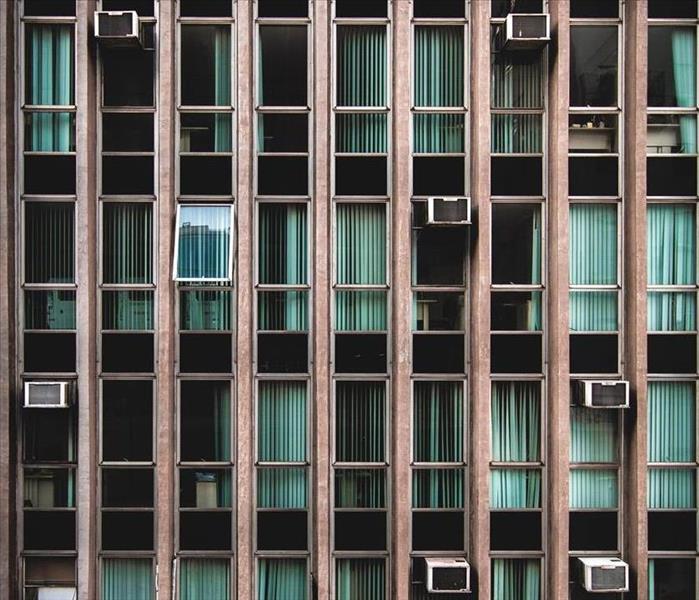 If your home has experienced any water damage, the team at SERVPRO® is always available to help with cleanup and restoration.
If your home has experienced any water damage, the team at SERVPRO® is always available to help with cleanup and restoration.
Question: I just turned my window AC unit on today and it is leaking water inside my house. What could be the problem? I had it running for 3 weeks and all of a sudden it started to leak. Water is on the plastic vent where the cold air blows out. I believe that is where it is leaking from but not sure. Can you tell me how to fix this?
ANSWER: You need to check a few things to be sure the ac unit is installed properly and there is no water drainage block present.
– Unplug the window AC unit.
– Clean up all the water on the AC unit, on the window ledge, and on the floor of your room.
– Check and be sure the AC is tightly sealed in the window.
– Do you feel warm air coming into the room around the AC unit?
– If you feel warm air coming in you need to seal it again.
– Check to see if the drain holes on the rear of the ac unit are blocked.
– Clean the drain holes to allow water to drip out.
– Make sure the filter is clean and not clogged with massive dirt or dust.
– After cleaning up the water and having it turned off for 30 minutes or so, then turn it back on to make sure the water doesn’t appear again.
Here are the reasons water can drip from a window air conditioner unit:
AIR LEAK – AIR CONDITIONER NOT PROPERLY SEALED IN WINDOW:
If your window air conditioner is not sealed correctly, the warmer air from outside gets inside the air conditioner. When this happens, the moisture that is in the warmer air will be condensed by the colder air inside the air conditioner. When there is excess moisture, the water will leak.
DRAIN IS BLOCKED – DIRT OR DUST HAS BLOCKED THE DRAIN HOLES:
There are drain holes (drip pan) at the rear of window AC units. They can get blocked from dusty conditions or dirt in the air. When this type of blockage happens, the water that would normally drip out will be trapped and water will leak from the front of the AC unit and at both sides of the unit. Be sure to keep the drain holes clean and free of debris. Also clean the filters or replace them to prevent any type of blockage that may cause a water leak.
OUTSIDE TEMP IS LOWER – HEAVY MOISTURE IN OUTSIDE AIR:
If it is raining or there is heavy moisture in the air outside, water evaporates much less than usual. This leads to excess water moisture in the air conditioner and this will cause water leaks. This is normal for most window AC units and using a drip pan can solve the issue if there is heavy moisture in the air outside.
CONDENSER PUMP NOT WORKING – BROKEN OR CLOGGED PUMP:
If the condenser pump in the AC is faulty or clogged, it will cause water to leak. You can check the condenser/pump if you feel confident. Check for any blockage or loose wires. If the pump seems to be okay visually, you will need to test the pump with a meter to see if it is faulty. If so, you may be better off buying a new AC unit.
If your home has experienced any water damage, the team at SERVPRO® is always available to help with cleanup and restoration, making it look “Like it never even happened.” Contact us at 908.650.8611.
What to Do When Hoarding Is Discovered | SERVPRO® of Hamilton & South Trenton
6/8/2021 (Permalink)
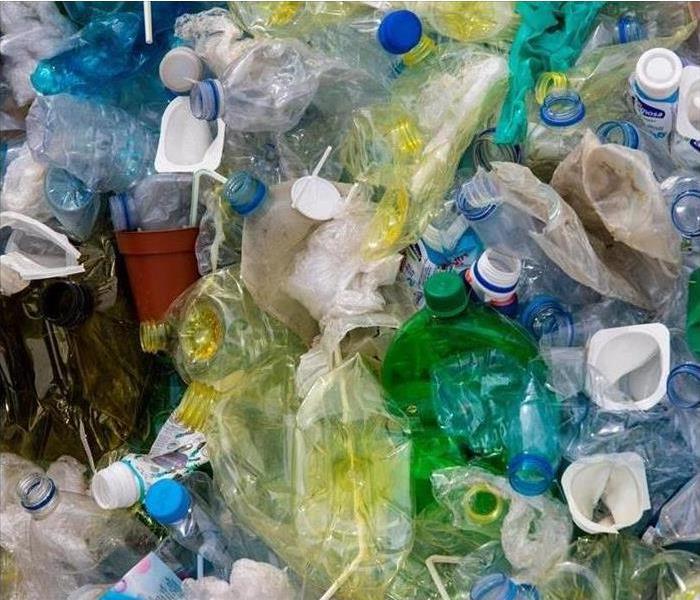 In need of a team to help restore a space where hoarding has been an issue? Contact our team at 908.650.8611.
In need of a team to help restore a space where hoarding has been an issue? Contact our team at 908.650.8611.
Have you ever heard about hoarding? It’s a dangerous mental disorder that can make household dangers, including fires, more likely.
So, what is hoarding exactly? Hoarding is a mental illness that causes people to obsessively hang on to possessions, ultimately accumulating them in large quantities that can take over a home. Those affected by the disorder are rarely hoarding things of any value—trash and other clutter are common.
As these items pile up over time, they can present fire hazards, house insects or rodents, or even hide toxic mold growth.
So, if you you need to clean out a space where hoarding has been taking place, what should you do?
Step 1: Call in the professionals, who can clean up the space and ensure the area is safely rehabbed for future use.
What Is Involved in Hoarding Cleanup
There’s more involved in hoarding clean-up than simply clearing out the hoarded materials and washing the space. A professional team will provide a comprehensive cleanup process that mitigates any safety hazards that have cropped up.
Removal of Dangerous Substances
Piles of hoarded materials can conceal any number of health hazards, including toxic mold growth, along with insects, bacteria, and other pests.
A team of professionals educated in safe removal principles and outfitted in the appropriate gear will help ensure this step is done comprehensively and safely.
Removal of Items
When you think of cleaning up after hoarding, this is probably the step you think of. This involves clearing the space of hoarded materials, including items like newspapers and even trash that has collected over time.
Other items like carpets, furniture, and kitchenware, may also have been contaminated and need to be removed.
Complete Cleaning
Once the space is cleared of all debris and clutter, a professional team will deep-clean the area. This is the last step in the process and helps ensure the property is ready to be used again.
In need of a team to help restore a space where hoarding has been an issue? Contact our team at SERVPRO® of Hamilton & South Trenton, and we’ll make it "Like it never even happened."
An Introduction to Mold Remediation | SERVPRO® of Hamilton & South Trenton
6/7/2021 (Permalink)
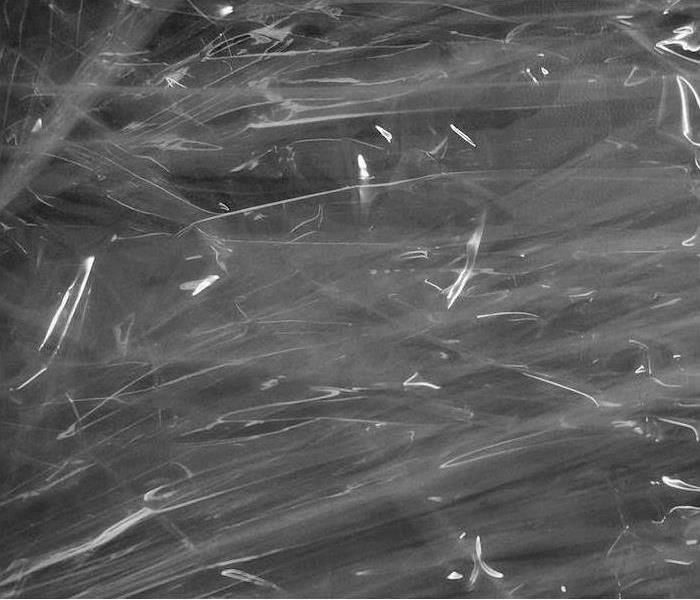 We will ensure that each mold remediation job is done correctly and completely. Give SERVPRO of Hamilton & South Trenton a call.
We will ensure that each mold remediation job is done correctly and completely. Give SERVPRO of Hamilton & South Trenton a call.
When there is water damage in a home or commercial property, mold growth will likely follow. Mold can begin to grow within 48 hours after moisture exposure.
If you are ever facing a mold issue, knowing what steps to take is very important, which is why we have chosen to use this blog to discuss the subject of mold remediation.
Mold Remediation, Not Removal
Mold remediation and mold removal ads are everywhere, and you’ve probably seen ads for these services, but the truth is there is no such thing as mold removal. Removing all mold from a home or business is simply impossible. Instead, a qualified restoration company focuses on mold remediation, which in turn brings mold levels back to a normal and natural level.
Mold spores occur naturally almost everywhere, both inside and outside. The issue arises only when a minor mold problem is left untreated and then turns into a major mold issue.
During mold remediation, the contaminated areas will be isolated by technicians. Depending on the amount of remediation required, this would be done by either closing all doors and windows or sealing off all doorways and openings with polyethylene sheeting. The technicians will use a method called “misting” to suppress the dust in the contaminated areas.
Materials that are wet and mold-damaged are removed and discarded in plastic bags. Any areas that have been exposed to and affected by the mold are then thoroughly cleaned and dried. A HEPA vacuum may be brought in at sometime during the remediation process to help remove contamination and debris.
Then, the mold-affected area is treated with a biocide and left overnight to start killing the mold spores. The following day, the mold remediation crew will return and encapsulate the affected area and beyond.
When to Contact a Professional
If you believe your home or business may have been affected by mold, you’ll want to act quickly. Upon evaluation of the size of the problem, and if the moldy area is more than 10 square feet, you will want call in the professionals.
The professionals you hire for mold remediation should be highly trained and certified in areas such as:
- Applied microbial remediation
- Water damage restoration
- Applied structural drying
While some minor mold issues can be successfully resolved by home and business owners on their own, it is always safest to talk to professionals and get the remediation process started quickly before further damage sets in.
At SERVPRO® of Hamilton & South Trenton, our mold damage specialists are trained and certified experts in mold remediation. If your home or business is experiencing a mold issue, contact us to begin the mold remediation process.
Understanding Thunderstorm Damage | SERVPRO of Hamilton & South Trenton
6/7/2021 (Permalink)
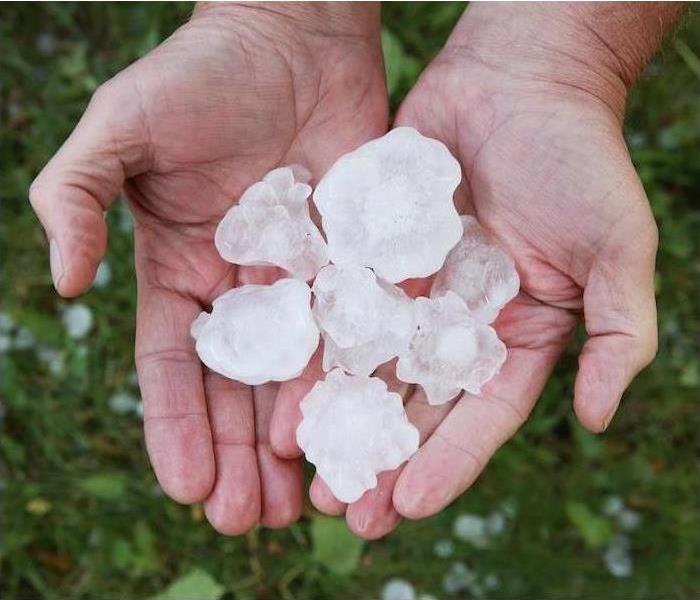 If a thunderstorm has resulted in damage to your home or business, know our team is available 24/7 to help with cleanup and restoration.
If a thunderstorm has resulted in damage to your home or business, know our team is available 24/7 to help with cleanup and restoration.
Thunderstorms are a regular occurrence during the warmer spring and summer seasons, bringing along the risk of damage to your property.
Thunderstorms come in varying levels of intensity. Do you know what those are?
Understanding Thunderstorms
Across the world, an average of 16 million thunderstorms occur each year. The U.S. can see upward of 100,000 thunderstorms annually, with an estimated 10% earning severe status.
Thunderstorms need certain conditions to be met in order to form. Moisture and rising unstable air are required, along with a “lifting” mechanism, which could be things like hills or mountains that force air to rise, or where warm/cold or wet/dry air bump together, causing that rising motion.
There are three stages in a thunderstorm’s life cycle. Those are the developing stage, the mature stage and the dissipating stage. It is during the mature stage that things like hail, strong rain, lightning, high winds and tornadoes are most likely to occur.
Common Types of Damage
Thunderstorms can prove dangerous in many different ways, but an extremely serious threat stems from the possibility of seeing flying debris due to high winds.
During severe storms, wind can see speeds in excess of 57.5 mph, and that is certainly high enough to result in damage to your property.
Even the most unexpected items could reach projectile status during a high wind situation. A smart thing to do is make sure you have scouted your yard for items that could turn dangerous, such as tree branches, lawn furniture, and fencing, and then taken steps to secure them before a storm comes into town.
Besides wind damage, thunderstorms can also produce these types of damage:
Lightning damage. Not only can lightning strikes cause a fire, they can also wreak havoc on your electrical systems. Since a lightning strike can pass through the wiring of your home, it can lead to the damage of anything plugged in.
Tornado damage. With wind speeds that can reach as high as 200 mph, tornadoes are especially destructive. They are able to cover a large area and do their damage in a limited amount of time.
Hail damage. Believe it or not, hail damage can top out around $1 billion a year. Small hail can damage crops throughout the country, while larger hail can damage vehicles, roofing and windows.
Flood damage. Rain almost always accompanies a storm, so it should not come as a surprise that heavy rains can turn into flood danger. Flash flooding can have the strength to rip trees out of the ground and sweep items and structures away.
How We Approach Restoration Differently | SERVPRO® of Hamilton/South Trenton
6/4/2021 (Permalink)
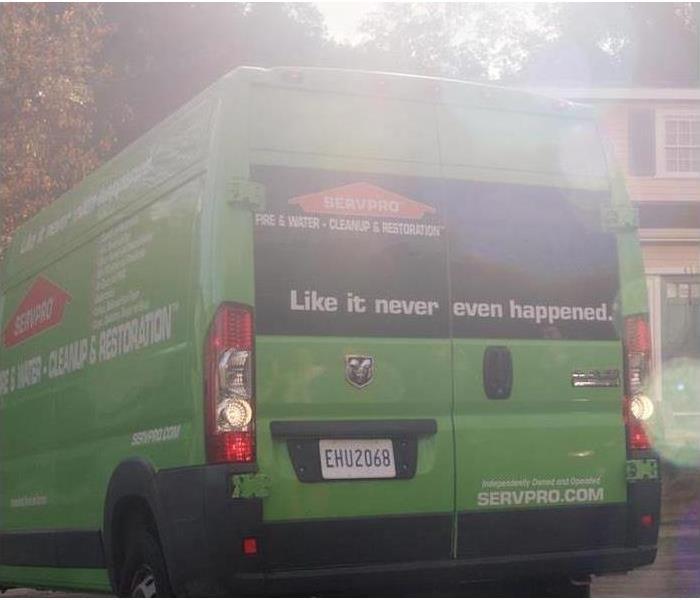 If you have experienced storm damage, we are always here to help! Call our restoration experts 24/7 so we can address your damages quickly.
If you have experienced storm damage, we are always here to help! Call our restoration experts 24/7 so we can address your damages quickly.
There is a lot that goes into choosing a restoration company as a homeowner. Not only are you picking someone to restore your home, but you are also forced to make a big decision during a stressful time in life. Choosing the right company will give you peace of mind and make your experience a positive one, but it’s important to pick one that is trustworthy.
Because there are so many types of damages that can occur from a disaster, it is important to choose a company that can handle a variety of situations.
When water damage turns into structural damage or a small kitchen fire releases toxic soot particles into the air, homeowners will want a company that can handle the entire situation. Seeking a company that can handle complications is essential for a positive experience.
Our Approach to Restoration
Our restoration jobs are just as much about providing excellent service as they are restoring your home. These are the ways in which we approach restoration differently:
With a Guaranteed Quick Response Time
Emergencies do not have respect for anyone’s schedule, which is why we do not have business hours. Our emergency service line is an around-the-clock service, meaning you can call us 24 hours a day to report the damage. Once we receive the call, our technicians will spring into action in order to get to you ASAP.
With an Experienced Team
Our restoration technicians are industry leaders with proven results. Trained according to IICRC standards, they will ensure the most up-to-date methodology is used in your restoration for any type of damage.
With a National Network
Our franchise locations are located across the country with over 1,800 locations. This means that we have a national network to utilize for resources. Therefore, we can treat a large-scale disaster with the same care and efficiency as we would an isolated spot of thunderstorm damage.
If you have experienced storm damage, we are always here to help! Call our restoration experts 24⁄7 so we can address your damages quickly.
Can You Identify Common Fire Hazards in Your Home? | SERVPRO of Hamilton/South Trenton
6/4/2021 (Permalink)
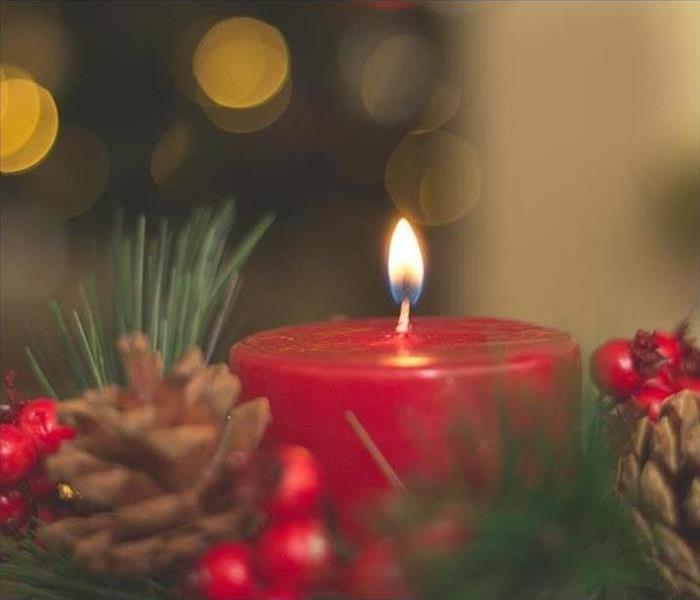 If your home is damaged by fire or smoke, we are here to help restore your home to pre-fire condition.
If your home is damaged by fire or smoke, we are here to help restore your home to pre-fire condition.
Nobody wants to think about the possibility of their home being damaged by fire, but it’s an unfortunate, harsh reality for a multitude of Americans.
One way you can help protect your home is to understand fire hazards and know how to identify them. In this blog, let’s dive into two of the most common causes of household fires.
Candles are a common fire hazard.
According to the National Fire Protection Association, over a five-year period from 2011 to 2015, fire departments across the United States answered an estimated 8,700 house fires a year that were caused by candles.
In total, these fires caused 82 deaths, 800 injuries and $295 million in property damage. Candles were the cause of 2 percent of reported house fires, of which 3 percent resulted in death and 7 percent resulted in injuries.
An average of 24 home candle fires per day were reported during those five years, with December having the highest month of incidents. Out of all the candle fires during this time period, 37 percent started in the bedroom and were responsible for 36 percent of the associated deaths and 51 percent were associated with injuries.
When using a candle, be sure it’s kept at least one foot away from anything that could possibly ignite and that it is in a sturdy holder that will not easily tip over. It is never wise to use a candle where oxygen is in use in a home. And you always want to ensure that all candles are properly extinguished before leaving a room or going to sleep.
House fires from smoking can be lethal.
While cooking is the leading cause of house fires, smoking is the main cause of home fire deaths. Approximately 17,200 house fires were reported in 2014 due to smoking, which includes cigarettes, pipes and cigars. Those fires resulted in 570 deaths, 1,140 injuries and $426 million in property damage, according to the Coalition for Fire-Safe Cigarettes.
If you’re a smoker, it is smart to smoke outside, as most deaths result from fires that started in living rooms, family rooms or bedrooms. Fire-safe cigarettes are the best option, and using a deep, sturdy ashtray is advised.
Drop all lit cigarettes and ashes in water or sand prior to throwing them out—and remember that one out of four fatal victims of smoking fires is not the smoker whose cigarette started the fire.
Dust bunnies as fire hazards?
While candles and smoking are well-known causes of home structure fires, were you aware that some glassware in your home could be a fire risk? When sunlight passes through them, the concentrated ray may ignite flammable materials. It’s best to keep glass accessories away from windows and out of direct sunlight.
Dust bunnies can also pose a fire risk when they collect near electrical sockets and floor heaters. Regular sweeping or vacuuming regularly and cleaning hard-to-reach areas like behind entertainment systems can help prevent buildup.
Also, look for loose outlets in your home. The movement of these outlets loosens the wires connected to the outlet and could create dangerous arcing.
Does Your Business Have a Natural Disaster Plan? | SERVPRO® of Hamilton/South Trenton
6/3/2021 (Permalink)
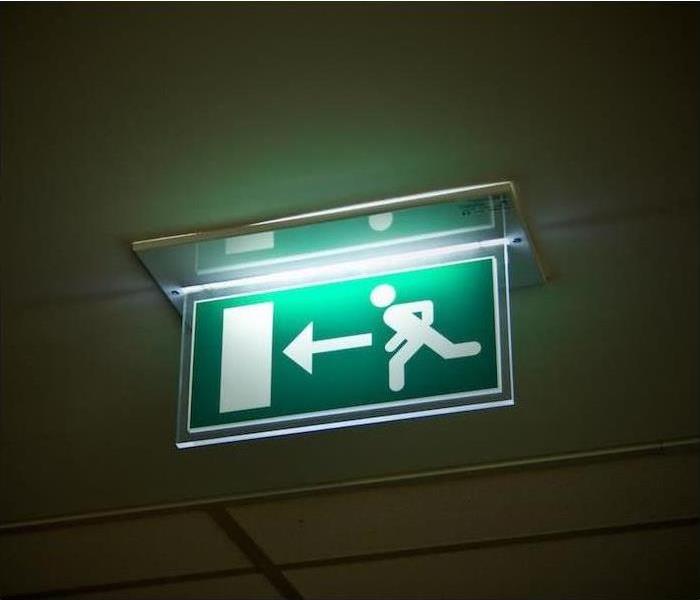 A quick response from SERVPRO of Hamilton/South Trenton ensures your Damage Restoration needs are professionally completed.
A quick response from SERVPRO of Hamilton/South Trenton ensures your Damage Restoration needs are professionally completed.
Would your business be prepared to face all that Mother Nature can throw at it through floods, hurricanes, tornadoes, wildfires and earthquakes? The most important key to surviving these natural disasters is to be prepared for these situations.
Being prepared for these situations involves creating a natural disaster plan for your business. This blog will lay out some aspects to consider when designing that very important disaster plan.
Where to Start With Your Disaster Plan
There are many things you will need to consider, including your employees, your material assets and equipment, when developing a disaster plan for your business.
Some of those considerations should be:
- How to protect your employees
- How to secure your assets
- How to get business up and running again
Many checklists have been made available through sources like the Red Cross, FEMA and Ready.gov that can offer information that will help you identify areas that need to be included in your natural disaster preparedness plan. These sources will also help you see just how prepared you truly are.
Don’t Neglect Employee Safety
If a disaster should strike without warning, your plan must lay out clear and concise procedures and safety measures for the protection of your employees and visitors. Your evacuation routes and exits from your facility should all be properly and clearly marked, have an area designated that will serve as a shelter space, consider emergency light installation, and ask for volunteers to serve as designated “safety wardens” properly trained and ready to guide and assist with all emergency efforts.
When choosing a place for shelter, ideally this space would be a basement or storm cellar in the event of tornadoes or other high-wind situations. If there is no basement available, select a small interior room on the lowest level of the building, such as a closet or interior hallway.
How to Protect the Assets
In a brick and mortar location, you’ll still need to make careful decisions when it comes to protecting the assets inside the building. You have thousands of dollars tied up in equipment and/or merchandise that will be at risk should a natural disaster strike.
Be sure to have a complete and up-to-date inventory of all equipment and assets. Having photographs prior to a disaster whenever possible is also always helpful if insurance claims need to be made. If your assets are computer data-based and kept on a server, take the steps necessary to ensure that the backup system is making regular backups and that the storage system cannot be damaged, such as a cloud storage option.
If you own the building that you conduct your business in, get with a contractor to uncover areas that could be structurally strengthened. This contractor should be able to suggest possible safety upgrades and advise on any areas that may not make the grade in certain weather situations.
Getting Back to Business
When—and if—a natural disaster does occur, it may be entirely possible that your business will have to be closed for days or months due to the damage incurred. And every day you remain closed is another day of lost profits. It is wise to set up a disaster fund to help cover any additional costs that are not covered by your insurance.
Keep a list of contractors handy who will make themselves available for repairs, and know which cleanup and restoration service will be available to quickly respond to your emergency situation.
With SERVPRO® of Hamilton/South Trenton, you can count on us to get to the disaster faster and make it "Like it never even happened." Our training and expertise have prepared us to help with water damage, storm damage, fire damage and mold remediation quickly and effectively.
Knowing what to do when disaster strikes your business is of the utmost importance. When it comes to the cleanup and restoration aspects, depend on us to be there for you.
Ways You Can Prevent Mold Growth After Water Damage | SERVPRO® of Hamilton/South Trenton
6/3/2021 (Permalink)
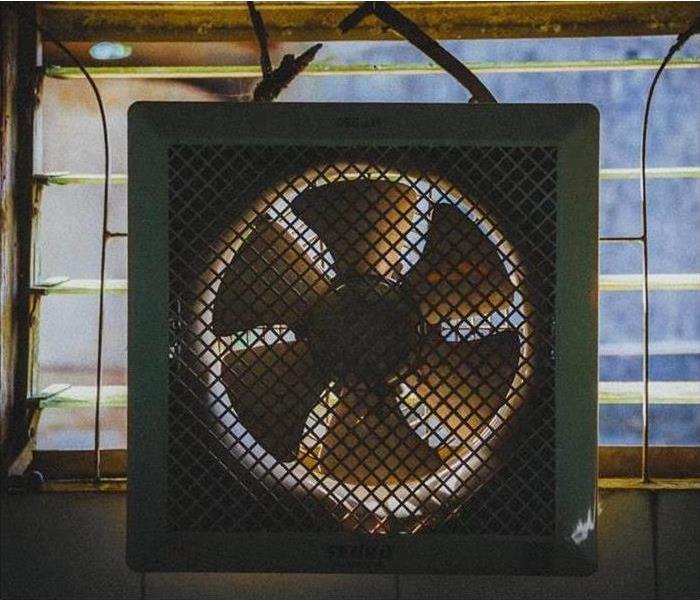 If you’re worried about cleanup associated with water damage and mold growth, we can help you restore your home and remediate any mold issues.
If you’re worried about cleanup associated with water damage and mold growth, we can help you restore your home and remediate any mold issues.
Water damage is difficult for home and business owners—not only because of the structural damage it can cause but also because of the unique health hazards and risks it can present.
One of the most dangerous of these risks is mold growth. The CDC has many health effects associated with mold exposure that are well-documented, and the problem is exacerbated because of how quickly mold can begin growing.
Here are the steps you can take to stop mold from taking hold if your home has been affected by water damage:
Before You Get Started
- Do not attempt to re-enter your building until officials have deemed it safe and are positive all water has receded.
- Take photos and videos of damage throughout—making sure to include damage done to furniture and walls—for insurance claim purposes.
Drying Should Begin Right Away
- Set up as many fans, dehumidifiers and heaters as possible to speed up drying time.
- Begin vacuuming with a heavy-duty, outdoor vacuum before the cleanup crew arrives.
- Weather permitting, open windows and doors to maximize airflow for as long as possible.
Items Exposed to Water Should Be Sorted
- Metal, plastic glass and other non-porous materials can often be cleaned, disinfected and reused.
- Porous materials exposed to water damage, such as wood, upholstery and paper of any kind, can trap mold and should be discarded.
- It is important to note that drying carpet will not necessarily remove mold spores if they’ve already begun to grow.
A Professional Should Always Be Consulted
In some cases, carpets can be salvaged after water damage. However, most experts will recommend replacing the carpet pad at a minimum.
Mold is incorrectly associated with discolorations and foul odors when the reality is that mold can often lurk unnoticed long before it is visible. Replacing the carpet pad is significantly less costly than a full re-carpeting of the home, but only a professional can determine if this is adequate enough to prevent mold from spreading.
Why Choose SERVPRO? Because of Our Highly Trained Restoration Specialists.
4/9/2021 (Permalink)
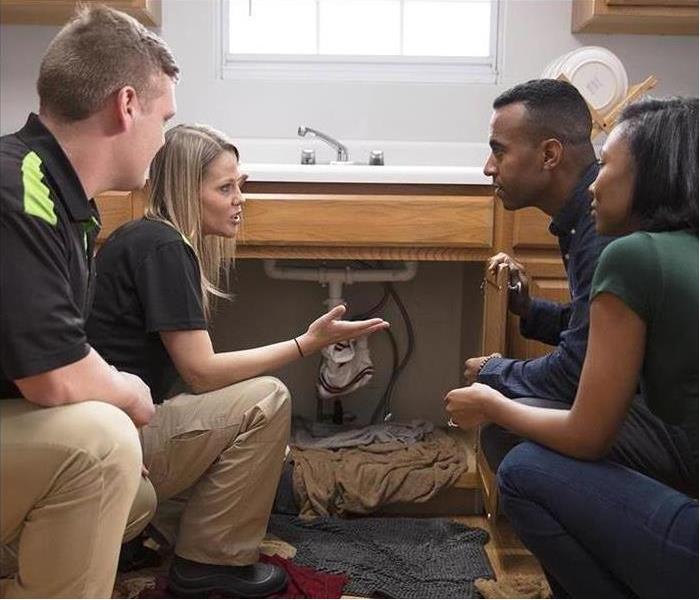 Contact us for all of your residential and commercial restoration and cleaning needs.
Contact us for all of your residential and commercial restoration and cleaning needs.
Our staff is highly trained in property damage restoration. From initial and ongoing training at SERVPRO’s Corporate Training Facility to regular IICRC industry certifications, rest assured our staff is equipped with the knowledge to restore your property.
Our training program includes the following:
- IICRC Training
- Employee Certification Training
- Initial Franchise Training
- e-Learnings
- Continuing Education Classes
IICRC Training and Certification
The Institute of Inspection Cleaning and Restoration Certification (IICRC) certifies and sets the standards for the cleaning and restoration industries. Our Professionals study IICRC standards and best practices in water restoration, fire restoration, mold remediation, carpet and upholstery cleaning, and other cleaning and restoration courses.
Employee Certification Training
The Employee Certification Training is a voluntary, self-paced program designed for our employees. Certification is awarded after successful completion of course materials and an examination. Modules include:
- Crew Training
- Fire Restoration
- Water Restoration
- Carpet & Upholstery Cleaning
- Initial Franchise Training
- e-Learnings
Continuing Education
Our employees participate in ongoing education through web-based training. This program is designed to be an ongoing, self-paced coaching series for our employees. Video presentations and support materials are followed by a knowledge test at the end of each module. This keeps our technicians and office staff up to speed on industry standards and the professional quality you expect.
Our highly trained staff is ready 24 hours a day, 365 days a year to handle any type of disaster.
Learn More About Our “Restore First” Mentality
4/9/2021 (Permalink)
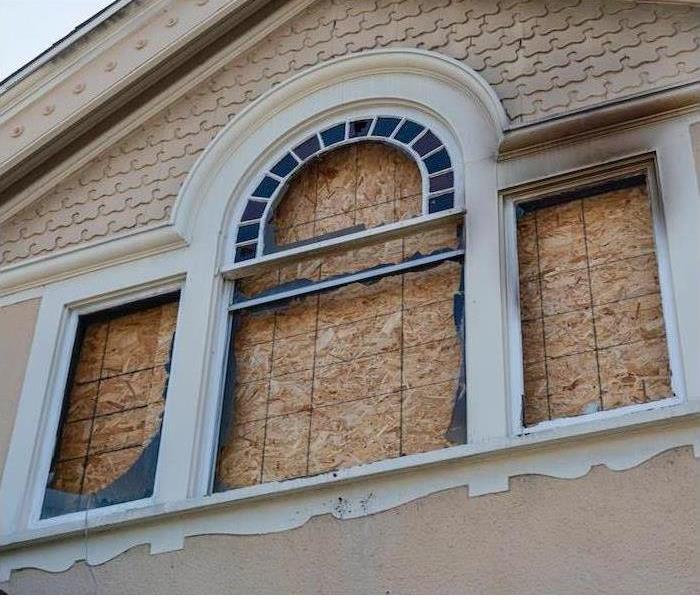 Our team of highly trained restoration experts are available for emergency cleanup and restoration services 24 hours a day, seven days a week.
Our team of highly trained restoration experts are available for emergency cleanup and restoration services 24 hours a day, seven days a week.
When disaster strikes, we get there fast, but that is not the only reason why we need to be first on your list of calls if the worst should occur.
What sets us apart—our team of technicians have a “restore first” mentality, complemented by specialized equipment and cleaning techniques. By making this our mission, we are able to minimize potential disruptions to your home and life and get you back into your home as quickly as feasible.
How It Works
When a fire has damaged your property, it’s a scary time, but once you reach out to our team, we’ll take some of the weight off your shoulders.
No two fires act the same, so it’s logical that the damage they inflict would also be different. That’s why we believe in starting with a standardized process, but adding onto it and enhancing it to meet your individual needs.
1. You call us. When you reach out via our 24⁄7 Emergency Line, we will spring into action. Our first step is to ask you questions about the fire and your home’s unique space and needs. That set of questions helps inform our strategy.
2. We inspect and assess the fire damage. Our next step is to visit your home. During this visit, we will inspect and test adjoining rooms of the property to determine the extent of fire, smoke and soot damage. Based on what we see and determine, we will take immediate next steps.
3. We board up windows and tarp the roof. Because fire damage often compromises windows, walls and roofs, we will make sure that your property is secured and protected from further damage. This will involve boarding up missing windows and walls and placing a tarp over the top of damaged roofs.
4. We remove water and begin the drying out process. When we think of fire, we don’t think of water damage. But we should, because water is a necessary component of fighting fires. So our next step is to remove any standing water and start drying out objects and spaces when possible.
5. We remove smoke and soot from all surfaces. We use specialized equipment and techniques to remove smoke and soot from ceilings, walls and other surfaces in your home.
6. We clean and sanitize your home. This is another place where the “restore first” mentality comes into play. We will attempt to clean objects and surfaces whenever possible, rather than removing and replacing them. We also use industrial air scrubbers and fogging equipment to help remove odors.
7. We complete the restoration. This is our final step, bringing your property back to the condition it was in before the fire. Restoration may involve minor repairs like replacing drywall, painting and installing new carpet. It could also involve major repairs like reconstruction of damaged areas.
Faster to Any Size Disaster
3/22/2021 (Permalink)
 We are proud to serve our local communities. Contact us at 908.418.4053 for all of your residential and commercial restoration and cleaning needs.
We are proud to serve our local communities. Contact us at 908.418.4053 for all of your residential and commercial restoration and cleaning needs.
As a locally owned and operated business, we live and work in this community too. We are close by and ready to respond immediately when you need cleaning or restoration services. We’re also part of a national network of over 1,800 Franchises, which allows us to respond quicker with more resources. For major storms and disasters, we can even call upon special Disaster Recovery Teams for additional resources.
Residential Services
Whether your home has suffered flood damage or you just want your upholstery cleaned, we are ready to help. SERVPRO of Central Union County & SERVPRO of Roselle technicians are highly trained to properly clean and restore your house so that it feels like home again. You can depend on us for these residential services:
- Water Damage Restoration
- Fire Damage Restoration
- Mold Remediation
- Storm Damage Restoration
- Cleaning Services
- Building Services
Commercial Services
Fire and water damage can interrupt your business operations in an instant without notice. An unexpected period of lost productivity and revenue can be devastating. SERVPRO of Central Union County & SERVPRO of Roselle has the training, equipment, and resources to get your commercial property back to business quickly. Learn more about our commercial services:
- Commercial Water Damage Restoration
- Commercial Fire Damage Restoration
- Commercial Mold Remediation
- Commercial Cleaning Services
- Commercial Storm and Major Events
We are proud to serve our local communities. Contact us at 908.418.4053 for all of your residential and commercial restoration and cleaning needs.
Contact SERVPRO for HVAC Maintenance to Keep Units Running Efficiently
3/22/2021 (Permalink)
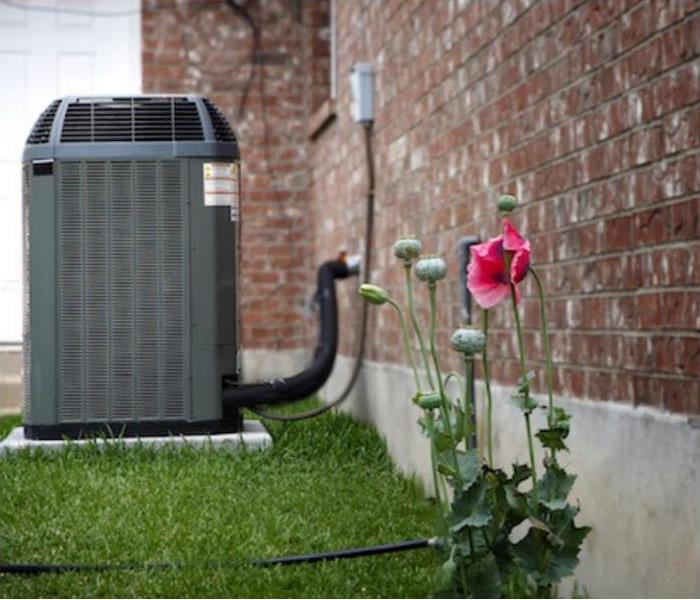 If you’d like to schedule a consultation to discuss HVAC cleaning, contact us at 908.418.4053.
If you’d like to schedule a consultation to discuss HVAC cleaning, contact us at 908.418.4053.
Everyone who owns a home appreciates the comforts of an efficient central heating and air system, but there’s a large investment associated with operating them. Did you know that about half of the energy costs for a home are due to the heating and cooling system according to Energy Star? While that’s a significant chunk of change, just a little bit of maintenance can make the investment extend much further.
It’s important to catch problems with your HVAC system before they become serious: that’s where routine maintenance comes in.
Homeowners should educate themselves about how their HVAC system works to provide it with the best care.
- Swap your filters. Your HVAC filters need to be changed between every 30 and 90 days (depending on the type of filter used) for maximum air quality and efficiency. Other ways to improve heating and cooling include using the highest efficiency filter for your HVAC model and ensuring a properly secured fit when filters are installed.
- Reduce your dust. Simply keeping up with routine dusting and vacuuming will clear the dust and debris out before it has a chance to invade your air flow system, doing wonders for your HVAC cleanliness. Further the benefit by always using the highest efficiency filter for the vacuum, and purchasing one with a HEPA certification if possible.
- Check your drainage. As the AC runs, cooling coils work to remove water from the air and drain it away. If the moisture collected is not properly drained, water damage can occur and lead to mold growth. Regularly check drain pans and nearby surfaces for moisture accumulation to stop large problems before they start.
Tip: If you’re doing construction or renovations in the home, seal off supply and return registers in the house.
- Schedule regular maintenance checkups and cleaning. There’s no substitute for having a professional survey your system twice per year. While there are quite a few things homeowners can do to maintain their HVAC system, a professional cleaning can have a marked improvement in air quality and the efficiency of your unit.
If you’d like to schedule a consultation to discuss HVAC cleaning, contact us at 908.418.4053.






 24/7 Emergency Service
24/7 Emergency Service
























































































